Zobrazení pro čtení
‘Tchia’ Turns Into Animals & Objects to Explore a Tropical Island
Tchia takes us on a stunning tropical open world adventure where you play as a young, imaginative girl who can turn into animals and objects to explore. Tchia, our protagonist, is looking to...
The post ‘Tchia’ Turns Into Animals & Objects to Explore a Tropical Island appeared first on Indie Games Plus.
Unknown 9: Awakening release date now known
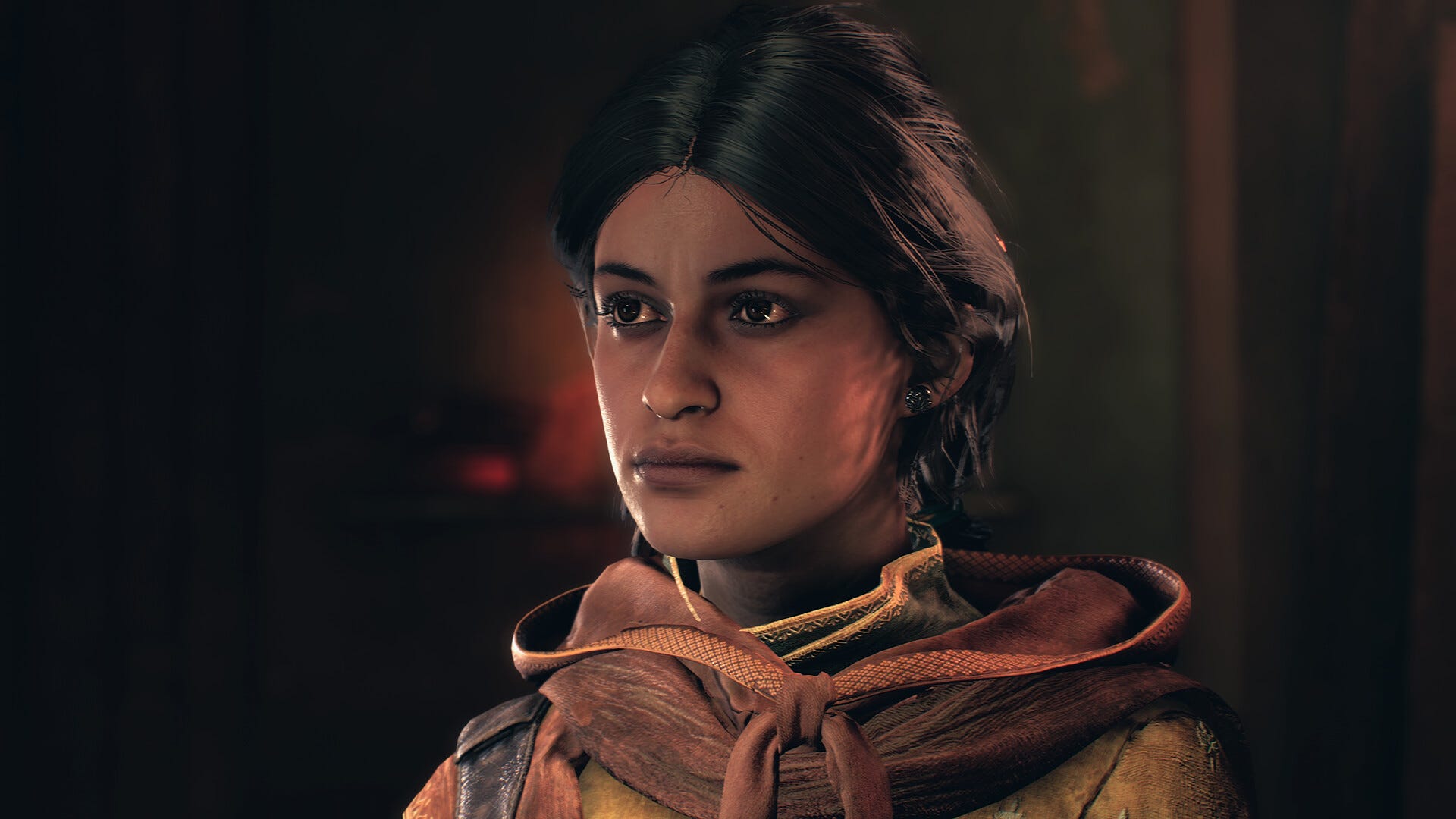
The release date for Unknown 9: Awakening has been announced.
During Gamescom Opening Night Live, developer Reflector Entertainment along with publisher Bandai Namco revealed Unknown 9: Awakening will release on 18th October. It will be available across PlayStation 5, PS4, Xbox Series X/S, Xbox One and PC (Steam).
You can check out the live action trailer for Unknown 9: Awakening, which stars The Witcher's Anya Chalotra as the game's protagonist Haroona, below.
Everything announced at Gamescom Opening Night Live 2024

Gamescom Opening Night Live 2024 is done and dusted for another year, but it's certainly kicked off this year's Gamescom with a bang - and we've got all the news, trailers and announcements right here in one handy summary. Whether you missed the show itself or just want a handy reminder of everything announced at Gamescom Opening Night Live this year, read on below.
Of course, alongside the main show, this year's ONL also had a 30-minute pre-show that was stuffed with announcements as well, which we'll quickly run through here before getting into the detail of the main show announcements below. Here, we got new trailers for Dave the Diver's latest crossovers, spooky co-op adventure Begone Beast and construction sim Roadcraft, alongside Italian Soulslike Enotria: The Last Song, Cairn (that shouty, but lovely looking climbing game from Summer Game Fest), life sim Inzoi from PUBG publishers Krafton, as well as a Terry showcase for Street Fighter 6.
There were also new game announcements in the pre-show in the form of Sniper Elite Resistance (coming 2025), the Donkey Kong-esque platformer Nikoderiko: The Magical World (with music from David Wise, no less), "first person farming horror allegory" We Harvest Shadows, the also quite spooky-looking Aila, a tease for the sequel to Journey to the Savage Planet (aptly named Revenge of the Savage Planet), action RPG Tribe Nine from the creators of Danganronpa, and the Lashana Lynch-led Directive 8020: A Dark Pictures Game.
Mafia is back and heading to The Old Country next year

It's been two years since Mafia developer Hangar 13 confirmed it was working on a new entry in its open-world crime series, and the time has finally come for it to be revealed to the world. It's called Mafia: The Old Country and is heading to PS5, Xbox Series X/S, and PC next year.
While 2016's Mafia 3 shunted the series forward in time to the late 60s (the first two games spanned the 1930s, 40s, and 50s between them), The Old Country is going backward, presenting players with a "gritty mob story set in the brutal underworld of 1900s Sicily."
"Fight to survive in this dangerous and unforgiving era," teases the scant bit of blurb accompanying today's teaser trailer, "with action brought to life by the authentic realism and rich storytelling that the critically acclaimed Mafia series is known for."
Life is Strange creators' Lost Records launches in two parts
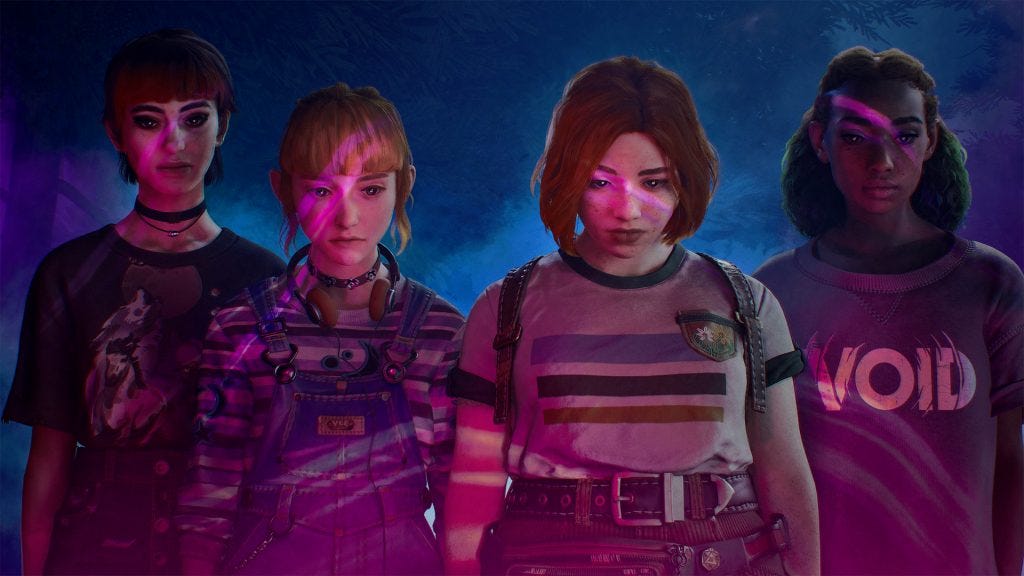
Lost Records: Bloom & Rage, the long-awaited next game from the team behind the original Life is Strange, will arrive in two parts.
The first installment launches for PC, PlayStation 5 and Xbox Series X/S on 18th February 2025, with its concluding slice then a month later on 18th March.
Tonight also brings an initial look at gameplay from Don't Nod's latest teen adventure, which has a dual timeline split between 1995 and 2022, when its young protagonists are now adults - and dealing with the consequences of their/your actions.
Indiana Jones and the Great Circle confirmed for PlayStation 5

Indiana Jones and the Great Circle - the Microsoft-owned-Bethesda-release set to arrive on Xbox and PC this year - is also coming to PlayStation 5.
At this evening's Gamescom Opening Night Live event, host Geoff Keighley revealed that everyone's favourite fedora sporting professor will be cracking his whip on Sony's platform as well.
In addition to this news, Bethesda announced a release date for the game. Indiana Jones and the Great Circle will release across Xbox Series X/S and PC on 9th December. Its PS5 release will then follow a few months later, during the spring of 2025.
Peter Molyneux: a fallen god of game design seeking one final chance

By the time you read these words, Peter Molyneux will have taken to the Opening Night Live stage at Gamescom and formally announced his new project to the world. Masters of Albion marks Molyneux's return to the genre he is widely credited with creating. It ditches his studio 22cans' previous focus on mobile development to instead target consoles as well as PC. And it's being made with help from several of Molyneux's old colleagues at his previous studios - Lionhead, Bullfrog - whose design CVs, like Molyneux's own, include a litany of 90s and 2000s classics.
On paper, all of this should inspire a positive reception. But, sitting opposite Molyneux a week before today's announcement, in the quiet boardroom of his small Guildford development studio, the veteran video game designer is clearly nervous. Those 90s and 2000s hits are now a long time ago, and much, of course, has changed. It's been 12 years since 22cans was founded and Molyneux's Curiosity cube caught the headlines, for good and bad, and the subsequent decade has not gone smoothly - crowdfunding concerns with Godus, continued accusations of broken promises, a fractured relationship with the media, and, most recently, an odd foray chasing the NFT fad with a blockchain game unfortunately titled Legacy.
Molyneux, now 65, is visibly older, softly-spoken. Last year, on social media, he described his mental health as "fragile". As we sit down, he asks if I mind whether he vapes as we talk - a habit he tells me he's picked up due to stress. He's not been sleeping well, he says, due to the anxiety of talking to the press once again. At times, when we discuss what this new project means to him - what it potentially could still mean for the latter stages of his career - his voice slows, emotion rising. But, at others, when he's discussing game mechanics, or keen to tell me more than he's strictly allowed, his old enthusiasm shines through, at one point swinging back and forth like a child on his chair.
The Finals studio's PvPvE shooter ARC Raiders resurfaces, and it's no longer free-to-play

ARC Raiders - the free-to-play PvPvE extraction shooter from The Finals developer Embark Studios - has resurfaced following an extended period of retooling, and is now launching as a premium title for PC, Xbox Series X/S, and PlayStation 5 next year.
If you're struggling to remember much about ARC Raiders, that might be because few details have been shared since its announcement back in 2021. It was originally set to release in 2022, but its launch has continued to slip since then - first into 2023 so Embark could focus on The Finals, and latterly while the studio continued to tinker with the title following a genre change.
But it turns out its switch from co-operative third-person shooter to PvPvE extraction shooter (its original form "wasn't really fun", Embark admitted during a recent press event) wasn't to be ARC Raiders' only notable change. It's now been re-announced as a $40 USD premium title, jettisoning its previous free-to-play form, albeit while still remaining a live-service game.
Civilization 7 gets February 2025 release date and first gameplay trailer

Civilization 7, the very long-awaited latest instalment in developer Firaxis' beloved 4X strategy series, finally has a release date and will be launching for PlayStation 5, Xbox Series X/S, Switch, and PC on 11th February next year.
But that's not all! As well as providing a date for strategy fans to furiously circle in their 2025 calenders, Firaxis has shared a first look at Civilization 7 in action following June's moody, if ultimately rather uninformative, cinematic trailer. And today's gameplay debut reveals a new aesthetic somewhere between the vibrantly cartoony (and somewhat divise) artstyle of Civilization 6 and the more realistic approach of earlier titles in the series.
And there's more where that came from; Firaxis will be expanding on the features glimpsed in tonight's trailer as part of a 20-minute gameplay showcase set to air at 9.30pm BST/1.30pm PT on Twitch, shortly after Gamescom Opening Night Live is through. And you might also want to stick around Eurogamer, as we'll have plenty to say about Civilization 7 ourselves.
Genshin Impact gets Xbox release date, but still no word on Switch

Those Xbox players among us who have been waiting to get their hands on open-world adventure RPG Genshin Impact, I have good news.
At this evening's Gamescom Opening Night Live, the team revealed Genshin Impact will be making its way to Xbox Series X/S and Game Pass on 20th November. It is available to wishlist now on the Microsoft Store.
The news was shared along with a new Natlan gameplay trailer (below). Earlier this year, Genshin Impact was once again accused of cultural appropriation from fans and voice actors in response to the reveal of its new cast of Natlan characters.
Little Nightmares studio's Reanimal is more kids-in-dark-places, but now with co-op

It's been nearly four years since Tarsier Studios waved goodbye to Little Nightmares after being snapped up by Embracer Group, giving developer Supermassive a crack at the much-loved Bandai-Namco-owned horror series. So what's Tarsier been doing since then? Well, it turns out the studio hasn't quite shaken off its fascination with spooky kids in scary places, as one look at its latest project, the newly unveiled Reanimal, makes clear.
Reanimal's gloomy nightmare-fairytale aesthetic, its gangly-limbed monsters, and its two young protagonists - all evident in its announcement trailer - are unquestionably reminiscent of Tarsier's Little Nightmares series. And while that's certainly no bad thing given the studio's oft-brilliant work on those games, it's not entirely clear after a half-hour press briefing, just how substantial a departure - beyond two key features - Reanimal will be from what's come before.
Reanimal tells the story of an orphaned brother and sister trapped in hellish version of the island that used to be their home, as they embark on a quest to rescue their three friends. It's a violent world of gloomy forests and decimated buildings, where empty bags of skins hang from trees and hideous, animalistic creatures roam. It's also one that's aiming for a "darker and grittier" tone compared to Tarsier's previous horror games.
Dying Light: The Beast is a new 18-hour standalone game that began life as DLC

Dying Light developer Techland has shown off a new game in its zombie series that began life as a DLC for Dying Light 2 Stay Human.
Announced during Gamescom Opening Night Live, Dying Light: The Beast is a solo or four-player co-op experience pitched as a "tight" 18-hour ride through a fresh area of the franchise's world.
Dying Light protagonist Kyle Crane, once again voiced by Roger Craig Smith, returns here, a decade on. In-game, Crane has been in captivity, and experimented on. The upside? You have zombie DNA powers to unleash that beast on enemies.
Supermassive's Dark Pictures series returns in 2025 with sci-fi horror Directive 8020

We already knew it was coming, thanks to a post-credits teaser at the end of 2022's The Devil in Me, but developer Supermassive has now confirmed its sci-fi horror outing Directive 8020 will launch for PS5, Xbox Series X/S, and PC next year.
Directive 8020 essentially takes one fist of Alien and another of The Thing then smushes them together, placing players aboard the colony ship Cassiopeia, where its crew must escape an alien organism capable of mimicking its prey.
"Earth is dying and humanity is running out of time," teases Supermassive. "12 light years from home, Tau Ceti f offers a small sliver of hope. When the colony ship Cassiopeia crash lands on the planet, its crew soon realise they are far from being alone... As they battle to survive, they are confronted with the hardest choice of all: to save themselves, they must risk the lives of everyone on Earth."
King of Meat is a chaotic new Amazon-published game from ex-Lionhead and Media Molecule developers

Amazon Games has announced King of Meat, a new game from ex-Lionhead and Media Molecule developers.
The party game is part co-op action multiplayer and part dungeon builder. Players team up online in the fictional King of Meat TV show to complete dungeons filled with enemies and traps; then dungeons can be created from scratch and shared with the game's community.
Developer Glowmade is led by Jonny Hopper who previously worked for Lionhead on the Fable series and Media Molecule on LittleBigPlanet, along with other staff from those companies.
Here's the next batch of Xbox Game Pass games for August

Microsoft has confirmed the next batch of titles headed to Xbox Game Pass for the latter half of August: Atlas Fallen, Core Keeper, and Star Trucker.
Then there's that little known game called Call of Duty Black Ops 6. You'll be able to participate in the early access open beta when it kicks off for Xbox Game Pass subscribers on 30th August, 2024, with pre-downloading available from 28th August.
"Sure, it takes itself way too seriously and the loot chase can get monotonous, but everything outside of the monster-slaying is just an excuse to get right back to the monster-slaying. Or make the monster-slaying cooler with upgrades," we said in our Atlas Fallen review.
Horizon Forbidden West is leaving PlayStation Plus

Sony is pulling Horizon Forbidden West from its PS Plus subscription service in the coming weeks.
The first-party Sony game is now listed under the 'Last Chance to Play' section on PS Plus, along with the likes of NieR Replicant, Marvel's Midnight Suns and Alien Isolation.
This upcoming removal of Forbidden West comes just a few months after Horizon Zero Dawn was also removed from the service, which as Tom wrote at the time seemed a surprising move by Sony.
Vampire: The Masquerade - Bloodlines 2 continues Paradox's delay streak, now launching next year

Paradox Interactive's streak of game delays continues with the news its Chinese-Room-developed Vampire: The Masquerade - Bloodlines 2 is now targeting a release in the "first half of 2025", rather than its previously announced "late 2024" window.
In a post on its website, Paradox called the delay a "proactive decision" derived from its commitment earlier this year to deliver "high-quality games" to its players. "Though [Bloodlines 2] is in a good enough place that we could have maintained our planned release window," it wrote, "Paradox and The Chinese Room collaboratively decided to prioritise polish."
Paradox says the delay will "create a quality assurance buffer, giving more time between testing and launch, ensuring we release the game when it's ready." More specifically, The Chinese Room will use the time to expand Bloodlines 2's story, providing twice as many endings as its predecessor, and to "adjust certain areas" such as Fabien - the voice in its protagonist's head.
The Gamescom Opening Night Live 2024 showcase
.webp?width=1920&height=1920&fit=bounds&quality=80&format=jpg&auto=webp)
Just when Geoff Keighley had started to fade from your memory, he comes rubber-banding back with a vengeance - snap! It's Gamescom week and it kicks off with Opening Night Live this evening from 7pm UK time (other Opening Night Live timings here). A pre-show with additional announcements will begin at 6.30pm UK. We'll be watching and reporting on it live, as always, right here, so you can either keep abreast of announcements while you do something else, or you can join in with your thoughtful and amusing comments. Please keep us company. Please.
What do we expect to see today? Well, probably Geoff Keighley, but also the new Indiana Jones game, Monster Hunter Wilds, and Dune Awakening. We're also expecting Little Nightmares creator Tarsier to unveil its new project, which could be exciting. On top of that: Diablo 4 expansion Vessel of Hatred, Civilization 7, hero shooter Marvel Rivals, Lost Records (the project made by the creators of Life is Strange), Kingdom Come: Deliverance 2 (which was recently delayed), and Black Ops 6. Keighley's best pal Hideo Kojima has also been tweeting enigmatic silhouetted pictures of actors who are presumably playing roles in Death Stranding 2.
And before you ask, "Yes, there will be new game announcements," Keighley said on X.
Black Myth: Wukong already Steam's most played single-player game of all time
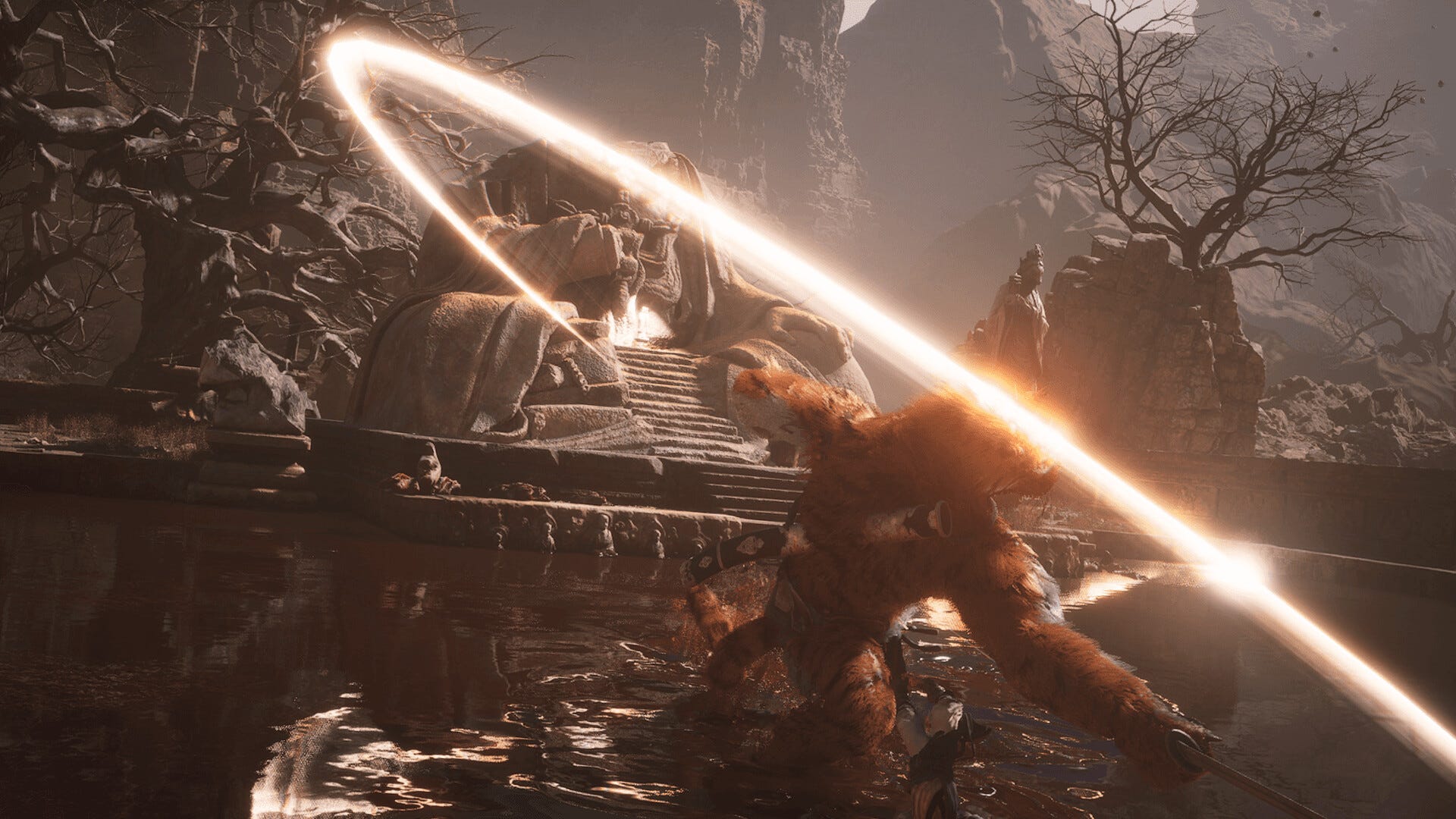
UPDATE 2pm UK: Between first publishing this story a few of hours ago and now, Black Myth: Wukong's player numbers have continued to climb.
Now, over two million players have taken to Steam to give the game a whirl. Its concurrent player peak as it stands is currently 2,125,077.
As a result, Black Myth: Wukong is now the second most played game of all time in terms of concurrent player numbers on Steam, having bopped both Counter-Strike 2 and Palworld down a place.
Black Myth: Wukong review - a disjointed and uneven action spectacle

Black Myth: Wukong is nothing if not ambitious. As many of its early trailers and tech demos implied, this was a game punching above its weight. It wasn't just a lavish retelling of the epic Chinese novel Journey to the West, a work that games have rarely engaged with outside of Asia (Ninja Theory's Enslaved: Odyssey to the West notwithstanding), but it also seemed to be demonstrating a level of technical mastery and visual pizzazz we hadn't quite seen before. It immediately put developer Game Science on the map, even if it wasn't always for the most savoury of reasons.
But now, after spending upwards of 40 hours retracing the steps of its titular simian hero as the silent but deadly Destined One, Black Myth emerges as a game that frustrates more than it delights. Its plentiful supply of grand, sweeping boss battles set the heart alight at regular intervals, its mythological menagerie bristling with the same kind of malicious energy and intent as their FromSoft equivalents. They are the tentpoles that hold this game aloft, their sharp claws, vicious fangs and powerful hoofs often tearing up the screen in exquisite and sumptuous detail. Indeed, they're the kind of bosses that will probably go down as some of the most dramatic of this generation, with its glistening dragons that rage across icy lakes and rippling pools, muscular tigers that sup in temples of blood, and giant bears, wolves, rats and spiders that command the elements to devastating effect.
But outside of those pulse-racing encounters, Black Myth is an altogether more mind-numbing experience, its thrilling highs undone by baggy world design, an uneven difficulty curve and disjointed storytelling. Ostensibly, this is a quest about reviving the legendary Sun Wukong, who scattered himself to the wind in the form of six relics after being defeated in battle centuries earlier. As the Destined One, you'll travel through forests, sand, ice, ash and more to bring them back to your mountain home, winding your way through its alternately narrow and wide linear environments until you reach the big bad in possession of it.
Indiana Jones and the Great Circle reportedly coming to PS5 next year

MachineGames' Indiana Jones and the Great Circle will reportedly launch for PlayStation 5 in the early half of 2025, following an Xbox Series X/S and PC release at the end of this year.
That's according to industry insider Nate the Hate (one of the first people to break the news of Microsoft's multi-platform plans at the start of this year) who made the claim on social media. "MachineGames' Indiana Jones and the Great Circle will release on Xbox & PC this holiday (Dec) as a timed console exclusive," they wrote. "After this timed-exclusive window expires, Indiana Jones & the Great Circle is planned to come to PlayStation 5 in the first half of 2025."
Nate the Hate's claim tallies with a report by The Verge back in February, which said Microsoft was planning to go beyond its initial slate of comparatively low-key multi-platform releases by launching some of its flagship games on competing consoles. These were said to include Starfield and MachineGames' Indiana Jones and the Great Circle, with the latter supposedly due to arrive on PS5 "some months" after its Xbox and PC release.
Black Myth: Wukong truly delivers a stunning high-end PC experience

Ever since its reveal in 2020, Black Myth: Wukong has been an alluring project. Developer Game Science has been surprisingly open in comparison to other AAA studios and the game's apparent ambitions have been reinforced with each and every press release: a hero-focused action game retelling the story of Journey to the West, and a graphical tour de force using the latest Unreal Engine features. In fact, on PC Wukong uses the Nvidia branch of UE5 to enable full ray tracing, promising an even more impressive presentation. With the full game in hand, it's time to see if Game Science has fulfilled the graphical promise of that first trailer, how the RT features work on PC, and what optimised settings can be used to deliver a smooth experience on a range of hardware. Enough monkey business then, let's get right into it.
From the moment the game starts up, it's clear that Game Science has delivered a level of graphical fidelity that surpasses that of the initial trailer. The dazzling intro to the game dazzles, with titanic mythical beings looming over you and an entire area replete with unique volumetric rendering that's unfortunately rare in the modern age.
With each and every dash, staff swipe and bit of movement, the main character and his nemesis distort and move the physical volume of fog that they find themselves in. Beyond Housemarque's Returnal and some legacy PhysX titles, real physicalised particles like this are rare, and Game Science made sure to use this GPU-intensive effect effectively to add a mystical flourish to game moments and character entrances.
Final Fantasy 16 on PC gets September release date and immediate demo

Final Fantasy 16 will launch on PC on 17th September across both the Epic Games Store and Steam.
The PC version has been long-awaited since the game was released as a PS5 console exclusive last year.
Today's news comes with a new PC specific trailer, see below. A demo is available to try out now.
Delta Force: Hawk Ops has a real shot at knocking Call of Duty and Battlefield off their perch

Modern military shooters are in a strange place at the moment. Battlefield is licking its wounds after stepping on the landmine that was Battlefield 2042, while Call of Duty is running around like the dog that caught the car, the massive success of Warzone leaving the mainline series at a loss with what to do with itself.
It's a chaotic, uncertain time in one of multiplayer gaming's biggest spheres, and the various shenanigans of EA and Activision have left room for something new to make its mark in the genre. Enter Delta Force: Hawk Ops, which you'll be shocked to hear is not a Trauma Team-style game about performing surgery on birds of prey. Instead, it's a free-to-play military shooter in the Battlefield/CoD mould, based on the series that predates either, and it could be the shot of competence and stability that the genre sorely needs.
Currently running a month-long Alpha, Hawk Ops provides access to two of its three game modes. The first of these, Havoc Warfare, is a classic large-scale attack/defence scenario similar to Battlefield's Rush, with the attacking team trying to capture a linear sequence of control points, and the defending team attempting to hold back the tide until the attackers' collective pool of lives runs dry.
Silent Hill 2 Remake drops a new story trailer, and yes, we finally get to see Eddie

Konami has dropped a brand new story trailer for its highly-anticipated Silent Hill 2 Remake.
The teaser essentially matches the original's acclaimed 2001 E3 trailer, and the script is almost identical, too, all set against a fabulous reimagining of (one of) Silent Hill 2's end themes, Promise.
The Remake trailer is below. For comparison, here's the 2001 E3 trailer for Silent Hill 2:
Black Myth: Wukong studio requests influencers not include "feminist propaganda" or Covid-19 references in coverage
.png?width=1920&height=1920&fit=bounds&quality=80&format=jpg&auto=webp)
This week's launch of Black Myth: Wukong has brought further controversy to the game with the leak of a document sent to influencers requesting they do not include "politics", "feminist propaganda", or references to Covid-19 in their coverage.
Over the weekend, a document from the marketing team at co-publisher Hero Games leaked, which was sent to influencers and streamers ahead of coverage and contains a list of do's and don'ts.
While the do's simply reads "enjoy the game", the don'ts includes a number of caveats. "Do not insult other influencers or players" and "do not use any offensive language/humour" are both understandable, but other requests are far more political.
Silent Hill 2's remake dares to modernise a classic, and is largely succeeding

Silent Hill 2 remains one of the all time survival horror greats - and its story of grief, framed by fogged streets and flashlight lit corridors, remains as haunting today as on its initial release. All of which is to say, there's a lot riding on developer Bloober Team to nail the details of its remake's atmosphere when it arrives on 8th October. To be blunt, the team has had an uphill battle to inspire confidence in long-time Silent Hill fans, not helped by a poorly pitched 'combat trailer' at Sony's State of Play in January that completely missed the brief. Since then, later gameplay showings have put the remake's intentions in much better light. And thankfully, in playing its opening three hours at a recent Konami event - from the start right up to the first Pyramid Head boss - I am now much more positive about it. Despite my worries going in, I'm glad the remake does even dare to make key changes to the game, complete with new puzzles, updated combat, plus the promise of new, additional endings.
Before we get to that, a quick Digital Foundry-style aside. On booting the game there were two graphics modes on PS5: a 30fps quality mode, and a performance mode that targets 60fps. Dynamic resolution appears to be used more aggressively for the latter, but I happily stuck with the 60fps option, which ran Silent Hill's south vale region and later Wood Side Apartment block smoothly. The only problem spot was an early graveyard area - with its obvious sub-60 drops in the build shown - but that might improve by release.
Speaking with the team at Bloober directly, it's also confirmed that both modes use Unreal Engine 5's Lumen technology on PS5 - enhancing its reflections with a software-based approximation of ray tracing. The result being that the rain-slicked streets reflect every shop sign crisply, even if they're out of your camera's view (a problem for the SSR method, which is still used as a fallback behind Lumen here). Added to this the team confirms that Lumen is also used for ambient occlusion, albeit only on the 30fps quality mode. Also, for a bit of fun, an additional 90s filter toggle is included in the remake's menus to change its colour grading to more closely match the fade of the PS2 original's - if you're that way inclined.
15 minutes of Astro Bot footage has leaked online

15 minutes of Astro Bot has once again leaked online, giving us a premature peek at what to expect when the game releases on 6th September.
In news unlikely to surprise you, the video has already been removed from YouTube (although you can still find copies of it if you're prepared to go looking), but eagle-eyed fans nonetheless managed to get a peek at the main hub, as well as a sneaky glimpse at some of the bots we can expect.
If you'd prefer to keep everything a surprise, head back to the main page now. For those excited and happy for a little head's up, read on…
DF Weekly: a snippet of Black Myth: Wukong PS5 footage arrives - so what do we make of it?

This week's DF Direct 'drops' a little early owing to a somewhat busy and congested week for us, and our usual two-hour-long chat show begins with a look at the Black Myth: Wukong benchmarking tool - and the fact that (when we filmed, at least), the developer had not shown any video footage of the PlayStation 5 version in action. Reviewers were told not to expect PS5 code pre-launch. However, yesterday, a short snippet of gameplay captured from the console did appear online, so we scrambled to take a look at it and append some thoughts about it to our show.
Let's talk about the footage itself, hailing from PlayStation China (though we picked it up from the developer's feed, which linked to IGN China instead). First of all, there are clear issues with the quality of the footage. The appearance of developer IP addresses in the top-right may suggest that the PS5's system level video recording system was used, which was then re-processed by YouTube's systems, creating a very muddy picture, heavy on compression artefacts. Even so, we can see that the game is targeting 60fps, albeit with some heavy hits to frame-rate when screen-filling effects present on-screen. Black Myth: Wukong as presented here doesn't have any screen-tearing.
Beyond that, it is difficult to tell you much more about the game when we have no context on how the clip was captured and what settings (assuming the console version has settings) it was using. To be honest, the murkiness of the footage has left me with more questions than answers - especially after carrying out performance analysis on the clip. It's not easy to gauge frame-rate from lossy video, but we've done it in the past with streaming services and the technique is pretty straightforward and boils down to manually scrolling through the clip frame by frame and marking up duplicates. In the process, we got to see how the game looks from one frame to the next and there's some evidence here to suggest that AMD FSR 3 frame generation is being used in this footage.
Ubisoft shares Star Wars Outlaws' full PC requirements

Ubisoft has updated the PC requirements for its upcoming Star Wars adventure, Star Wars Outlaws, and released a new teaser showing off what kind of performance PC players can expect when the game releases on 30th August.
Taking up a modest 65GB, the settings shouldn't be too punishing for those looking only to meet the minimum standards – although you will need to have DLSS or FSR – but those pushing for the "ultra" experience will need a decent rig.
Check out the details below:
Warhammer 40K: Space Marine 2 - a technologically ambitious sequel that can look stunning

Warhammer 40,000: Space Marine 2 is one of Digital Foundry's most eagerly anticipated games, effectively hitting the beats that made the first series entry so enjoyable. The grand scale of the environments, the dense swarms of tyranids, the absolute carnage of combat - it's all back in Space Marine 2, enhanced by the impressive technical capabilities of the Swarm engine. Focus Entertainment recently shared a preview build of the PC version of the game, and we're eager to share our impressions with you. We're liking what we see - but Space Marine 2 pushes hardware, which poses interesting challenges to the current generation of consoles, especially on the CPU side.
Saber Interactive has taken on development duties for this game, and our first impression is that it's done a fantastic job of capturing the Warhammer 40,000 aesthetic: colossal, heroic figures, massive-scale gothic architecture stretching out into the far distance and an enviable wealth of animated detail in the immediate area. The sense of density is only heightened once you get your first taste of combat: dozens of tyranids rushing you, while hundreds (possibly even thousands more) can sometimes be seen massing in the background.
Density in detail at close range also impresses, though it's not quite to the same extremes as Warhammer 40,000: Darktide. That said, as third-person game up against a first-person experience, that's not actually a bad thing. It works exceptionally well. The emphasis on detail also means that something has to give elsewhere: Space Marine 2 doesn't seem to be using cutting-edge lighting or global illumination technology, but you do get accomplished versions of mature technologies like shadow maps, screen-space reflections and screen-space ambient occlusion, while the GI solution (which does seem pre-calculated or 'baked') does give a good impression of light bounce. The quality of the physically-based materials also works well.
A "high number" of Destiny 2 players have had their usernames reset by an overzealous moderation tool

Destiny developer Bungie says it has addressed an issue where players have had their usernames changed by its "name moderation tool".
After "actively investigating" the issue for 24 hours, Bungie advised that while it had "identified the issue that was forcing a high number of Bungie name changes", it was "continuing to investigate" what happened and how "to address player accounts that were impacted".
Although Bungie acknowledged that a "high number of account names have been changed", the studio stopped short of confirming exactly how many players were affected.
Where's our Black Myth: Wukong review?

Hello! You might be seeing a few Black Myth: Wukong reviews going live at the moment, and so we wanted to let you know where ours was.
In brief: we need a bit more time with this one. It's a big ol' game, and we haven't had very long with it, meaning we've not had enough time to make significant enough progress for a full review.
There are a couple of other factors worth bearing in mind. There are some quite tight embargo restrictions for what we could talk about in an early review for this one - though that's increasingly the norm these days really - and also, we've been informed there is no PlayStation 5 code available for the game at all until on or after launch. That doesn't necessarily mean anything should be read into there - code for one platform is often available before another - but it is just one more small reason for us to sit tight a little longer.
Tim Sweeney: "No regrets" on Fortnite app store drama, as Epic Game Store launches on mobile in Europe

Epic Games boss Tim Sweeney has said he has "no regrets" over his company's decision to break Apple and Google's terms of service back in August 2020 - something that saw the hugely-popular Fortnite booted off both iPhone and Android storefronts.
The carefully choreographed stunt sparked four years of legal wrangling over Apple and Google's app store policies - and has ultimately led to Epic Games launching its own mobile store today on Android worldwide and on iPhone in mainland Europe, thanks to policy changes demanded of Apple by the EU.
"We've probably lost a billion dollars not having Fortnite on iOS the past four years," Sweeney said, in a briefing to press ahead of the Epic Games Store on mobile going live. "But what's the price of freedom?"
Abby actress Kaitlyn Dever protected by extra security while filming The Last of Us season two

Kaitlyn Dever, the actress portraying Abby Anderson in the second season of HBO's The Last of Us adaptation, required extra security during filming for her own protection.
This comes from fellow castmate Isabel Merced, who is playing Dina in the show. Speaking with Josh Horowitz on Happy Sad Confused, Merced discussed the strong emotions the series can spark within some that have resulted in volatile reactions from so-called fans.
When Horowitz said he was concerned about Dever, and the toxicity she will likely receive "through proxy of being Abby", Merced stated there are "so many strange people" who "genuinely hate" the character. This is despite her being completely fictional. And, because of this, Dever was required to have extra security during the filming for the second season.
Broken Sword - Shadow of the Templars: Reforged gets September release date

The enhanced version of classic point-and-click adventure Broken Sword - Shadow of the Templars now has a release date: 19th September.
This "Reforged" version will be available across PlayStation 5, Xbox One and Series X S, Nintendo Switch and PC (Windows, macOS and Linux).
The game's redrawn visuals have been upgraded to 4K, but there's also a new story mode UI including subtle hints aimed at new players.
Call of Duty might have seen its last 200GB+ install size as Activision announces optimisation plans

Call of Duty has become an absolute hard drive hog in recent years, with 2023's entry managing to consume over 200GB of storage in some cases. That all might be about to change, however, as Activision has announced major changes to the way it'll be handing installs with this year's Black Ops 6, promising "smaller and more customised downloads" as a result.
Activision shared the news in a post on its Call of Duty blog, explaining its optimisation work will begin with a revamp of "the experience formerly known as Call of Duty HQ". This revamp is set to roll out over the course of several updates ahead of Black Ops 6's October launch, and will promises to introduce a streamlined interface, direct access to games, more control over downloads, and expanded texture streaming technology to reduce file sizes.
A first update to reorganise game content arrives on 21st August. Then, following Black Ops 6's open beta on 30th August, a new user interface and other "remaining updates" are scheduled for mid-October. After these "larger initial updates", Activision says future Call of Duty downloads will decrease in size and existing files will take up less space on players' device.
Games Done Quick's week-long Flame Fatales charity speedrunning event returns this Sunday

Flame Fatales, the all-women and femmes charity speedrunning event from Games Done Quick, returns for another week-long programme of impressively swift gaming feats this weekend.
This year's Flame Fatales (which will be the event's fourth outing since its launch back in 2021) gets underway on Sunday, 16th August. More specifically, things kick off at 6:15pm BST, with a Horizon Forbidden West Burning Shores 100% speedrun by RE_doc19.
Seven days - and more than 50 speedruns - later - this year's Femme Fatales comes to a close at 4:06am BST with a Super Mario Odyssey Talkatoo% speedrun by CheeseJay. In between, you can expect speedruns for the likes of Persona Dancing, Sonic CD, Broken Age, Stray, the Resident Evil 2 remake, Rez, and plenty more - as outlined in this year's full schedule.
Amazon MMO New World's Aeternum overhaul is having an open beta next month

New World: Aeternum, the latest expansion/do-over for Amazon's middling MMO New World, is having an open beta on 13th September ahead of its full PC and console release in October.
Aeternum, if you're unfamiliar, emerged back in June, amid some confused messaging that didn't entirely make it clear exactly what it was. And, truthfully, Amazon's marketing remains as baffling as ever. The gist, though, is that this is the same MMORPG released back in 2021, albeit with new features and a bit of finessing ahead of its debut on Xbox Series X/S and PS5.
It's got a pacier story (told through in-game cinematics and pre-rendered cut-scenes), combat improvements, cross-platform play, enhanced controller support, and more - while still retaining its other MMO bits like classes, crafting, and questing. Then there's New World's first-ever large-scale PvP zone, a new 10-player raid, end-game solo trials, and other additions.
Doom and Doom 2: are Nightdive's latest remasters the definitive editions?

For many, scaling Mount Everest has stood as the ultimate challenge of one's strength and endurance. An achievement of a lifetime. For long-time Doom players, however, there is an equivalent: NUTS.WAD. Legend has it that NUTS.WAD descended upon Doom players in the year 2001: a map from the future in which players are dropped into a single map with more than 10,000 enemies and a handful of power-ups. And now - for the first time ever - it's playable on a games console.
I'm half-joking, of course, but the ability to load in any Doom mod is just one great feature found in the latest version of Doom and Doom 2. Helmed by Nightdive in cooperation with id Software and Machine Games, this new version is worth looking at as it is the most feature rich, best-performing version of Doom on consoles. It's available on PC, PS5, Xbox Series consoles, Switch and even last-gen PS4 and Xbox hardware. The game was transitioned over to Nightdive's KEX engine and brings with it a vast array of enhancements - 120fps support on consoles, 16-player multiplayer including co-op, and a new soundtrack from the legendary Andrew Hulshult.
But it was the mod support that was my first destination and with it, the chance to see how Nightdive's work would cope with the NUTS.WAD challenge. This pushes beyond the limits of what Doom engine was intended to handle and now we can test it on console and the results are interesting. Before we go on, it's worth stressing that all current-gen machines can handle 4K gaming at 120fps - and yes, that includes Series S. The engine is optimised and fast - all the included content and every map I tested runs like greased lightning. I wanted to raise this caveat because the challenge of NUTS.WAD is so extreme and cruel that I don't want people to get the wrong idea. The fact that you can run NUTS.WAD at all is cause for celebration!
Amazon reportedly working on animated anthology TV series featuring Spelunky and other video game worlds

UPDATE 20/8/24: Well, there you go. Following last week's Deadline report, Amazon has officially unveiled Secret Level, a new "adult-animated anthology series featuring original stories set within the worlds of some of the most beloved video games".
It's a 15-episode series from the creators of Love, Death & Robots, and it'll feature stories inspired by Armored Core, Concord, Crossfire, Dungeons & Dragons, Exodus, Honor of Kings, Mega Man, New World: Aeternum, PAC-MAN, Sifu, Spelunky, The Outer Worlds, Unreal Tournament, Warhammer 40,000, and a variety of PlayStation Studios games.
And if that takes your fancy, you'll be wanting to circle 10th December on your calendar - which is when the series arrives on Prime Video - then check out its teaser trailer below.
Here's your PlayStation Plus Extra and Premium lineup for August

Sony has announced August's PlayStation Plus games.
Those on the subscription's Extra tier will get the following titles:
In addition to the above, those on PS Plus Premium will also get access to the below:
Treyarch shows off Call of Duty: Black Ops 6's Terminus Island Zombies map in new trailer

Activision sure is dragging out its reveal of Call of Duty: Black Ops 6's Zombies mode. But if you're sucker for the undead stuff, there's more where last week's trailer and gameplay reveal came from, with developer Treyarch having now offered a tour of Zombies' Terminus map.
Terminus Island is one of two maps that'll be available at launch (the other being the West Virginian town of Liberty Falls), and Treyarch calls it "one of the largest round-based Zombies maps ever created". Black Ops 6's Zombies mode takes place in the early 90s - five years after the events of Black Ops Cold War's Zombies mode - and Terminus Island serves as a prison for some familiar Requiem faces. After their liberation early at the start of the story, players can explore the prison itself before moving out to investigate its tropical island surroundings.
There's a secret research facility specialising in "weird science" (in case you were wondering where the zombies might spring up from this time), as well as the ocean, and assorted smaller islands - all of which players will visit as part of Terminus' main quest. It's described as a "living world" full of scripted encounters, ranging from zombies smashing out of vats and prison guards still trying to control the undead threat, to less fortunate souls being chomped on.
Among Us adds Critical Role cosmetics, ahead of Ashley Johnson's role in series

Among Us developer InnerSloth has announced a collaboration with Dungeons and Dragons web series Critical Role.
This collaboration means players can now bedeck their little space beans with a number of items worn by those intrepid members from Vox Machina, Mighty Nein, or Bells Hells. I am talking about Artagan's Incredible Brows Visor or the Dust of Deliciousness Nameplate, to name but two.
"Getting to work alongside the wonderful crew of the hit TTRPG show Critical Role to bring some of their magic to Among Us for Gilmore's Curious Cosmicube has been mind blowing," InnerSloth said. "Be sure to go to our in-game store and spend some Stars before the Cosmicube is gone."
Here are all the carriers that get you an iPhone 15 for free

The iPhone 15 arrived late last year. If you haven’t picked it up yet it will set you back quite a chunk of change, depending on the model and storage size. Is there a way to get a free iPhone 15? Actually yes. There is a catch, though.
Where can you get a free iPhone 15?
So back to that catch we mentioned. No one is going to give you a free iPhone for nothing. The only way to get it is through your carrier and there might be a few hoops to jump. Also, be aware you’ll typically see these ‘free phones’ in the form of credit discounts over a long period of months. If you cancel your plan or change up phones sooner than expected, you may end up owing back some money.
Below we take a quick look at the carriers and retailers currently offering an iPhone 15 for free when you sign up.
Verizon
Verizon is actually offering a few iPhone 15 deals. First, if you trade in an eligible iPhone you can get up to $830 offer. That’s not enough to cover an iPhone Pro model, but it’s enough to cover the base iPhone 15 and almost completely cover the Plus as well.
There’s another deal that doesn’t require a trade-in, but you do need to add a new line. Both new and existing accounts are eligible, but this really only works for existing customers if you are planning to add a new family member. This deal will give you $830 off. This price is enough to cover the base iPhone 15 Pro, but you’ll still likely have to shell out a few hundred for the iPhone 15 Pro Max.
T-Mobile
T-Mobile is also offering quite a few free iPhone 15 deals. The best deal gives new customers four lines and four iPhone 15 units for just $25 a month per line. Don’t need four lines? You can also get just one iPhone 15 via 24 monthly credits if you add a new line and port a new number over to the Go5G Next plan.
AT&T
AT&T no longer offers the latest iPhone for free but you can get it for as little as $4 a month by trading in an eligible phone and signing up for one of its unlimited plans. You’ll get up to $830 with qualifying trades. Your phone didn’t make the cut? Some older models will qualify for smaller discounts as well, such as the older iPhone X series.
Boost Infinite
Boost Infinite is also offering a free iPhone 15 deal, specifically the Pro model. All you need to do is sign up for the Boost Infinity Access Plan. No trade-in is necessary. This makes Boost’s offer the best iPhone deal, though not everyone will be willing to make a switch to a whole new carrier to take advantage. Nonetheless, this is a heck of an offer.
FAQ
What is the lowest price iPhone 15?
The standard iPhone 15 is the lowest-priced model at $799. A cheaper alternative in the Apple line would be the Apple iPhone SE (2022).
Can I get the iPhone 15 Pro Max for free?
None of the carriers in the US are offering the phone for free, but with the discounts mentioned above you can still get it for just a few hundred.
Is the iPhone 15 worth it?
If you’re coming for an iPhone 13, probably not. If you’ve had an iPhone or Android device for years, then absolutely. For those who don’t mind spending more, we will say that the Pro is the better deal.
Microsoft OneNote wants to be your default note-taking app (APK teardown)
- Microsoft appears to be getting OneNote ready to support Android 15 lock screen note-taking.
- New text strings in OneNote make explicit reference to the forthcoming lock screen support.
- Despite this, the app does not currently appear as an option for your default notes app.
Google’s next major mobile OS release is on its way, with Android 15 expected to formally arrive a little later this year. That’s going to introduce plenty of tweaks and new additions, like support for Satellite SOS during emergencies. One particular change we’re looking forward to involves the platform’s integration with note-taking apps, allowing users to quickly access their preferred note app right from the lock screen. Today we’re checking out the progress one of those apps is making towards adding support for this new Android 15 feature.
As we mentioned back when first sharing news of Android 15’s note-app lock screen support, this isn’t just going to work by default with whatever app you use to take notes now (and no, saving notes as drafts in Gmail doesn’t count). Developers have to intentionally build support for this new way of accessing their software, including the appropriate steps towards preserving privacy, considering we’re doing all this right from the lock screen. Google Keep has been ready to go for ages already, and now we think we’ve spotted what could be the next major app to do its own preparations.
We’re checking out Microsoft OneNote version 16.0.17928.20054 beta, in which we observe the presence of the following strings:
<string name="feature_notes_role_description_when_permission_disabled">Allow to make OneNote as "Default Notes App"</string>
<string name="feature_notes_role_description_when_permission_enabled">Add Lock Screen Note Taking shortcut from settings</string>
<string name="feature_notes_role_enable_button">Enable Lock Screen Notes</string>
<string name="feature_notes_role_title">Lock Screen Notes - Take notes over lock screen</string>
<string name="permission_notes_role_disable_description">Are you sure you want to remove OneNote as “Default Note Taking App” ?</string>
<string name="permission_notes_role_enable_description">We need permission to make OneNote as “Default Note Taking App” to enable this.</string>
<string name="setting_notes_role_summary">Turn this on to quickly jot down notes over Lock Screen.</string>
<string name="setting_notes_role_title">Lock Screen Sticky Notes</string>Indeed, being able to choose an app as your default notes app is fundamental to Android 15’s lock screen support, and further strings here confirm Microsoft’s work towards preparing that compatibility. But even on Android 14, we should be able to set a primary notes app (after enabling it in developer settings, anyway) — and despite the progress we seem to be seeing here, you’re still not able to do that with OneNote. That suggests to us that Microsoft’s still working on setting OneNote up with the permissions and roles it will ultimately need.
With Android 15 still in beta, Microsoft has at least a few more weeks to get OneNote ready if it intends to have lock screen support ready for the platform’s release. Right now, our best estimate places that as happening sometime this fall.
Deal: The best headphones return to Prime Day prices

Are you looking for the best headphones around? We have a sister site dedicated to audio, and our coworkers at SoundGuys deem the Sony WH-1000XM5 headphones the best for most people. That said, these are pretty pricey at the usual $400 price point. Waiting for the right sale to hit makes all the difference, and right now, the Sony WH-1000XM5 headphones are at the same record-low prices we saw during Prime Day: $298.
Get the Sony WH-1000XM5 headphones for just $298
This deal is available from Amazon. The discount applies to all color versions of the Sony WH-1000XM5 headphones: Black, Midnight Blue, and Silver.
We have a list of the best headphones available over at SoundGuys.com, and the #1 spot belongs to the Sony WH-1000XM5 headphones. This is because this model offers great performance across the board. The audio quality is outstanding, and it is still one of the headsets with the best ANC quality around. Even the microphone is excellent.
Additionally, battery life is stunning at nearly 32 hours with ANC on, according to our standard battery test for headphones. Turn off ANC, and that time will go up to an insane 53 hours. Of course, you’ll also get cool features worthy of a high-end headset. These include touch controls, Find My Device support, and Bluetooth multipoint capabilities.
Again, this is the same discount we saw during Amazon Prime Day, and it also happens to be a record-low price for these fantastic headphones. If we were you, we wouldn’t think too long about buying the Sony WH-1000XM5 headphones. The price might go back to normal soon, and these are still the best headphones around.
Android 15 features: Everything you need to know about confirmed and leaked features
Android 14 was publicly launched with the Pixel 8 series back in October 2023. We’re well into the new year, and Google has begun testing the next version of Android, now up to the Android 15 Beta 4.2. This beta is the second platform stability release, meaning the APIs are finalized, and we are even closer to the stable Android 15 rollout.
In this article, we’ll tell you everything we know (and think we know) about Android 15 so far! Fair warning, we’ve covered a lot of features in immense detail, so this article is very long. Consequently, this article has several indexes that should make it easier to navigate.
Android 15: Name and release date
Google used to name Android versions with dessert codenames, but it strayed away from that tradition with the release of Android 10, where it decided to stick with only the version number for all future releases. So Android 15 is simply known as Android 15. However, Google still uses the dessert codenames internally. Android 15’s internal codename is Vanilla Ice Cream.
Google has begun testing Android 15 through two developer previews and four betas (and several sub-releases), though the final stable release is still some weeks away. Android 15’s release schedule includes beta releases going through August, and we’ve already reached the platform stability stages, meaning that no new features or APIs will be added so app developers can begin testing their apps against these public APIs. The next few sub-releases, if any, will be focused on ironing out bugs for the most part.
Google hasn’t mentioned when the stable Android 15 builds will be released. We presumed it would happen alongside the Pixel 9 series launch on August 13, 2024, but the new flagship line debuted with Android 14. Google also made no mention of its forthcoming OS. This means that Android 15’s launch window could be closer to its predecessors, but it will not coincide with a new Pixel launch as was initially anticipated.
If you use a recent Google Pixel device, you will be the first in line to receive the Android 15 update. OEMs will take a little longer to release their functional Android UX skins on top of the Android 15 platform. A few Android Partner OEMs are participating in the Android 15 Developer Preview program, and you can install Android 15 beta updates (without the OEM-specific customizations, for the most part) on select non-Pixel devices.
For those who don’t mind taking matters into their own hands, you can follow our guide and install Android 15 on your phone by yourself. If you are done testing, here’s how you can leave the Android 15 beta program without wiping your data.
Once Android 15 is released publicly, OEMs will run their own beta programs for their skins, followed by stable releases. You can check if your phone has received the update through our Android 15 update tracker.
Android 15 confirmed features, UI changes, and UX improvements
Android 15 looks quite similar to previous Android versions, but there are some notable changes that Google has introduced with this update. There are also functionality updates to several important features. All of these features have either been officially announced or have been spotted in the released Android 15 build.
Partial screen sharing
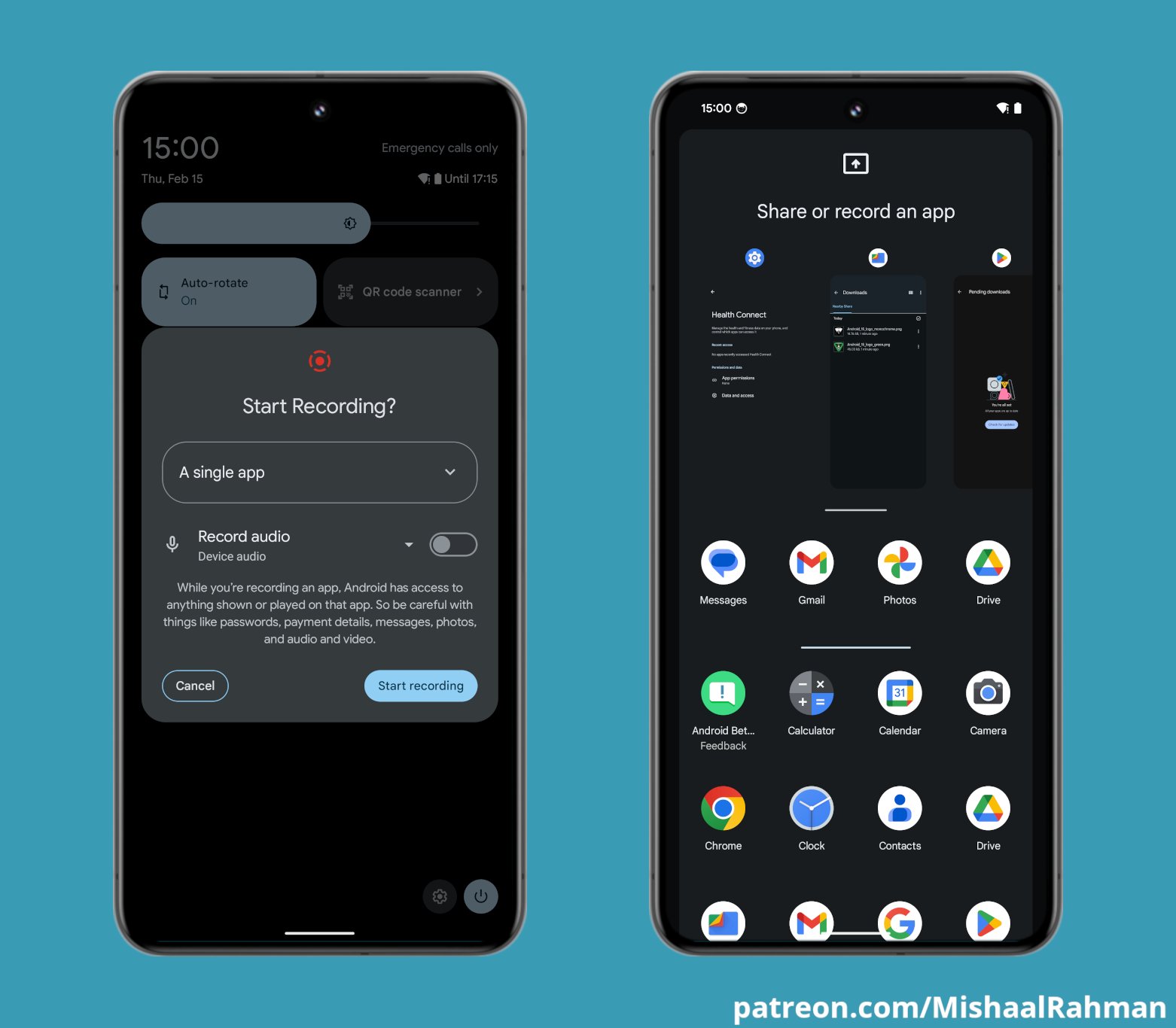
With Android 15, users can share or record just an app window rather than the entire device screen. This feature was enabled first in Android 14 QPR 2 on Pixel devices but will now be available across the wider Android platform.
Satellite connectivity support
Android 15 extends platform support for satellite connectivity. The platform now has UI elements that are needed to “ensure a consistent user experience across the satellite connectivity landscape.” As part of these changes, apps can use APIs that allow them to detect when a device is connected to a satellite, which can give the app more awareness of why full network services are unavailable.
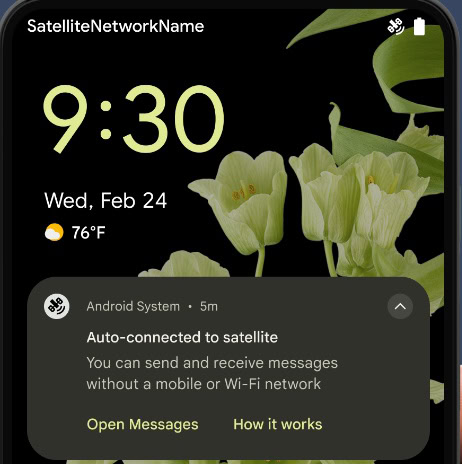
Android 15 also provides support for SMS apps and preloaded RCS apps to use satellite connectivity for sending and receiving messages. This means that satellite connectivity will not be limited to emergency uses only. Leaks had indicated that a deeper T-Mobile tie-in would be in place for satellite connectivity features, but Google has not yet revealed such details.
New in-app camera controls
![]()
Android 15 is adding new extensions for more control over the camera hardware on supported devices. New features added through these extensions include low-light enhancements that give developers control to boost the brightness of the camera preview and advanced flash strength adjustments that enable precise control of flash intensity when capturing photos.
Universal toggle for keyboard vibration control
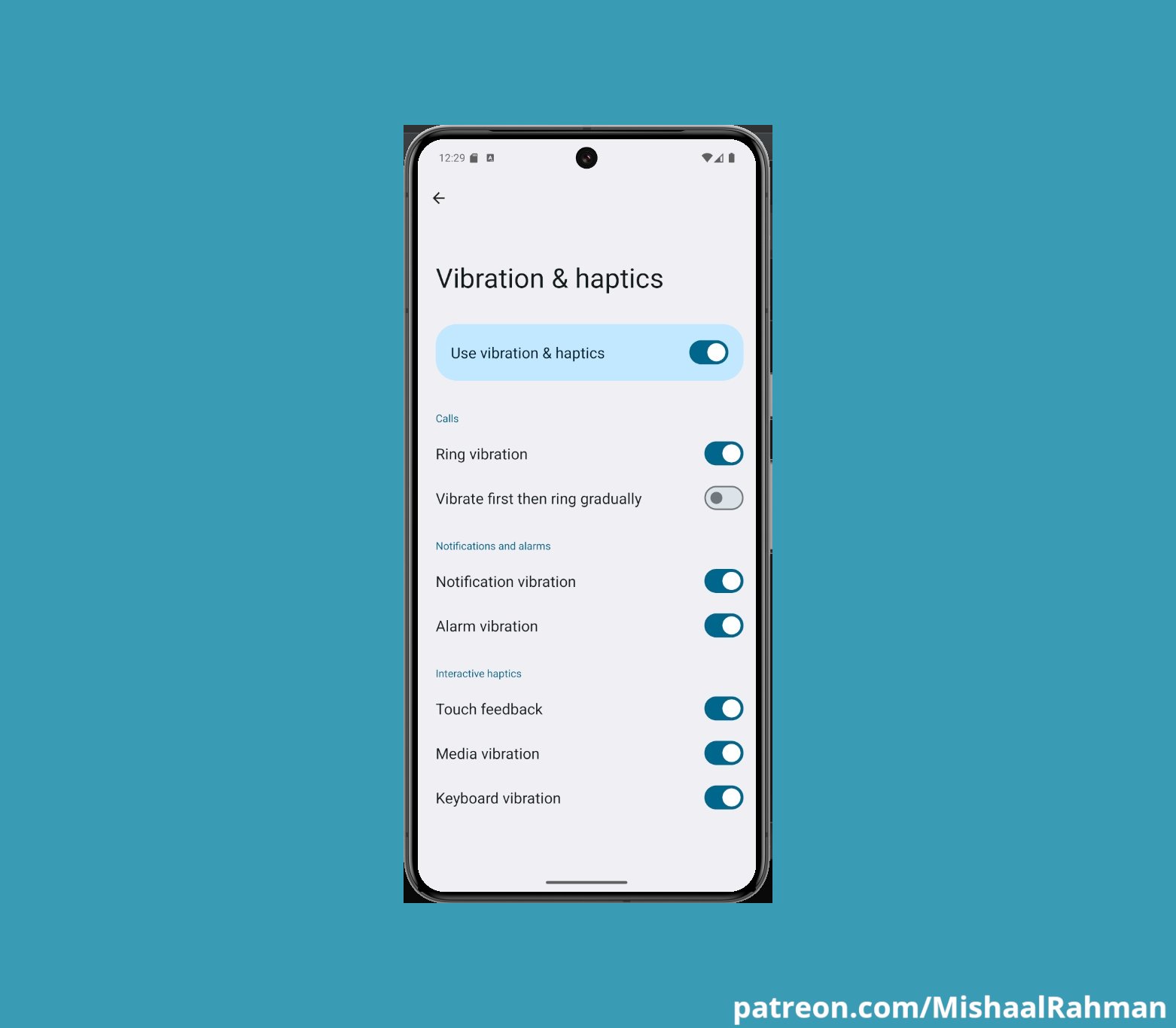
Android 15 Developer Preview 1 added a new “keyboard vibration” toggle that lets you universally disable keyboard vibration. When turned off, the system setting will override the setting within individual keyboard apps. When turned on, you can control the setting within individual keyboard apps, too.
Sensitive Notifications
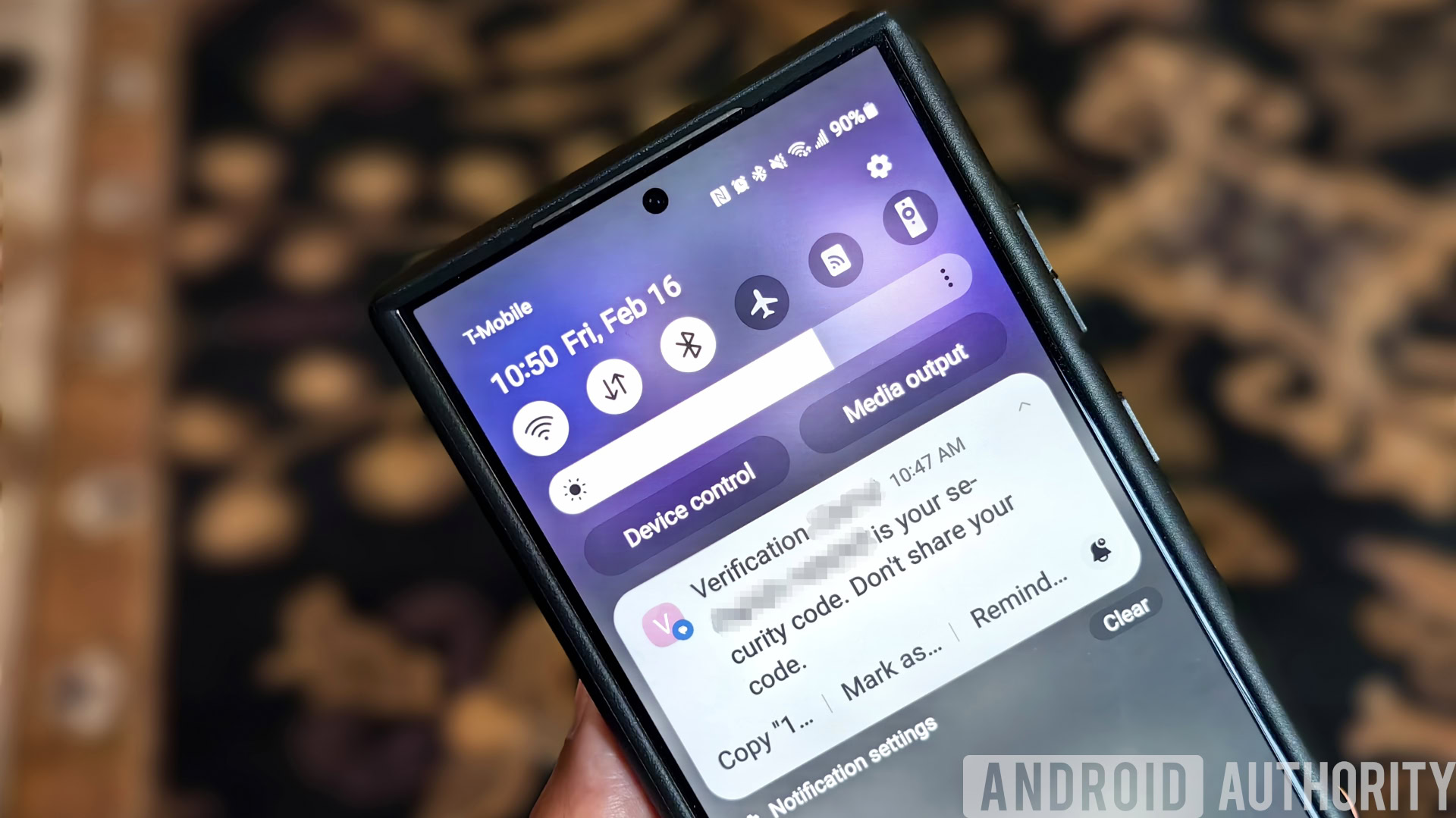
Some forms of two-factor authentication (2FA) are safer than others, but many platforms rely on the most basic form of 2FA that sends one-time passwords (OTP) via text or email. However, Android 15 will fix that by adding a sensitive notifications feature that prevents your OTPs from being read by malicious Android apps.
Bluetooth popup dialog
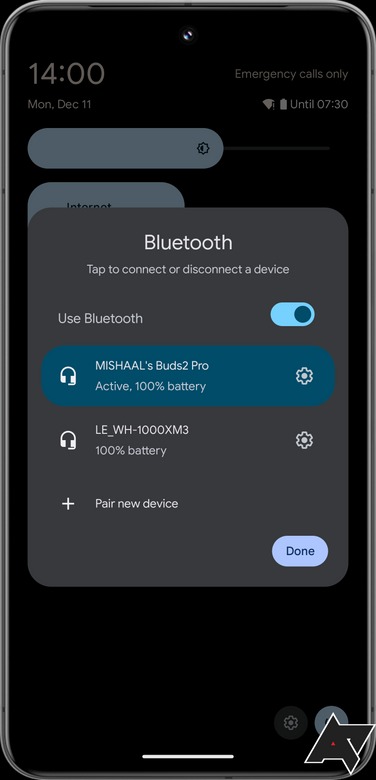
Android lets you toggle Bluetooth through the Quick Settings tile, but most people leave the connection on to quickly connect to their accessories throughout the day. If you have multiple accessories around, you may find better utility with a Quick Setting tile that lets you toggle the individual connections to connect and disconnect to individual devices.
Android 15 brings this functionality, letting you click on the Bluetooth Quick Settings tile to open up a popup dialog that lets you perform more functions, such as toggling Bluetooth, connecting and disconnecting to individual devices, entering their settings page, and pairing new devices.
Auracast focus: Audio sharing to nearby Bluetooth LE Audio streams
Android 13 lets users share or connect to nearby LE Audio streams, but Android 15 could make the Auracast feature easier to discover. This would allow Auracast-supported devices to broadcast audio to nearby Auracast devices using BLE without the hassle of pairing. There is a new “audio sharing” page that appears at Settings > Connected devices > Connection preferences to facilitate this audio sharing, as spotted in Android 15 Developer Preview 2, although it isn’t working.
We managed to enable the “audio sharing” feature on the Pixel 8 Pro running Android 15 Beta 1.1. Once enabled, we could start an Auracast broadcast on the Pixel 8 Pro that other devices in the vicinity (a Galaxy S24 Ultra and a Galaxy Z Fold 5, which were part of our testing) could connect to.
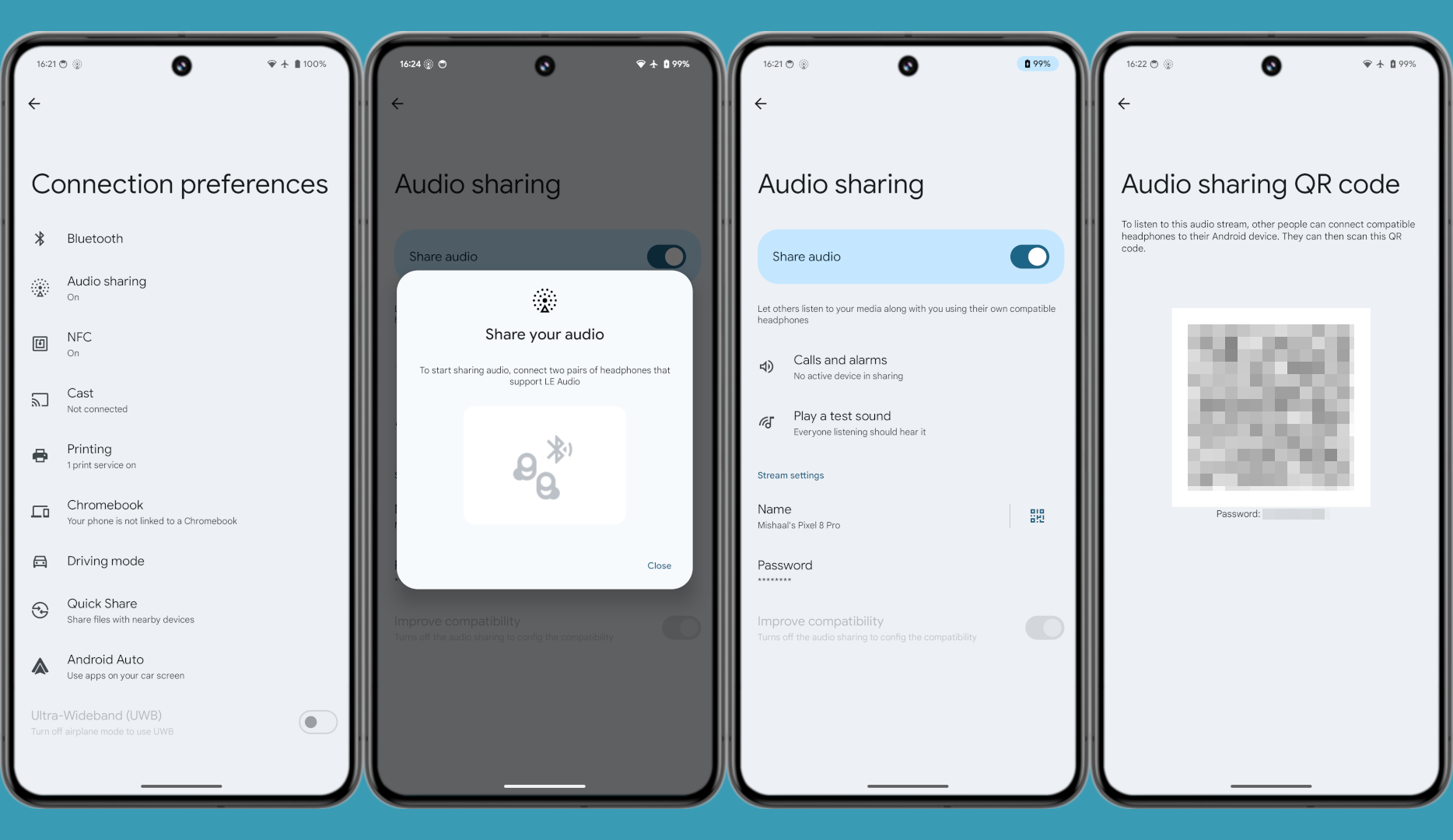
We can manually set the broadcast name and password under the “stream settings” header in the “audio sharing” page. There’s also a QR code that can be generated to make it easier for others to connect to the stream.
Since Auracast is a one-way broadcast, connected devices cannot control the media playback of the source device.
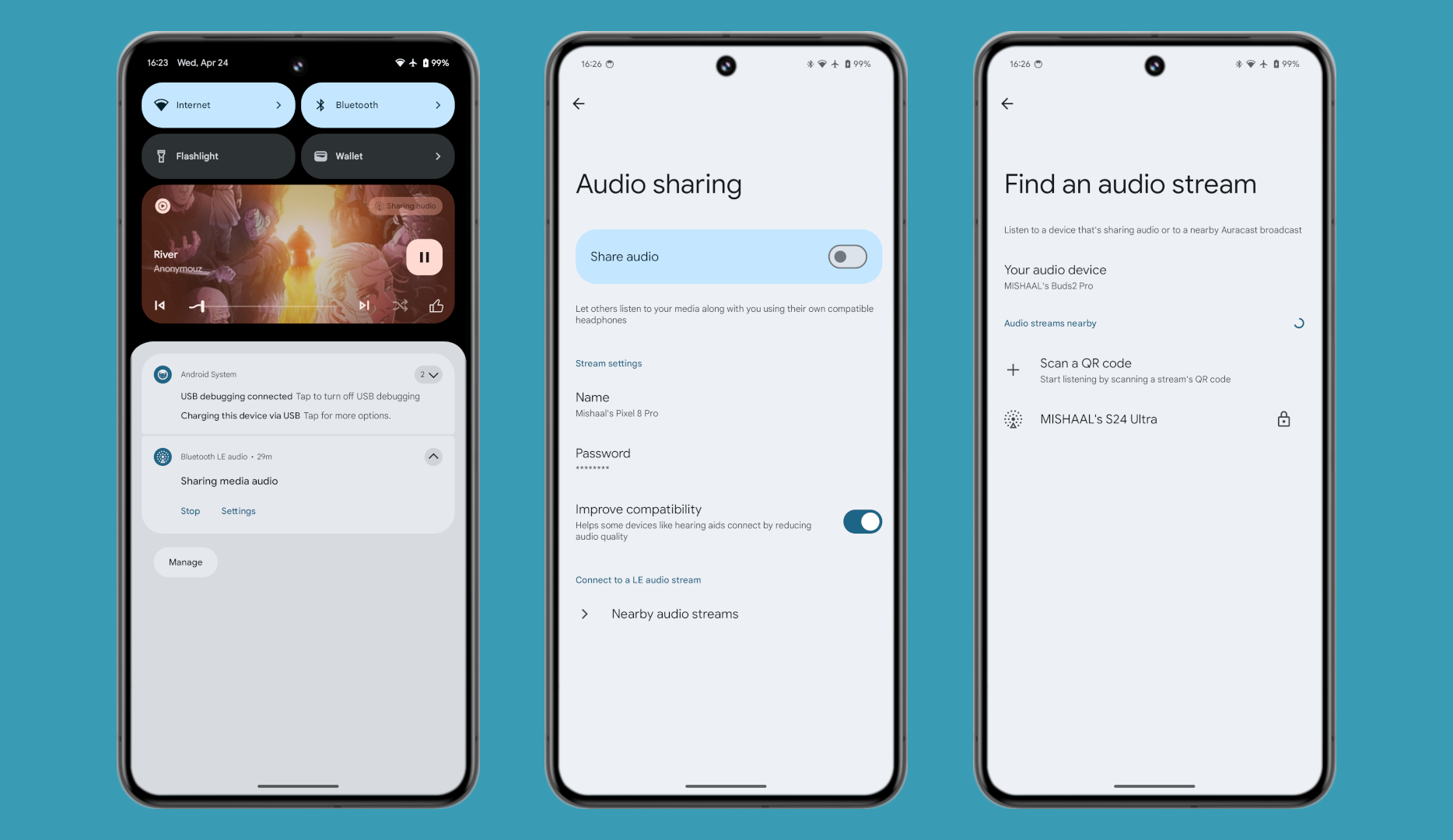
You can also find and connect to nearby Auracast streams in Android 15 with some tinkering, and there may even be a button in the Quick Settings dialog for this. Since the settings stubs are live, we hope to see the feature become a permanent and functional part of Android 15.
High-Quality Webcam mode
Third-party webcam apps make it easy to use your Android phone as a webcam for your PC. Android 14 QPR 1 release for Pixel smartphones integrated the feature into the system, meaning you didn’t need a third-party app anymore. However, the output quality was pretty mediocre.
Android 15 Developer Preview 2 integrates a new High-Quality Webcam mode when you start the USB webcam feature on a Pixel device.
There is a new “HQ” symbol in the webcam preview. Tapping on it disables any power optimizations that Google made that previously resulted in lowered quality. This mode significantly improves video quality, but the drawback is increased battery drain and heat buildup.
Changes for continuity features on foldables
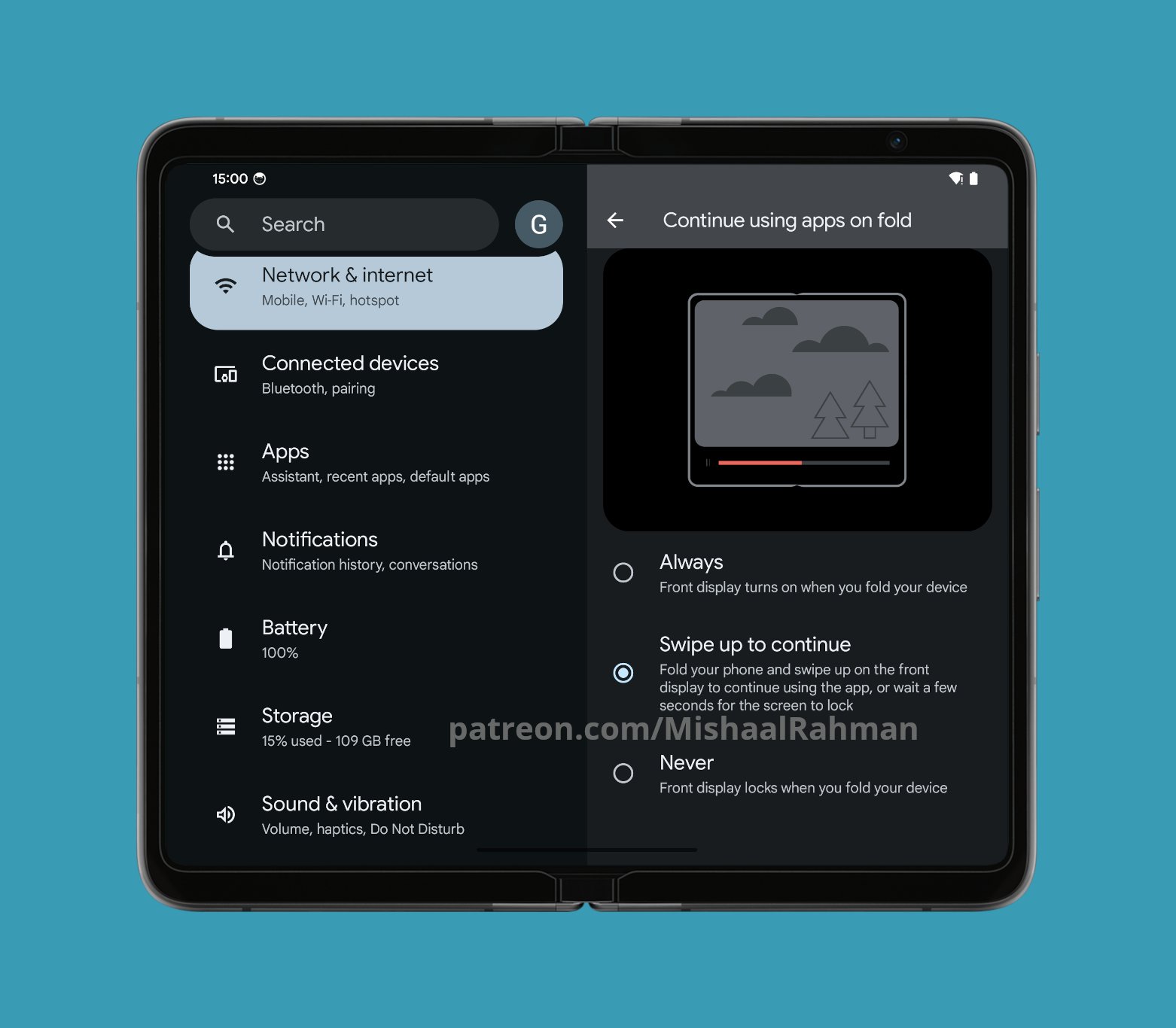
With Android 15, you can control whether you want to continue using apps on the front display on foldables. Mishaal Rahman notes that this feature was present on Android 14 QPR betas but was removed and is now returning. You can either have the front display turn on whenever you fold your device; have it turn on for games, videos, and other apps, or never turn it on and lock the front display when you fold your device.
If these settings feel restrictive to you, Mishaal Rahman notes that Google is also testing a “swipe up to continue” option that replaces the “only games, videos, and more” option. This mode will let you continue apps on the cover screen by swiping up on the lock screen after you fold your device.
Better cover screen support
With Android 15, app developers can declare a property to allow their app to be presented on the small cover screens of supported flippable devices. These cover screens are often too small to run full-fledged apps with a good user experience, but app developers can opt-in to support these cover displays.
Persistent taskbar for large-screen devices
Google added a taskbar dock for large-screen devices with Android 12L. It took the entire width of the screen and stayed there persisently, but this meant it took up a lot of screen space rather permanently. With Android 13, the taskbar shrunk in size to a smaller pill-shaped box, but it also became transient, appearing for a few seconds only when the user swiped up on the gesture bar. While the change was good, it also made accessing the taskbar dock a two-step process, which may not work for heavy multi-taskers.
With Android 15 Developer Preview 2, Google is giving users the option to choose the transient taskbar or to make it permanent with a new “always show taskbar” toggle.
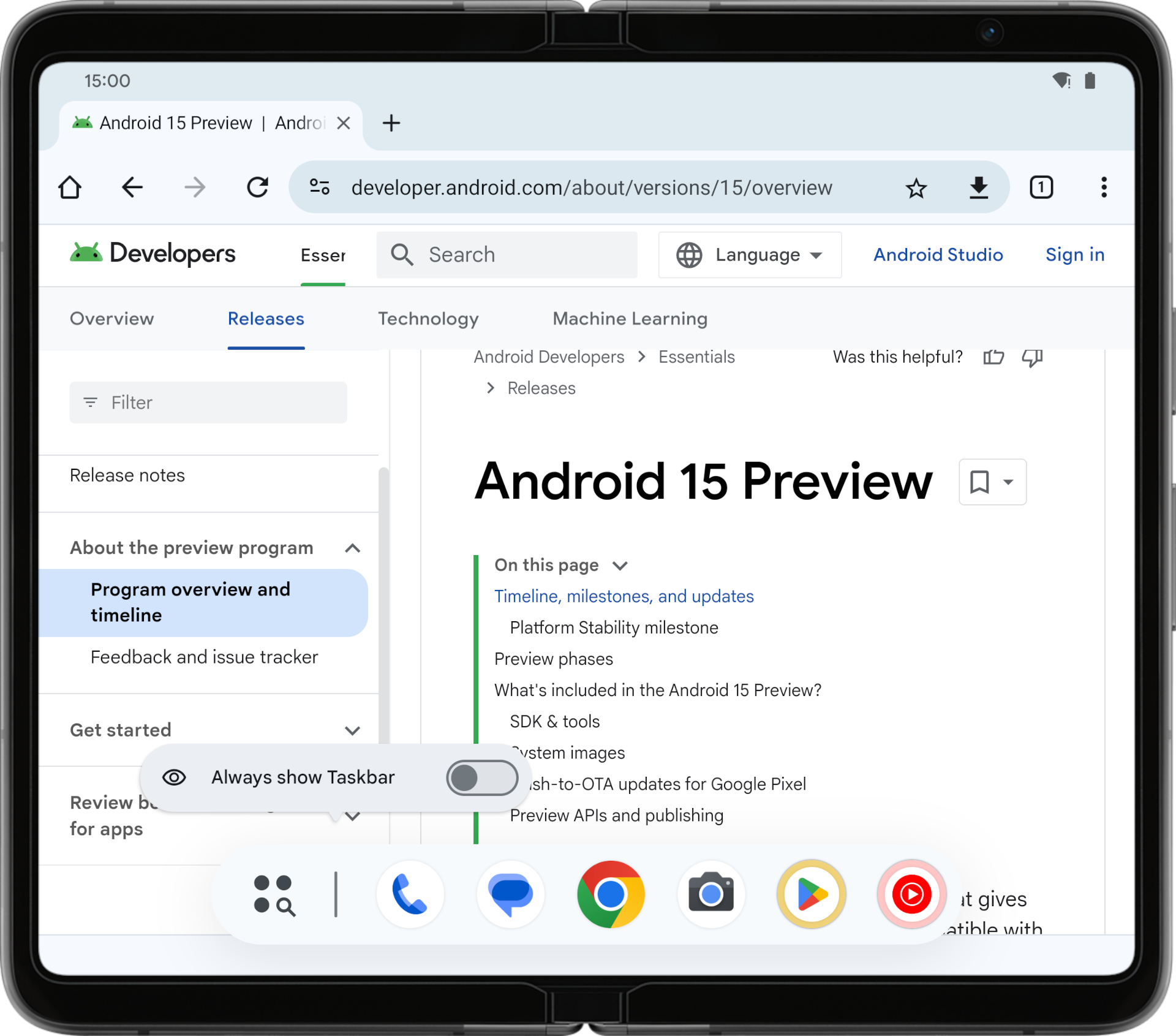
This way, users can have the best of both worlds, suiting their needs. Android 15 Beta 2 makes it an official feature.
Circle to Search support with persistent taskbar
With the taskbar enabled on the Pixel Tablet, users could not invoke Circle to Search unless they changed back to the transient taskbar. With Android 15 Beta 3, Google added the ability to invoke Circle to Search by holding down the action key (the button in the taskbar that launches the floating app drawer).
When you boot up Android 15 Beta 3 and switch to the persistent taskbar, the launcher will even inform you that this is now possible by displaying a pop-up. The pop-up tells you to “touch & hold the action key to search what’s on your screen,” as shown below.
![]()
Health Connect
Android 15 includes updates to the Health Connect by Android platform, which adds support for new data types across fitness, nutrition, and more. Beta 2 adds skin temperature and training plans as additional data types.
Virtual MIDI 2.0 Devices
Android 13 added support for connecting to MIDI 2.0 devices via USB, which communicate using Universal MIDI Packets (UMP). Android 15 extends UMP support to virtual MIDI apps. This enables composition apps to control synthesizer apps as a virtual MIDI 2.0 device, just like they would with a USB MIDI 2.0 device.
HDR headroom control
In situations where you have some HDR content on your screen but more SDR content (for example, an HDR thumbnail while the rest of the content is in SDR), the HDR content can overpower the perceived brightness of the rest of the SDR content. Android 15 allows apps to control the HDR headroom, so they can avoid such situations.
Loudness control
Android 15 has officially introduced support for the CTA-2075 loudness standard that helps app developers avoid loudness inconsistencies and ensures users don’t have to constantly adjust volume when switching between content. The Android system leverages known characteristics of the output devices (headphones, speaker) along with loudness metadata available in the AAC audio content to “intelligently adjust the audio loudness and dynamic range compression levels.”
Edge-to-edge apps by default
Android allows apps to use the entire height and width of the display to showcase their content, but many apps do not take advantage of this. Android 15 forces apps to go edge-to-edge by default, but Google also quietly added a way for developers to opt out of this change.
Predictive Back
One of Android 14’s highlight features was supposed to be the new predictive back gesture, but the feature remained gated behind Developer Options. Google is finally graduating the feature beyond Developer Options, so system animations such as back-to-home, cross-task, and cross-activity will appear for apps that have properly migrated to this feature.
Predictive back provides a smoother, more intuitive navigation experience while using gesture navigation, leveraging built-in animations to inform users where their actions will take them, to reduce unexpected outcomes.
App Pairs to quickly launch split-screen app combos
Google is allowing large-screen device users to save their favorite split-screen app combinations for quick access. The press release does not name the feature, but the attached graphic shows a “Save app pair” option. Google also mentions it explicitly for large-screen devices and not for smaller-screen devices like phones.
From what we know, when you save an app pair, an icon is added to the home screen that shows the two apps in a saved pair configuration. Clicking on this icon will launch this app pair configuration.
New collapsible volume panel
Android 15 Beta 2 features much thicker, pill-shaped sliders in the expanded volume panel, the same that we discovered in previous builds. You can slide the slider to change volume, and you can also click on the extreme left of any pill to mute that stream or on the extreme right to raise the stream to maximum volume. This expanded volume panel also collapses, and you can do that by pressing the button next to the media stream.
Helpfully, the expanded volume panel now includes a persistent media output shortcut, which remains present there irrespective of the media playback state. There are also new animations, with the stream name text moving with the slider.
Richer Widget Previews with Generated Previews
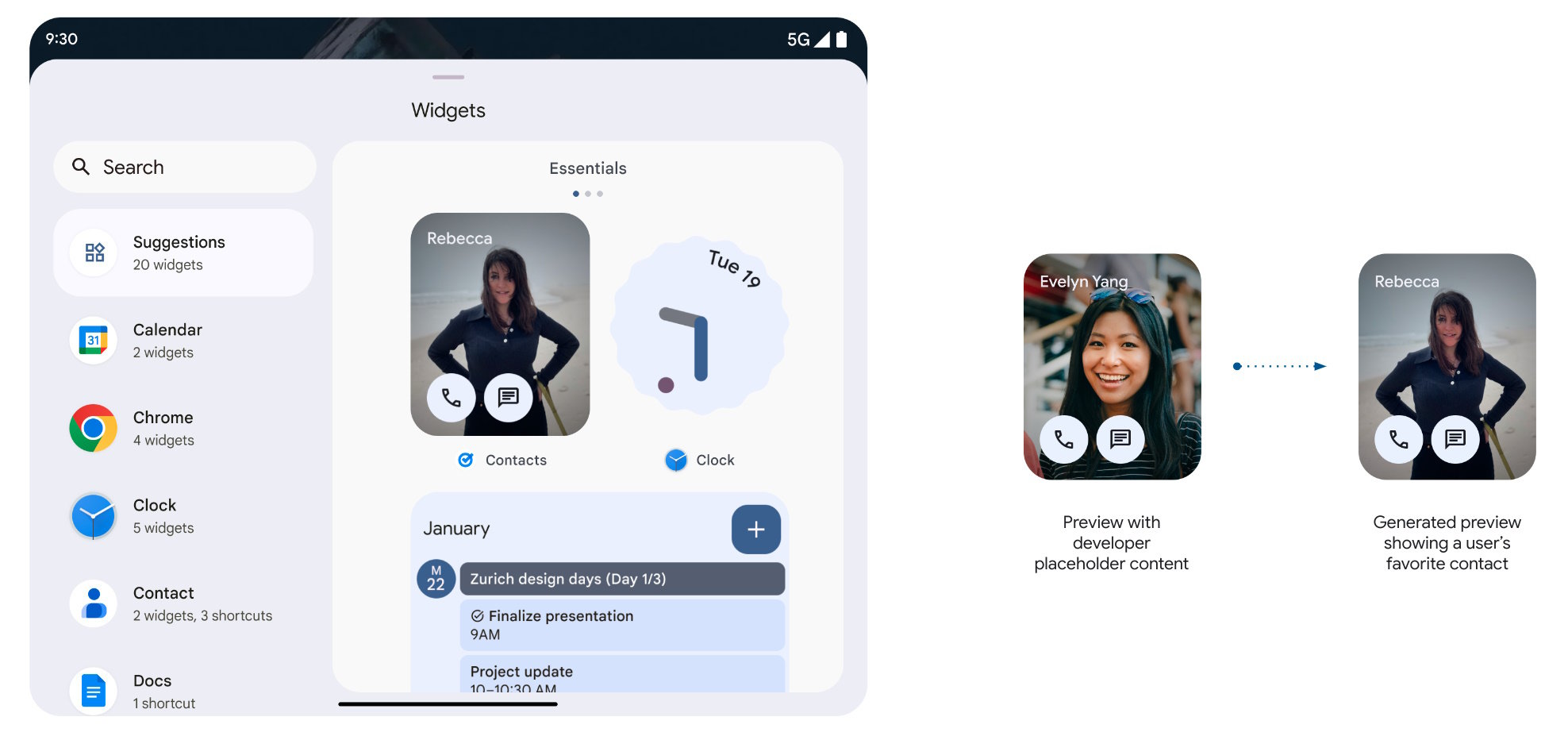
App developers can now add personalized previews for their app’s widgets with Android 15 Beta 2. This way, when a user is at the widget selector, they will see a widget that is more representative of what the actual output would be.
Bluetooth auto-on
Google is upgrading Android’s Find My Device network to leverage the wide network of Android devices. This upgrade relies on Bluetooth beacons from participating devices to locate other nearby devices. However, if participating devices have their Bluetooth switched off, the network will lose efficacy.
Android 15 Beta 2 includes a “Bluetooth auto-on” toggle. When selected, this temporarily pauses the Bluetooth radio and switches it back on the next day instead of disabling it until the next time the user toggles it.
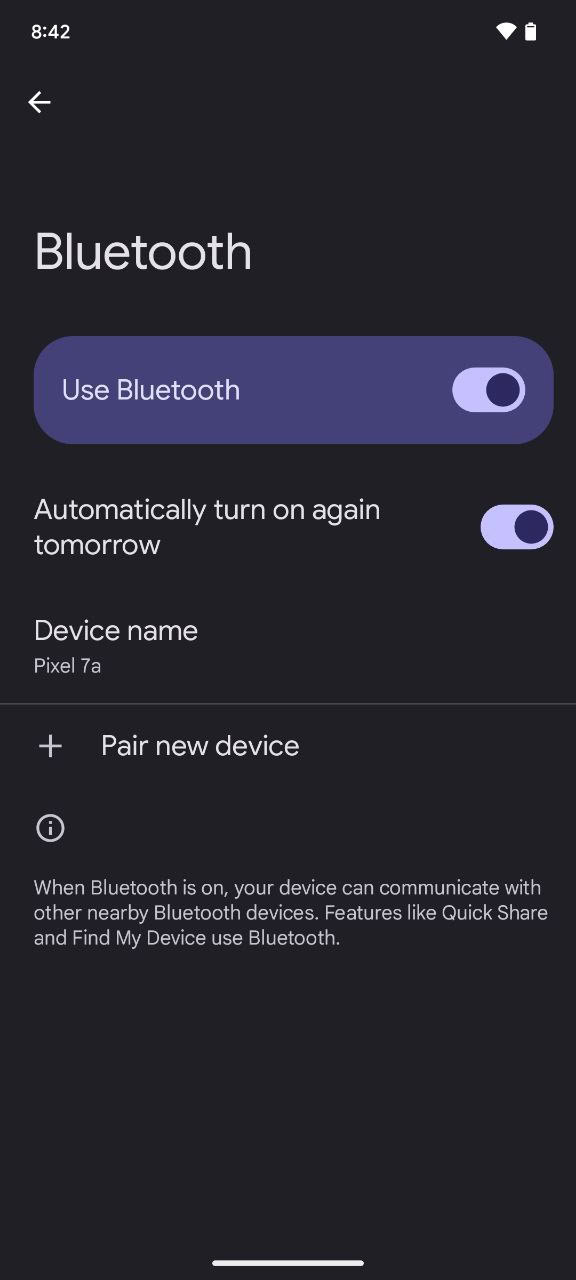
On iPhones, toggling Bluetooth or Wi-Fi from the Control Centre (aka the quick settings panel) merely disconnects accessories until the next day. It does not disable the radios, and both Bluetooth and Wi-Fi continue to remain available for Apple ecosystem features. To disable the radios, you need to toggle Bluetooth and Wi-Fi from the Settings app. So Google could have been partly inspired from here.
Adaptive vibration
Android 15 Beta 2 on Pixel devices includes a new Adaptive Vibration setting present in Settings > Sound & vibration > Vibration & haptics.
According to its description, adaptive vibration “automatically adjusts your phone’s vibrations based on your environment.” It does this by using your phone’s “microphone and other sensors” to “determine sound levels and context.” To preserve privacy, “no data is recorded.”
Android includes a helpful animation on the adaptive vibration page that explains what the feature does. The animation shows that, when the feature is enabled, your phone’s haptics will vibrate more intensely when your phone is on a couch and less intensely when it’s on a table. This makes sense, since the cushions on a couch can dampen your phone’s vibrations, so it needs to vibrate harder to compensate. On the other hand, your phone’s vibrations can cause other objects on a table to rustle, so reducing the intensity of the haptic motor might be necessary.
New color contrast settings
Android 15 Beta 2 adds a new “color contrast” settings page to Settings > Wallpaper & style. This page lets the user adjust the contrast of text, buttons, and icons to make them stand out more in apps.
Set Google Account photo as avatar
Android 15 Beta 2 includes a new Google Pixel Avatar App, an unbundled version of the existing avatar picker that is found in Settings > System > Multiple users. However, this app adds a new feature: the ability to use your current Google Account picture as your profile picture.
When you select your Google Account picture as your Android profile picture, your current Google Account picture is shown in the top row next to the camera and gallery icons, and it’s distinguished with a “G” logo.
Lockdown mode prevents juice jacking
Lockdown mode was introduced with Android 9 Pie in 2018. When you enter lockdown mode, your phone’s notifications are hidden, and all forms of authentication except for the user’s primary authentication (PIN, password, or pattern) are disabled.
In Android 15, Lockdown mode helps prevent juice jacking by immediately disabling USB data access.
Home controls screensaver
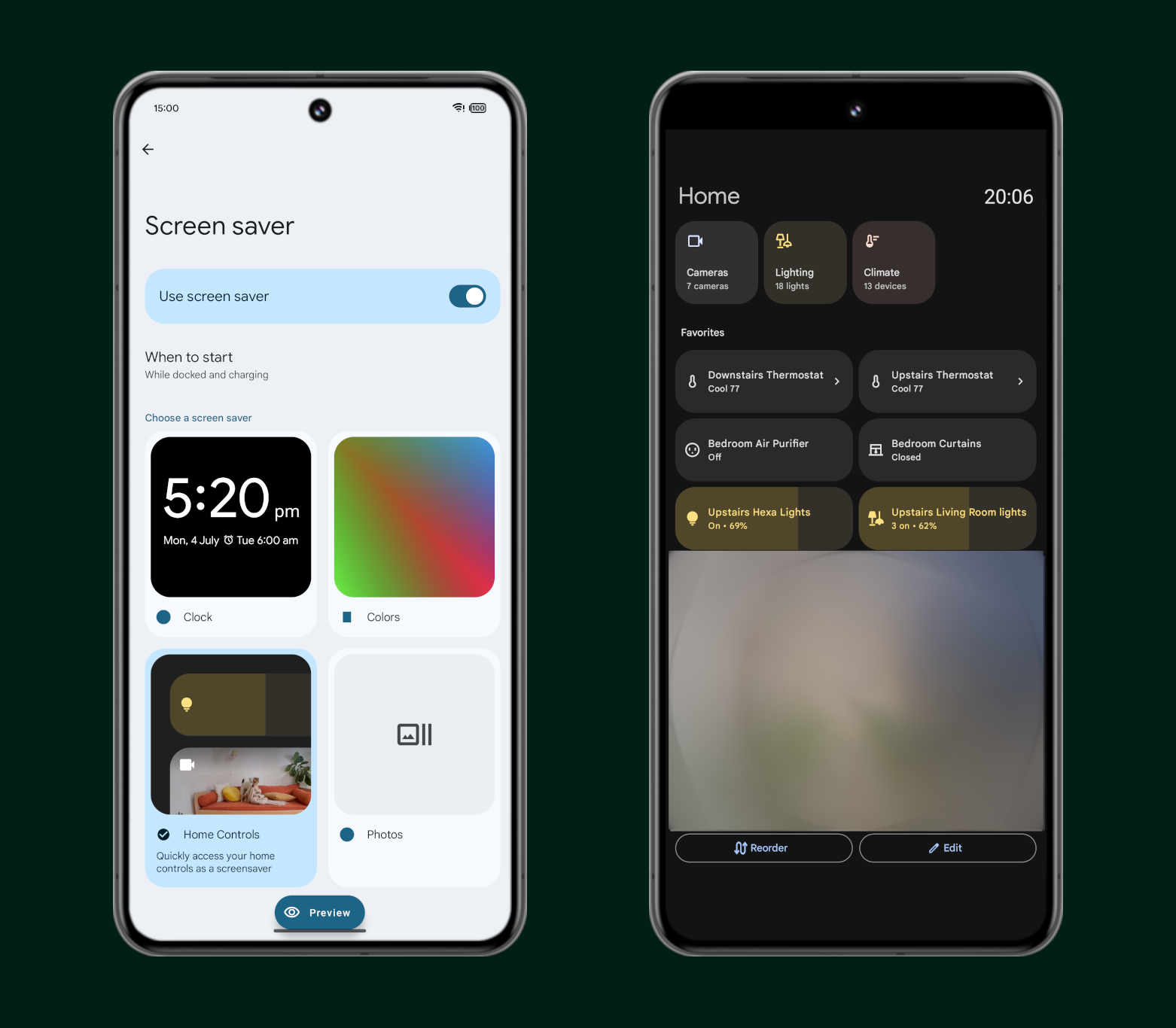
Android 15 Beta 3 has added a screensaver called “Home Controls” that lets you control your Google Home devices when your device is idle and charging.
This screensaver simply shows the Google Home controls that you have favorited and the current time. The UI is even the same as the one that appears in Android 14 when you set the Google Home app as Android’s Device Controls provider and open the smart home controls dashboard via the aforementioned Quick Setting tile or lock screen shortcut.
New Device Diagnostics menu in Settings app
Google has added a dedicated Device Diagnostics menu to the Settings app on Android 15, which allows you to run manual tests and check the health of your phone’s internal components. Component health lets you “run manual tests and view battery and storage health.” Evaluation mode lets you “use one device to assess another device.”
Under the Component health page, you can run a display test that shows a series of differently colored screens, making it easy to inspect the screen for defects visually. You can also run a touch test that shows a red screen turning white as you swipe your finger over it, giving an obvious indicator of where touch input may be broken.
The Component health screen lets you check the health of your phone’s battery and storage chip. The battery status page shows you the remaining capacity of your phone’s battery as a percentage of its original capacity, the manufacturing date of your phone’s battery, its first usage date, and its charging cycle count. It also has fields for the serial number and part status. The storage status page, meanwhile, shows you the remaining lifetime of your phone’s storage chip as well as its total capacity.
Evaluation mode requires a secondary, trusted device to assess the device under evaluation. The device being assessed needs to tap Evaluated device to generate a QR code that the other device can scan. Doing so will run a series of tests on the device being evaluated, some of which require internet access. These tests consist of the same display and touch test from before. Completing these tests generates a report that can be evaluated to see if there are any issues with the device.
While the device diagnostics page doesn’t provide a lot of information or test every component, it could save some folks a lot of hassle, especially those whose issues stem from their device’s display/touch screen, battery, or storage. This feature is available to users with Android 15 Beta 4.
Hidden space-themed screen saver
Android 15 has a hidden Landroid spaceship game as an easter egg, but there’s also a second easter egg in the form of a new Landroid screensaver (h/t Dylan Roussel). This becomes available after you access the spaceship game for the first time on Android 15. The screen saver mimics the game, with the little spacecraft visiting planets and landing on them.
Smaller changes
There are a few smaller changes as well that have been either announced by Google officially or spotted on Android 15 builds so far:
- There is haptic feedback when adjusting the display brightness through the Quick Settings slider (h/t Mishaal Rahman).
- New APIs allow smoother NFC experiences by allowing devices to listen but not respond to NFC readers. In some cases, this would allow for a one-tap transaction.
- Android has a new PDFRenderer API, which allows apps to render password-protected PDF files and annotations, as well as form editing, searching, and selection with copy.
- The Pixel Launcher has a new “apps list settings” page that contains the “swipe to start search” settings toggle (h/t Mishaal Rahman).
- Android 15 Beta 3 houses a new “show long app names” setting that lets you display long app names on two lines in the search results and apps list.
- New accessibility settings for use with physical keyboards: You can enable Sticky keys, Slow keys, and Bounce keys when you are using a physical keyboard on a device with Android 15. This feature will be useful for users with motor disabilities and those who face difficulties typing on a physical keyboard.
- Sticky keys make it easier to enter keyboard shortcuts in quick succession.
- Slow keys hold down the duration that the user has to press before the system accepts a keypress.
- Bounce keys help ignore rapid, repeated presses of the same key.
- Android 15 also shows a preview of the keyboard layout that you select in physical keyboard settings, in case your physical keyboard has a different physical layout.
- Android TalkBack is gaining support for Braille displays, which use human interface devices over USB and Bluetooth to improve accessibility.
- You can now set a wallet app as a default, allowing you to set something other than Google Wallet as your default wallet service.
- The Android system now lets you set how it addresses you in gendered languages, starting with French.
- Android 15 Beta 2 includes API-related updates from ICU 74. ICU 74 contains updates from Unicode 15.1, including new characters, emoji, security mechanisms, and corresponding APIs and implementations. It also includes updates to CLDR 44 locale data with new locales and various additions and corrections.
- The font file for Chinese, Japanese, and Korean languages, aka the NotoSansCJK, is now a variable font, allowing many weight and other variations.
- There is a new font file for old Japanese Hiragana called Japanese Hentaigana.
- Android 15 Beta 2 supports setting rich vibrations for incoming notifications by channel. This allows users to distinguish between different types of notifications without having to look at their devices.
- The USB debugging/Android System icon has been updated in Android 15 Beta 2 (h/t Mishaal Rahman). The upside-down logo has been replaced with a V shape to reflect the internal dessert name, Vanilla Ice Cream.
- In Android 15 Beta 2, under Settings > Storage, there’s no longer a “System” option. Instead, there’s a “System” header that splits into the “OS” and “temporary system files.” This may somewhat reduce confusion about how much space system files take up. Unrecognized files will still be seen as “temporary system files,” though (h/t Mishaal Rahman).
- Android 15 Beta 2 makes it easier to understand your storage, as it splits the broad “System” category into an “OS” category and a “Temporary system files” category (h/t Mishaal Rahman).
- Android 15 Beta 2 brings back the ability for Pixel devices to control the volume of Google Home speaker groups while casting.
- Killing an app by force-stopping it will now also temporarily disable its home screen widget. The widgets will also be grayed out on the home screen and won’t restart until you manually launch the app again, directly or indirectly.
- Android 15 Beta 3 adds single-step passkey support that allows app developers to easily incorporate biometric security (fingerprint or face unlock) for signing into their apps.
- Android 15 Beta 4 tweaks the battery widget’s UI on Pixel devices to integrate Material You’s Dynamic Coloring.
Android 15 performance improvements
Improvements to the Android Dynamic Performance Framework

Android 15 continues work in the Android Dynamic Performance Framework (ADPF). ADPF is a set of APIs that allow games and performance-intensive apps to interact more directly with the power and thermal systems of Android devices. With these APIs, you can monitor system behavior better and then go a step further to optimize performance to a sustainable level that doesn’t overheat devices.
ADPF consists of these main features:
- Thermal-state monitoring
- CPU performance hints
- Fixed-performance mode
On supported devices, Android 15 will add new ADPF capabilities, namely:
- A power efficiency mode for hint sessions to indicate that their associated threads should prefer power saving over performance. This is said to be good for long-running background workloads.
- Hint sessions can now report CPU and GPU work durations, allowing the system to adjust CPU and GPU frequencies together to best meet workload demands.
- New thermal headroom thresholds to interpret possible thermal throttling status based on headroom prediction.
App and game developers can use these APIs to make their apps and games work better on devices that would support these APIs.
App archiving through Settings
iOS has a handy feature that lets you “offload apps” to reclaim some storage space. You can uninstall apps you use rarely but keep the user data around. So when you reinstall the app, you can get back where you left off.
With Android 15 Developer Preview 2, Google baked in a similar app archiving feature. It then formally announced the feature with the launch of the first Android 15 beta, all but assuring us that this feature will launch.
When an app is archived on Android, most of its working files will be removed, while a stripped-down version of the app will be retained. There will be a home screen icon which, when clicked, will trigger the Google Play Store to unarchive the app.
Google already lets you opt into auto-archiving through the Google Play Store. Since the feature is run through the Play Store, you cannot archive or unarchive apps through your phone’s Settings app.

Android 15 changes this behavior by adding a new Archive and Restore button on the App Info page.
This way, even apps installed from outside of the Play Store could be archived from an easily accessible location.
Here is a good demo of how the app archive feature within the Android system works.
In this demo, an app that is 387MB in size has been archived to just 18MB in size, a staggering 95% decrease. After the archive, the app was restored to show that none of the user data was lost in the process.
Android 15 will not only let you manually archive apps but also let you choose whether to have the OS automatically archive apps that you do not use often. Further, other app stores beyond the Google Play Store will also be able to get the feature working if they support the necessary app formats.
Locking WebView into memory
Android 15 is locking into memory the trichrome library that Android System WebView uses, with the release of Developer Preview 1. Many apps use Android System WebView to display internet content, as it helps them avoid building a web browser from scratch for such a task. Since the process is locked into memory, the Android system will deprioritize killing the process during regular RAM management operations.
In theory, apps that rely on WebView could see a marginal improvement in their performance to the extent of their use of WebView, especially on devices with less RAM where processes are more frequently purged from RAM.
ANGLE: Optional layer for running OpenGL ES on top of Vulkan
OpenGL and Vulkan are the two popular graphics APIs currently in use, while OpenGL ES is the variant used on embedded systems like mobile devices. Most popular Android games now use Vulkan for its superior features and performance, but some legacy games still use OpenGL ES for some of their rendering tasks.
Vulkan is Android’s preferred interface to the GPU and will remain so. Therefore, with Android 15 Beta 2, Google includes ANGLE, a translation layer that converts OpenGL ES API calls to Vulkan.

ANGLE will also become the default driver on many 2025 devices for OpenGL ES interfacing, and beyond 2026, it will be the only way available.
Google clarifies that it plans to continue supporting OpenGL ES on all devices, but it strongly encourages the use of Vulkan for new projects.
More efficient AV1 software decoding
dav1d, the popular AV1 software decoder from VideoLAN is now available for Android devices not supporting AV1 decode in hardware. It is said to be up to 3x more performant than the legacy AV1 software decoder, enabling HD AV1 playback for more users, including some low and mid-tier devices.
For now, Google says that apps need to opt-in to using dav1d by invoking it with the name “c2.android.av1-dav1d.decoder.” Subsequent updates will make it the default AV1 software decoder. This support is standardized and backported to Android 11 devices that receive Google Play system updates, so it’s not a part of Android 15 per-se, but was announced in the Beta 2 announcement.
Better standby battery life
At Google I/O, Dave Burke, VP of Engineering for the Android Platform, mentioned in an interview that in Android 15, Google has sped up the time to doze by 50%. This means that devices running Android 15 will enter doze mode 50% faster than they do in Android 14. The result is an improvement in standby battery life, up to three hours on some devices that Google tested.
Android tries to intelligently defer and run as many background tasks at the same time during select ‘maintenance windows’ while the device is in a state where it’s been idle for a period of time and its screen is off. This state — called doze mode — has been a core feature of Android’s power management system since Android 6.0.
This change will extend to all devices that get updated to Android 15, including alternate platforms beyond smartphones.
Smaller changes
- Android 15 has new APIs that allow apps to track their app startup and stop state, display their detailed app size information, and more.
- There is a new “disable default frame rate for games” setting in Developer Options that disables limiting the maximum frame rate for games at 60Hz.
- Apps optimized for Android 15 will now be edge-to-edge by default. This means that developers won’t have to call on additional classes to show their content beyond system bars.
- Android 15 Beta 2 allows app developers to quickly toggle the visibility of irrelevant UI elements for a PiP window, ensuring a smoother and flicker-free PiP entry animation.
- Two common foreground service types now have a ~6-hour timeout, after which the service is no longer considered a foreground service. Further, Beta 2 also now requires apps to have a visible overlay if it is attempting to start a foreground service with a permission exemption for background start.
- Android 15 adds support for devices that use larger page sizes, including 16 KB pages in addition to the standard 4 KB pages. Devices with larger page sizes can have improved performance for memory-intensive workloads.
Android 15 privacy and security features
Privacy Sandbox on Android
One of the highlights of the Android 15 update is that it incorporates the latest version of the Privacy Sandbox on Android.
Privacy Sandbox on Android is a multi-year initiative from Google that introduces more private advertising solutions that limit the sharing of user data with third parties and operate without cross-app identifiers. The goal here is to develop an effective and privacy-enhancing advertising solution where user information is protected. This is needed to cultivate a healthy app ecosystem, which is needed for the overall health of the Android platform.
File integrity
Android 15 introduces a new FileIntegrityManager API that uses a feature called “fs-verity” in the Linux kernel. With fs-verity, files can be protected by custom cryptographic signatures, ensuring that they do not get tampered with or corrupted. So app developers can rest easy knowing that their app functionality and data are not compromised in any way.
Screen record detection
Android 15 will allow apps to detect when they are being screen-recorded. For apps that perform sensitive operations, developers can invoke APIs to allow the content to be hidden within such screen recordings.
End-to-end encryption of contact keys
The first beta introduced an OS-level API that provides end-to-end encryption for contact keys. This feature allows the user to manage and verify other people’s contact information securely.
As we learned in an APK teardown, the Contact Keys feature will rely heavily on the Google Contacts app for its UX. Users who want to confirm that all their E2E apps are actually encrypted can scan the QR code present on the other person’s Google Contacts app. Alternatively, you could also compare the app-specific numbers instead to reassure yourself about the encryption status.
Apple has a similar feature on iOS called Contact Key Verification, which was added in iOS 17.2. Contact Key Verification lets you receive automatic alerts that help verify that you are communicating only with the people you intend to communicate with. By verifying the encryption status, you can reassure yourself that you are not being targeted by any sophisticated cyber attack.
Private Space
We discovered Private Space a long time back as an upcoming Android 15 feature, and even showed off a hands-on of Private Space at the time. With Android 15 Beta 2, Google is officially announcing Private Space as a feature. The feature appears to be similar to Samsung’s Secure Folder, removing the need to use third-party apps to hide other apps on your Android phone.
Private space allows users to create a separate space for sensitive apps on their device, protecting these apps with an additional layer of authentication. This feature uses a separate user profile which is paused (and the apps are no longer active) when the private space is locked. The user can choose to use the device lock or a separate lock factor for private space. The feature is available at Settings > Security & privacy > Private space.
Private space apps appear in a separate container in the launcher. When the space is locked, the apps are hidden from recent view, notifications, settings, and other apps. Further, user-generated and downloaded content and accounts are separated between the private space and the main space. The system share sheet and the photo picker can be used to give apps access to content across spaces when private space is unlocked.
As we know from previous hands-on, users will be able to automatically lock their private space, change the screen lock, automatically hide private space from appearing in the app list, make sensitive notifications appear on the lock screen when private space is unlocked, or delete the private space. You can also quickly install an app in your private space through the Pixel Launcher by tapping on a button in your primary profile.
Target SDK version raised, making older Android Marshmallow apps incompatible
Google introduces new APIs and features with every Android release and banks on developers keeping their apps updated with these new APIs and best practices. However, older apps still exist, and developers may not be keen to keep them updated for various reasons. Regular users still need to be protected against the drawbacks of outdated APIs, so the Google Play Store hides older apps from users. Users could still sideload them, but Android 14 began blocking sideloading apps that were built for Android 6.0 Marshmallow, i.e. with a target SDK version 23.
With Android 15 Beta 2, Google has raised this target SDK version to 24. This means that apps targeting APIs for Android 6.0 Marshmallow will not be easy to install, and you’d need to default to apps built for Android 7.0 Nougat at least.
Smaller changes
- On Android 15, you now have to authenticate your identity using the fingerprint sensor or other lock screen security options if you want to change the USB mode on your phone when it is connected to a computer.
- If you head to Settings > Security & privacy > More security & privacy, you can toggle on two new security features: “security notifications” and “require encryption.” These will help protect you against “stingray” hacks. You can find out more about this in our deep dive into Android 15’s anti-stingray protections.
- WEP is an older security protocol for Wi-Fi that is not as secure as modern methods. Android 15 will put a toggle at Settings > Network & Internet > Internet > Network preferences that will allow you to disable connections to networks that use WEP.
- Malicious apps within the same task can launch another app’s activity and then overlay themselves on top, creating the illusion of being that app. This “task hijacking” attack bypasses current background launch restrictions because it all occurs within the same visible task. To mitigate this risk, Google has added a flag in Android 15 Beta 2 that blocks apps that don’t match the top UID on the stack from launching activities.
- With Android 15 Beta 2, apps can now highlight only the most recently selected photos and videos when partial access to media permissions is granted. This can improve the user experience for apps that frequently request access to photos and videos.
Android 15: Leaked and upcoming features
In addition to all the features that Google has officially announced, and those that have been spotted in the Android 15 Developer Preview and Beta builds, there are plenty of changes that have been leaked and are rumored to arrive on Android 15.
Satellite Messaging with T-Mobile
Google has confirmed that satellite messaging support is coming to Android 15. However, we don’t know much about how this will actually work. Based on what we know so far, T-Mobile (in conjunction with partner Starlink) might offer a paid subscription that would allow you to send satellite messages natively in the Messages app. These messages would work anywhere as long as you have a view of the open sky. Even if there are zero cell towers around, you could still text with your friends (for a price).
This is what the Satellite Messaging page within Android 15 looks like as it went live for some Pixel users on T-Mobile:
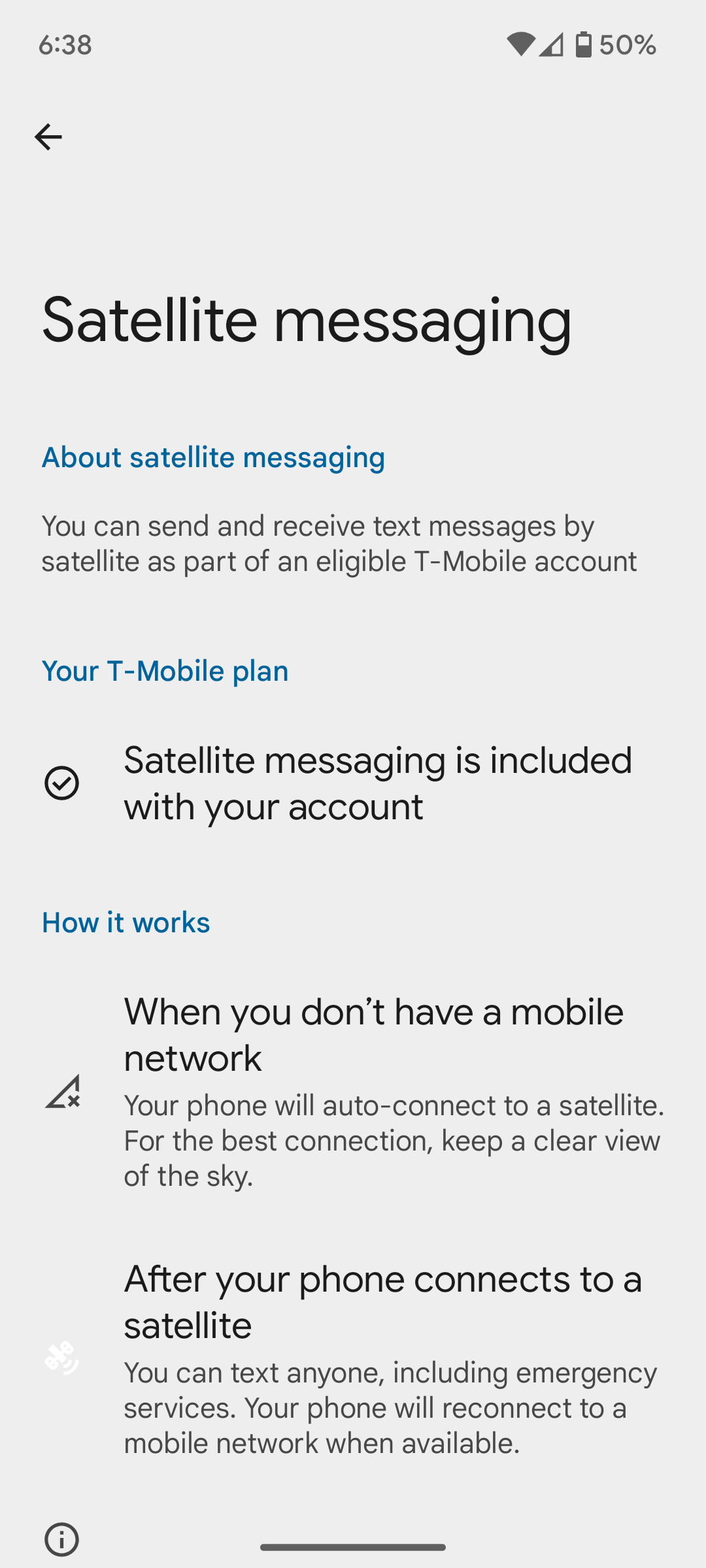
While recent iPhones have access to free satellite messaging, they can only be used in emergencies to contact help. Android users being able to use them for whatever they want would be a major win. We’re waiting for the satellite pointing UI to go live, which is expected closer to when the Pixel 9 launches later in the year.
Revamped status bar with new icons and haptics
Google could refresh Android’s status bar icons with a new look and add haptic feedback to the Quick Settings and volume panels. The changes are not live yet.
With Android 15, some of the status bar icons may feature a segmented design. The battery icon may also finally support showing the current battery level inside the icon rather than to the right of it.
The charging chip which appears when you plug in your device is also being updated.
Users will be able to disable the battery level if they don’t like it. Here is what it will look like without the battery level.
Android 15 may also add haptic feedback to the Quick Settings panel, such as when users long-press on tiles such as the Bluetooth tile. There will also be some haptic feedback when moving the volume slider to adjust the volume stream.
Reorganized Settings app
We expect the Settings app on Android 15 to be reorganized, with several top-level menu items being placed next to each other in visually distinct sections.
For reference, here’s the order of entries of the top-level settings page in Android 14 on Pixel phones, next to how the top-level settings page might be arranged in a future Android 15 release:
Android 14 top-level settings layout (current):
- Network & internet
- Hub mode (Pixel Tablet only)
- Connected devices
- Apps
- Notifications
- Battery
- Storage
- Sound & vibration
- Display
- Wallpaper & style
- Accessibility
- Security & privacy
- Location
- Safety & emergency
- Passwords, passkeys & autofill
- Digital Wellbeing & parental controls
- System
- About phone
- Tips & support
Android 15 top-level settings page (upcoming):
- Network & internet
- Connected devices
— - Apps
- Notifications
- Sound & vibration
- Hub mode (Pixel Tablet only)
- Display
- Wallpaper & style
— - Storage
- Battery
- System
- About phone
— - Security & privacy
- Location
- Passwords, passkeys & accounts
— - Safety & emergency
- Accessibility
- Tips & support
Here are screenshots showing the top-level settings in Android 14 next to a mockup of what we believe the top-level settings page will look like in an upcoming Android 15 release.
This should be more logical for users to follow.
Optimized landscape layouts for lockscreen and notification panel on phones
Android phones are primarily meant for portrait orientations, and the Android UI is optimized for that purpose. When you attempt to use a phone in landscape orientation, you will notice elements like the notification panel poorly using space, while the lockscreen will refuse to rotate.
We managed to enable an optimized landscape layout for the notification panel and lockscreen in Android 15 for use on phones. The optimized notification panel on Android 15 looks like a shrunk-down version of the same on tablets, with a lot less wasted space.
Similarly, the optimized landscape mode layout for phones’ lock screens looks similar to the one for tablets.
These layouts are still buggy and unfinished, but they are quite evidently improvements over Android 14.
Notification cooldown
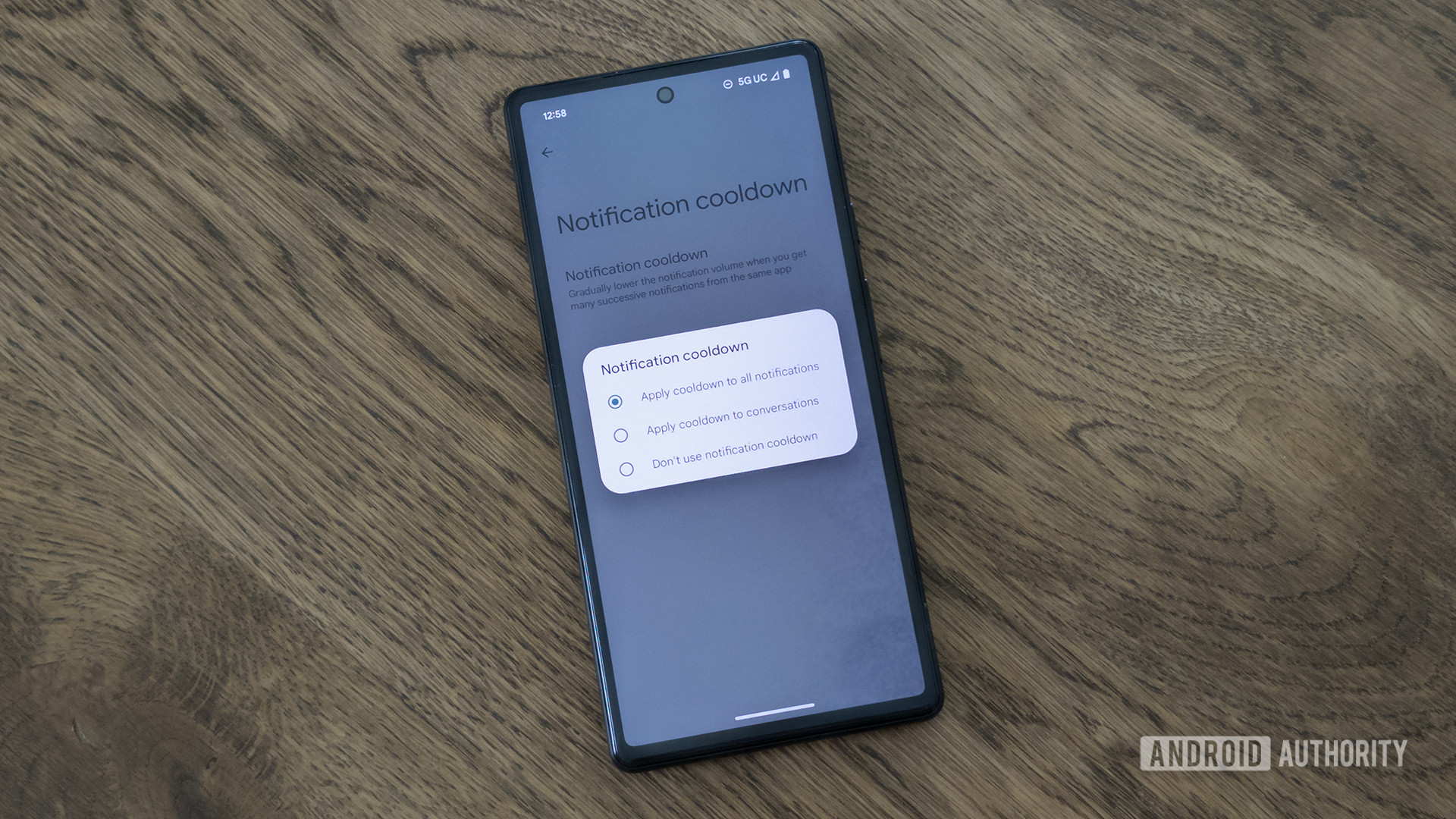
There’s a new function within the Notifications section called “Notification cooldown.” It lowers the volume of successive notifications from the same app. It’s designed to prevent users from being overwhelmed by too many notifications.
While we spotted this feature in the first Android 15 Developer Preview, the first beta hid the feature below the surface. It’s possible Google wants to let this feature cook a bit longer before releasing it to the public.
In newer builds, we also spotted a new toggle called “vibrate when unlocked.” According to the description, this toggle makes it so your phone will “only vibrate when [the] screen is unlocked.”
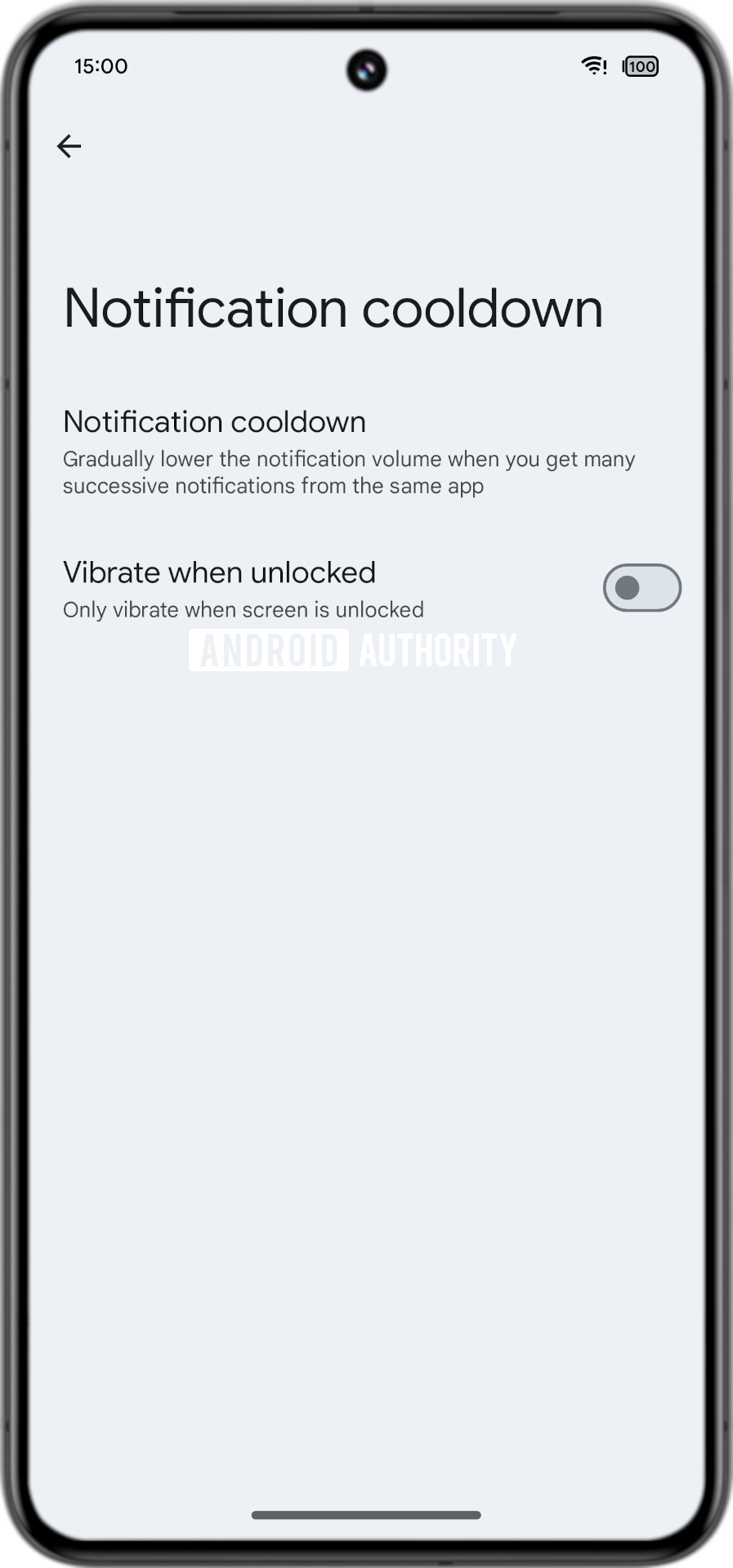
In other words, enabling this toggle should prevent your phone from vibrating in your pocket when you receive a ton of successive notifications from the same app.
Compact heads-up notification
Google introduced heads-up notifications with Android 5.0 Lollipop in 2014. These notifications appear in a floating window at the top of the screen and can be immediately seen and acted upon, regardless of the app you’re using. This notification style is meant for high-priority notifications, but they can get quite distracting when they appear over a full-screen app.
Android lets you opt out of heads-up notifications on a per-channel basis, and you can use ADB to disable them entirely on many Android versions. However, if you’re only bothered by their distracting size when using a full-screen app, then Google has another solution for you: Compact heads-up notifications.
We found clues for these in the Android 15 Beta 4 release and managed to enable the compact heads-up notification feature.
You can see the compact layout in the second set of notifications. This change is not live yet in Android 15, and since it was spotted after the platform stability phase, it is unlikely to ship with Android 15 at launch. Instead, it could come with a future Android 15 QPR release, or even get pushed to Android 16.
Lock screen widgets for tablets, At a Glance widget for phones
Android supported lock screen widgets with Android 4.2 Jelly Bean, but the feature was killed off in Android 5.0 Lollipop. Since iOS brought lock screen widgets with iOS 16, Android will bring widgets back to the lock screen with Android 15.
However, recent evidence suggests this will only apply to tablets, and possibly only the Pixel Tablet. We need more information to be certain, but that’s the way things are looking right now.
The lockscreen widget has also evolved with newer Android 15 betas, as Google fixed two major issues. The first major issue was that certain lock screen UI elements, like the clock, were overlaid on top of the widgets page, visually obstructing some of your widgets. The second issue was that the widgets couldn’t be interacted with, meaning they were only useful if they showed relevant information at a glance. Both of these were fixed with Android 15 Beta 3 release.
As you can see in the video, there’s now a long, vertical pill on the right edge that’s similar in size and color to the navigation pill. This serves as a visual indicator that you can swipe inward on the right edge. Swiping inward reveals that the lock screen and glanceable hub no longer visually overlap. By default, the only button that appears on the glanceable hub is a button to change the current profile; the button to customize the glanceable hub is only shown when you long press on an empty space.
Up to six widgets can be shown on a single page at a time, though since the glanceable hub is horizontally scrollable, you can add more widgets than that. You still can’t resize widgets, unfortunately, but you can interact with them.
For phones, it seems Google is taking some inspiration from iOS’ Live Activities and giving Android a similar implementation. There are plenty of challenges involved, but the At a Glance widget could be the widget of choice on the lockscreen of Android phones.
As you can see above, we managed to activate the At a Glance widget on the lockscreen on Android 15 with some tinkering. We also got it to appear at the bottom, which is where it looks very Live Activity-like. The lockscreen does appear very busy with the widget enabled, so there is a lot of cleanup and testing that Google needs to do to bring widgets back to phone lockscreens. Consequently, there’s a chance phones get their lockscreen widgets with Android 16.
There’s no evidence of Google considering lockscreen widgets for phones. However, we managed to activate lockscreen widgets on an Android 15 phone anyway, and this is what it looks like:
“Tiny” taskbar for phones
Android’s taskbar is largely accessible to foldables and tablets, but Google is also working on a version that could be accessible to smaller-screen devices, such as smartphones. We spotted the tiny taskbar in Android 15 Beta 4 and managed to activate it.
The tiny taskbar looks and behaves the same as the taskbar for large-screen devices. Since the feature was spotted after Android 15 reached platform stability, it may be included in a future Android 15 QPR release.
Battery health percentage

Android 14 laid the groundwork for the OS to track battery health information, while Android 15 could make battery health information accessible to users. The OS could show the estimated percentage of charge your phone’s battery can currently hold compared to when it was new. This would give users a clearer idea of how far their battery has degraded.
There are many variables involved in this feature’s release, though we cross our fingers and remain optimistic. iPhones already report their battery health in an easy-to-read manner, and that information has been valuable to users in deciding the condition of pre-owned units and whether they should get their batteries replaced.
Storage chip health
In addition to battery health information, Android 15 is also preparing a new feature that will tell users the remaining lifetime of their device’s internal storage. Under the hood, the Device Diagnostics app will utilize a new storage lifetime API in Android 15 that “returns the remaining lifetime of the internal storage device, as an integer percentage.”
However, only some devices are expected to report the remaining storage lifetime with 1% granularity. Most will report it at a less accurate 10% granularity, if at all they support the feature (as Google doesn’t require devices to support it).
Powered Off Finding API will let you find devices even when they are switched off
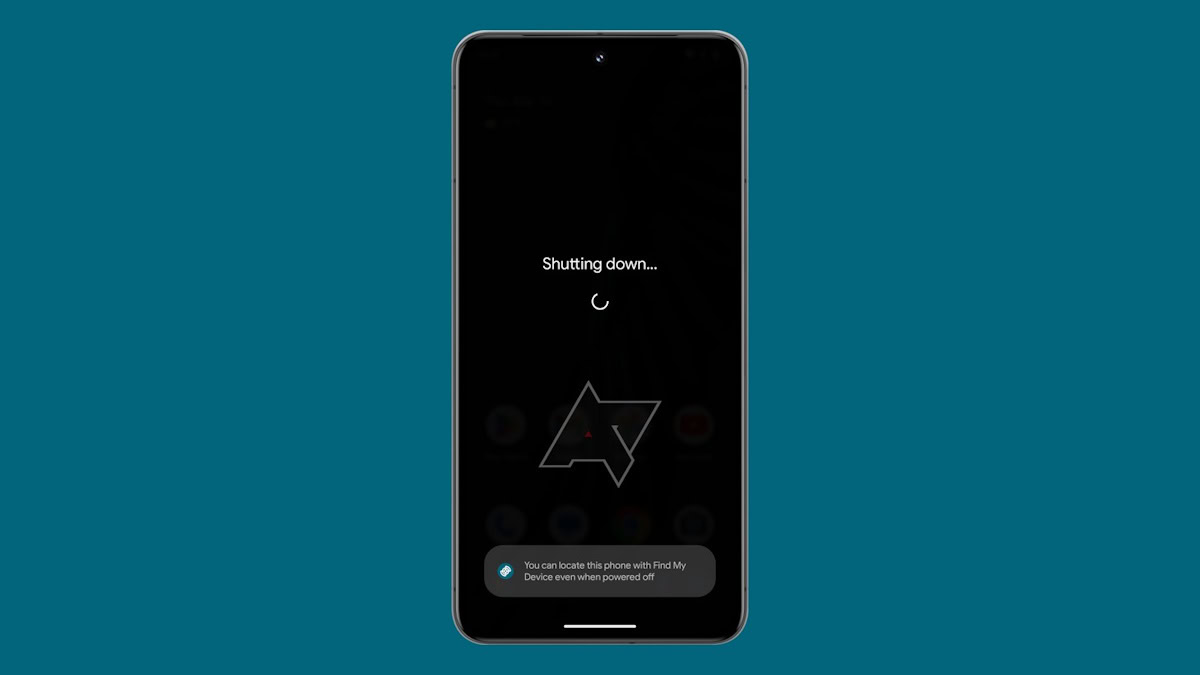
Android 15 will add the new Powered Off Finding API, which will enable powered-off finding across compatible Android devices, according to a report. These APIs would be contained within the Project Mainline module called “Tethering,” which can only be used on devices running Android 15. Further, this API will be utilized by the upgraded Find My Device network, which will be rolled out through Google Play Services.
What Powered Off Finding API does is that it allows a device to fire off precomputed Bluetooth beacons, even when the device is off (presuming there is some reserve power available for this action). With these Bluetooth beacons, nearby Android devices will be able to help track the switched-off device, similar to how iPhones can be tracked when they are powered off.
This feature would need hardware support to allow the Bluetooth controller to work when the rest of the device is powered off. The feature also requires the phone to support the Bluetooth Finder HAL so that Android can enable Powered Off Finding mode.
The feature is expected to debut with the Google Pixel 9, but it could also make its way to the Pixel 8 series as the devices include the necessary hardware.
Voice activation feature for digital assistants

Android allows any app to become the default assistant app on your device, but it doesn’t let them use wake words like “Hey Google” in the background. Your phone would have to constantly listen to audio through the microphone in order to pick up the designated wake word.
Android 15 could introduce a new feature called “voice activation” that could use a privacy-preserving “adaptive sensing” technology to let other digital assistant apps use wake words.

Previous versions of Android allowed wake word detection, but Google removed the feature with Android 12. This upcoming feature could bring back the functionality, letting apps like ChatGPT and Amazon Alexa become accessible with a wake word, even when your phone’s screen is off. Pre-Android 15, only Google Assistant and Bixby on Samsung phones allow for hands-free voice activation through a wake word.
Desktop mode: Enhanced windowing capabilities
With Android 15, Google could improve the windowing capabilities of Android’s desktop mode. In desktop mode, app windows could get a small handle that will show a small menu. This menu will contain the app’s name and icon, as well as three buttons to open the window in full-screen, split-screen, or freeform mode.
In freeform mode, the app will get a title bar that shows the app’s name and icon, a dropdown to open the menu to change the windowing mode, a maximize button, and a close button. The window can be freely moved around and resized. Resizing the window temporarily hides the app’s content to make it easier to see the window as it’s being resized. Windows can be dragged to the left or right edge to snap them to that half. Once an app is full-screened, you can drag instead of tap the handle at the top to quickly turn the window into a freeform or split-screen one.
Independent desktop mode for tablets
Desktop mode allows the smartphone to launch freeform windows and other extended capabilities when the phone is connected to an external display. Google is also working on an independent desktop mode for tablets that doesn’t require them to connect to an external display.
As you can see in the video, a new “desktop” button can appear when you tap the dropdown menu in the recents screen. Tapping the “desktop” button launches the app in a freeform window in Android’s desktop mode environment. Here, the window can be moved, snapped to the side, resized, minimized, maximized, or joined by other app windows.
When the desktop mode is active, and you return to the home screen, you can reenter the environment by tapping on the “desktop” card in the recents screen or by opening an app, expanding its window caption, and then tapping on the button to launch it in a freeform window.
This feature was spotted in Android 15 Beta 4.1, so it’s not coming with stable Android 15 at least. It could make its way to a future Android 15 QPR or be pushed to Android 16.
New Pixel Launcher features
Google is preparing a bunch of changes specifically for the Pixel Launcher with the Android 15 update. These are the new features coming to the Pixel Launcher with Android 15:
- New animation when swiping up on an app to return to the home screen.
- Better widget recommendations across recommendation categories: Essentials, Social, Entertainment, Health and Fitness, News and magazines, Weather, Suggested for You, and Your Chill Zone.
- A “+ Add” button in the widget selector to make it easier to add widgets to home screen.
- A new pill in the Recents menu opens shortcuts for the app, namely the app info page, entering split screen mode, and pausing an app.
- The ability to stop app names from being truncated and show long app names.
- The ability to use Circle to Search when using apps in split screen mode.
These changes have been spotted through feature flags. There is a chance that not all of them will make it to Android 15. It also remains to be seen how many of them get carried over to the AOSP Launcher as the Pixel Launcher is Pixel-specific.
Google AI features for the Pixel 9
Google is planning to launch Google AI features with the Pixel 9 and debut them with Android 15. However, these features aren’t likely to come to the Android platform at large.
Google AI will include existing AI features such as Circle to Search and Gemini, but it will also include new features such as Add Me, Studio, and Pixel Screenshots.
Easy pre-set mode to improve readability and ease of navigation
Strings within past Android builds indicate that Google has been working on a feature called “easy pre-set mode,” which could arrive with Android 15’s later releases.
Easy pre-set mode could optimize the Android experience for improved readability and ease of navigation. It would do so by enlarging icons and text, adding contrast and boldness, and adding navigation buttons to the bottom of the screen. It would also set the current wallpaper to a black color, so you can have an easier time figuring out your icons and icon labels. A feature like this would be very handy for elderly or less tech-savvy users as it would make it easier to use the phone.
Headphone loud sound alerts
This feature was intended for Android 14 but arrived with Android 14 QPR 1 (h/t Mishaal Rahman) on Pixel devices. As such, the changes it introduces are expected to be available for the wider Android platform with the Android 15 release.
This new feature monitors sound doses over time to protect users from the damaging effects of excessive or prolonged sound exposure. It complies with regulatory requirements in the EU and is also different from the safe media volume limit feature (which focuses on a fixed volume). The new feature warns when the music is playing loudly (volume measured through the audio signal) for a while.
Adaptive timeout for screen timeout
We’ve spotted code within Android 15 that indicates that Google is also working on an adaptive timeout feature for the upcoming Android release. This feature will automatically turn off your phone’s screen early if you are not using your device. With adaptive timeout, you may be able to set an extended screen timeout and still enjoy the security and battery benefits of a shorter timeout when you are not using your phone.
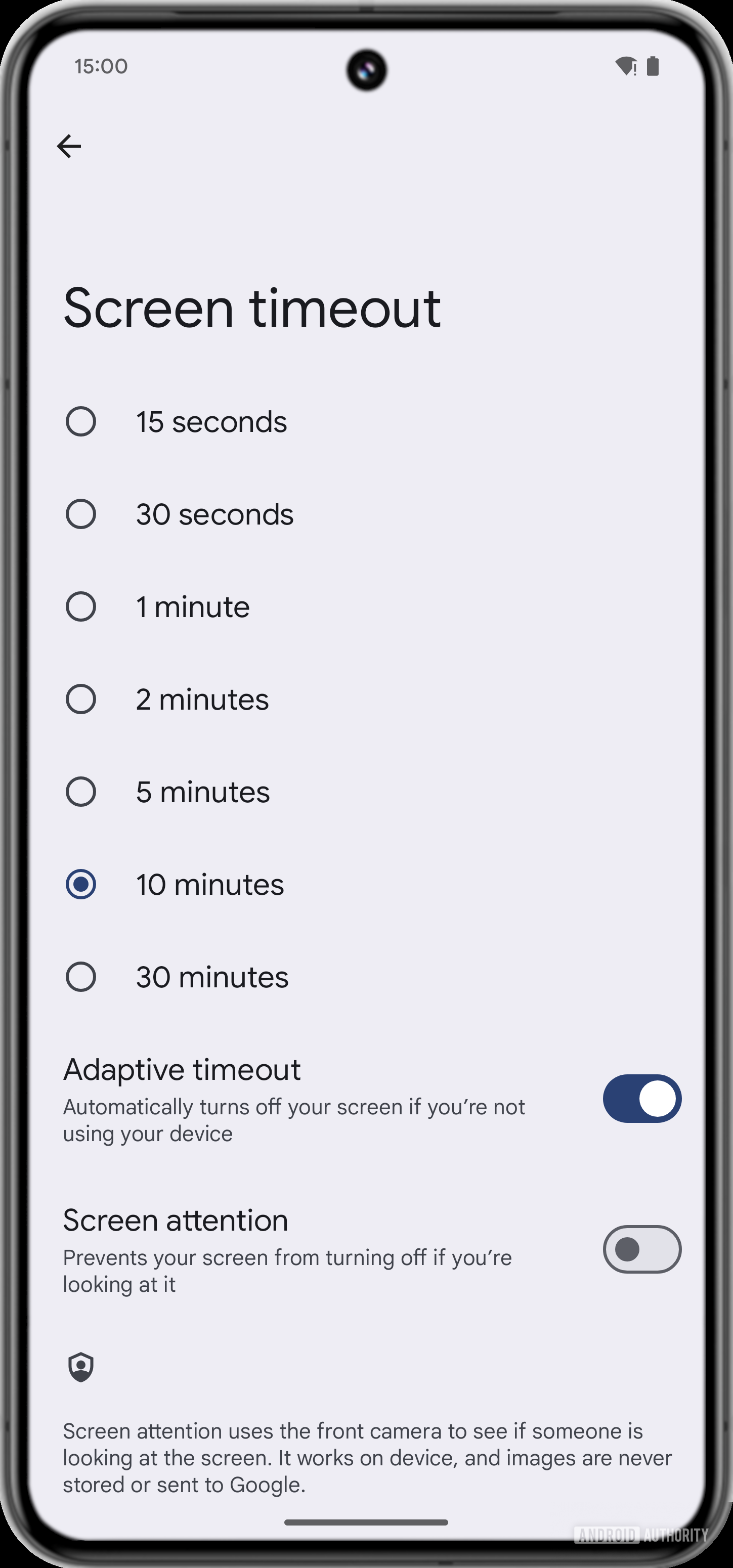
It is not immediately clear how the feature will be implemented. There’s a chance that this feature doesn’t make it to AOSP but gets reserved for Pixel UI.
Adaptive Touch for Pixel devices
Google could debut the Pixel 9 with Android 15 and a new Adaptive Touch setting for the display sensitivity. When Adaptive Touch is enabled, “touch sensitivity will automatically adjust to your environment, activities, and screen protector.”
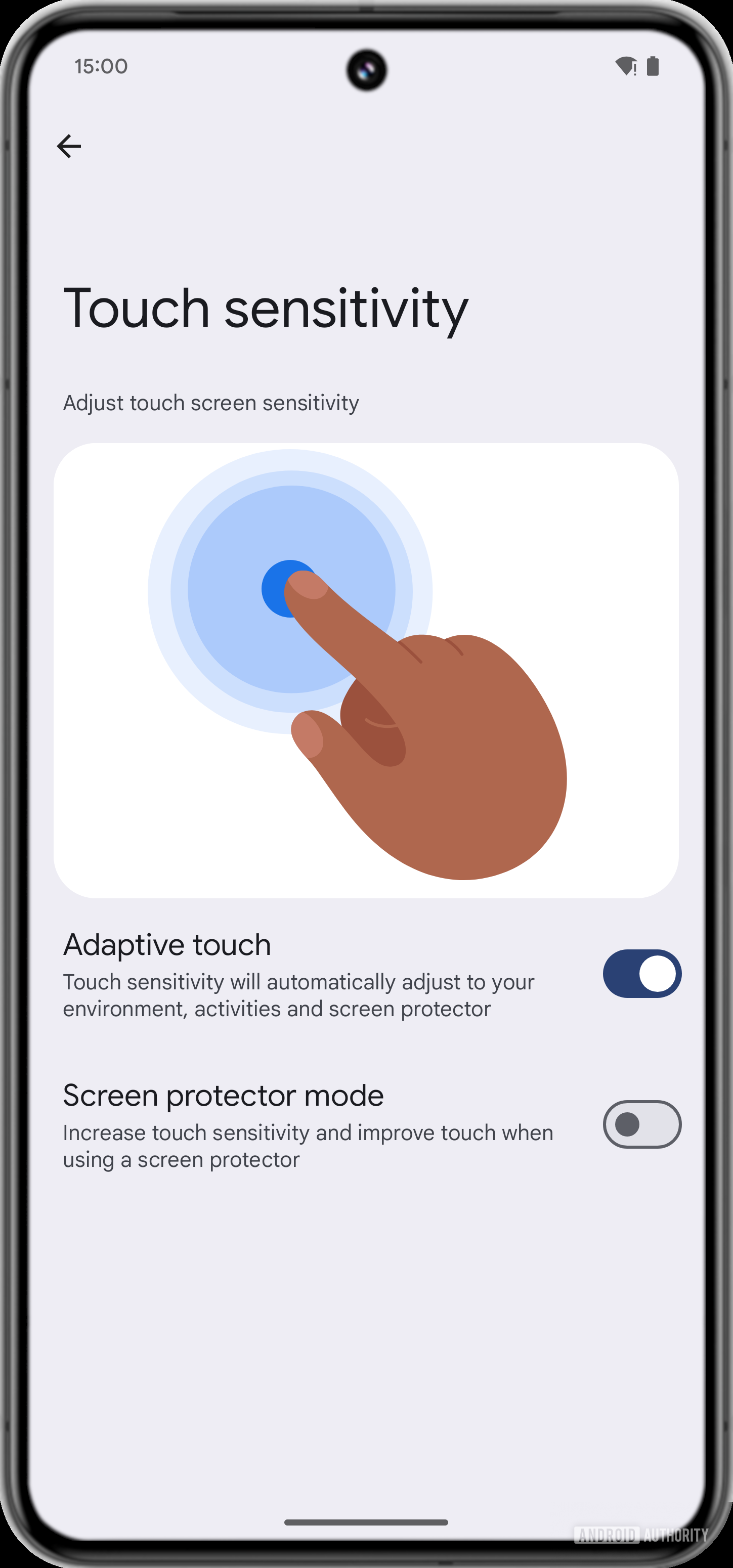
It’s not quite clear yet what environmental factors or activities will cause the touch sensitivity to be automatically adjusted, but it’s possible that wet fingers (or a wet screen) will be one factor.
We don’t know if Adaptive Touch will remain a Pixel 9 exclusive or trickle down to older devices.
“Even dimmer” display brightness
Android 15 could include an “even dimmer” display brightness option. As the name suggests, this setting toggle would allow your phone’s display to go dimmer than usual. This feature could work alongside adaptive brightness, going even dimmer than usual when the ambient lighting is super low but automatically returning to normal brightness when the ambient lighting is high.
This feature is likely going to replace the Extra Dim feature that users can toggle. The key difference between the two is that Even Dimmer is meant to be toggled and forgotten as the adaptive brightness will take care of the dimming, while Extra Dim is a manual toggle for going lower in brightness.
NFC wireless charging
Android 15 could introduce support for NFC wireless charging. NFC wireless charging works with significantly smaller antennas than Qi wireless charging. It is ideal for tiny smart devices like earbuds, styluses, smartwatches, and tracker tags, though the devices will need to feature an antenna that manages both communication and charging.
Hide unused notification channels by default
Notification channels are categories of notifications that an app can deliver. App developers can create channels for the various types of notifications that their app serves, and users can be selective about the channels they allow notifications from.
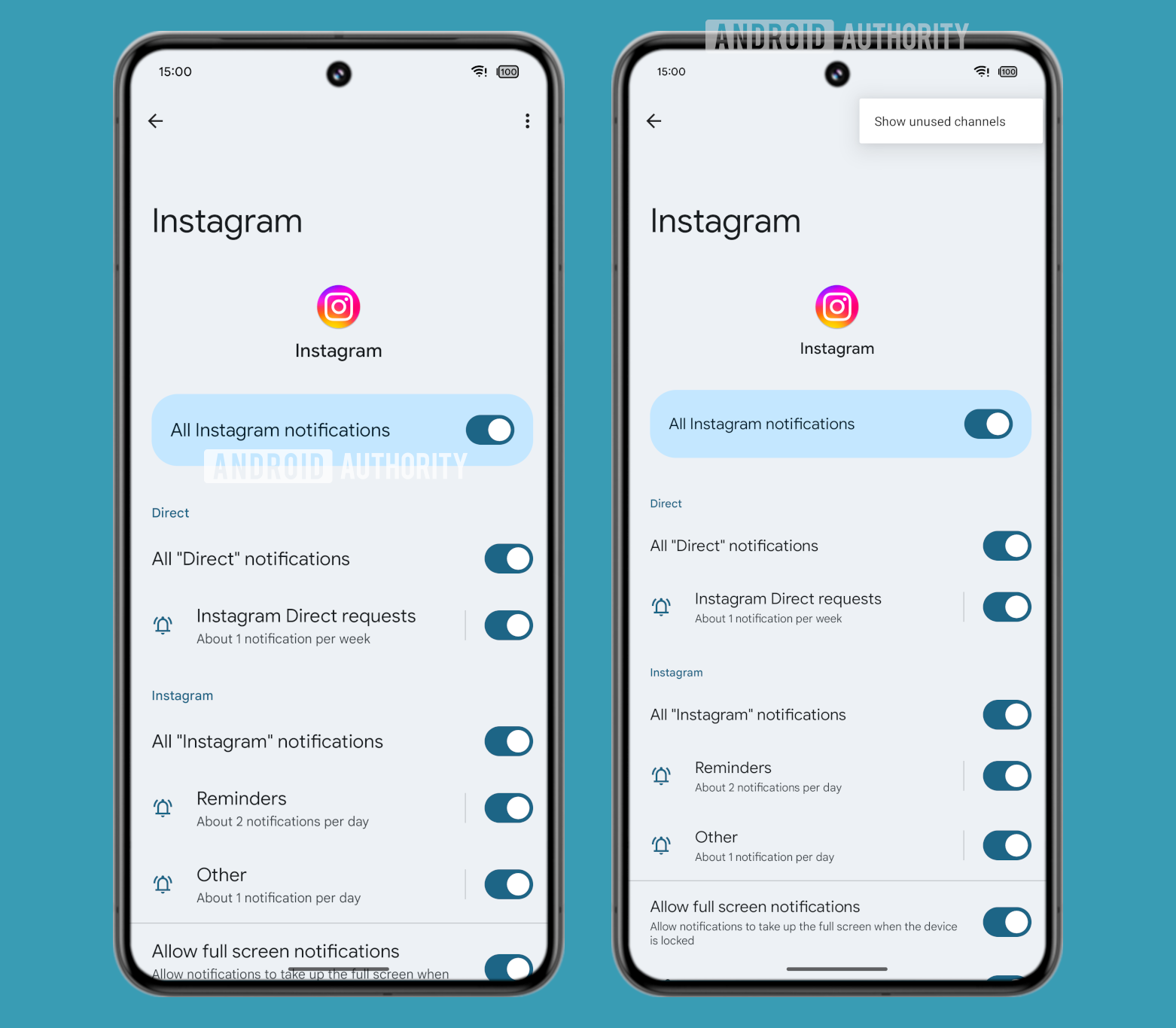
However, app developers can decide how many notification channels their app needs, and there are situations where they create too many channels. To combat this, Android 15 could hide unused notification channels by default. A three-dot menu button will house a new “show unused channels” option that you can use to showcase the unused channels.
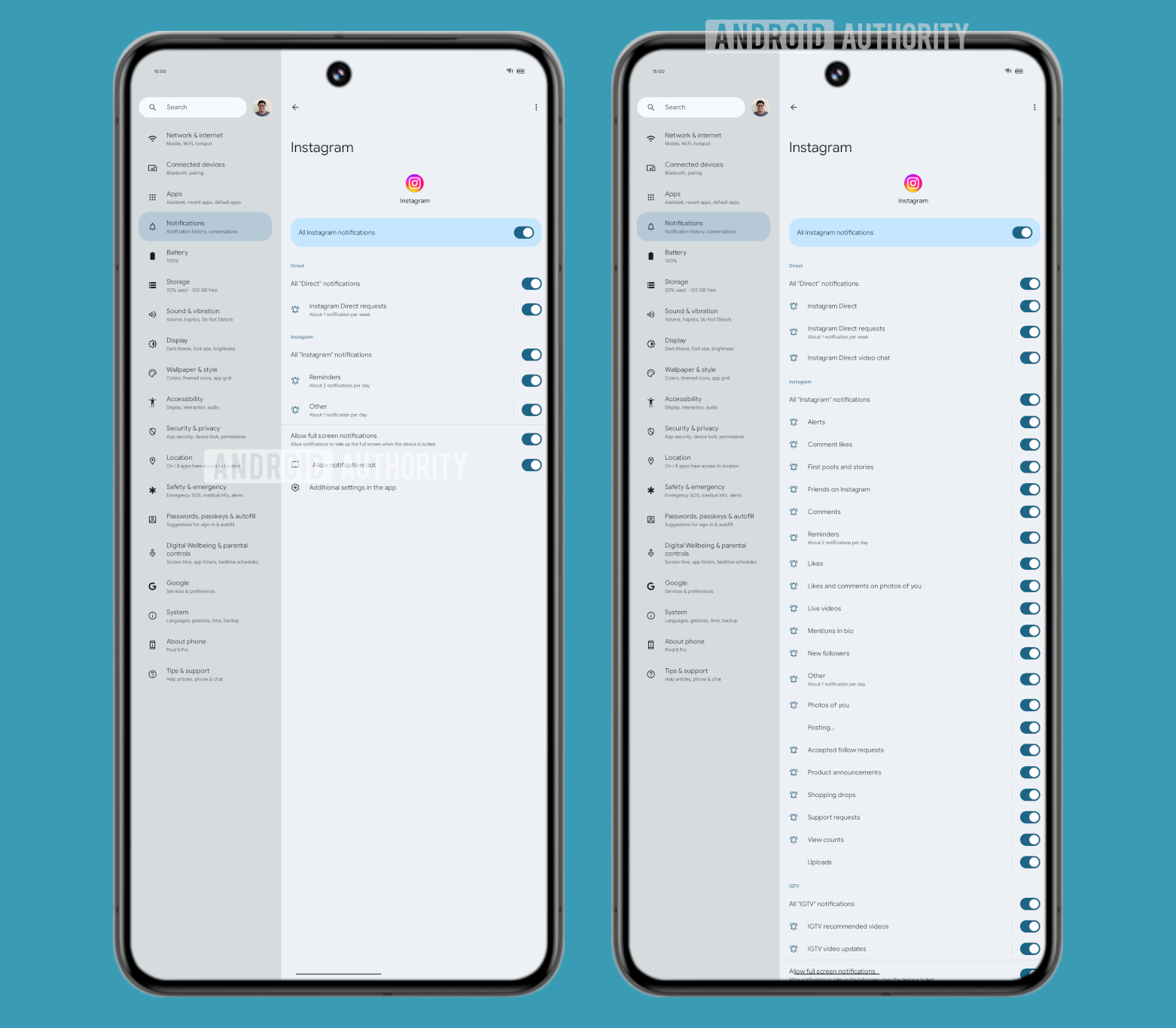
You can see how much cleaner figuring out notification channels gets when you hide the unused notification channels.
Selectively hide sensitive content when screensharing
In addition to letting apps know about screenshots, screen recordings, and screenshares and allowing partial screen recordings, Android 15 could also prevent apps from leaking sensitive information. There is a new feature internally called “sensitive content protection.” With this, apps that display sensitive information only occasionally can selectively block those fields from appearing in screen shares and recordings rather than disabling screenshots, screen shares, and recordings entirely.
Force apps to go dark mode
Android 10 introduced an “override force-dark” toggle under Settings > System > Developer options. Android 14’s QPR builds introduced a new (but hidden) “make all apps dark” toggle under Settings > Accessibility > Color and motion. This toggle works differently from the older toggle, and it remains present in Android 15 beta builds.
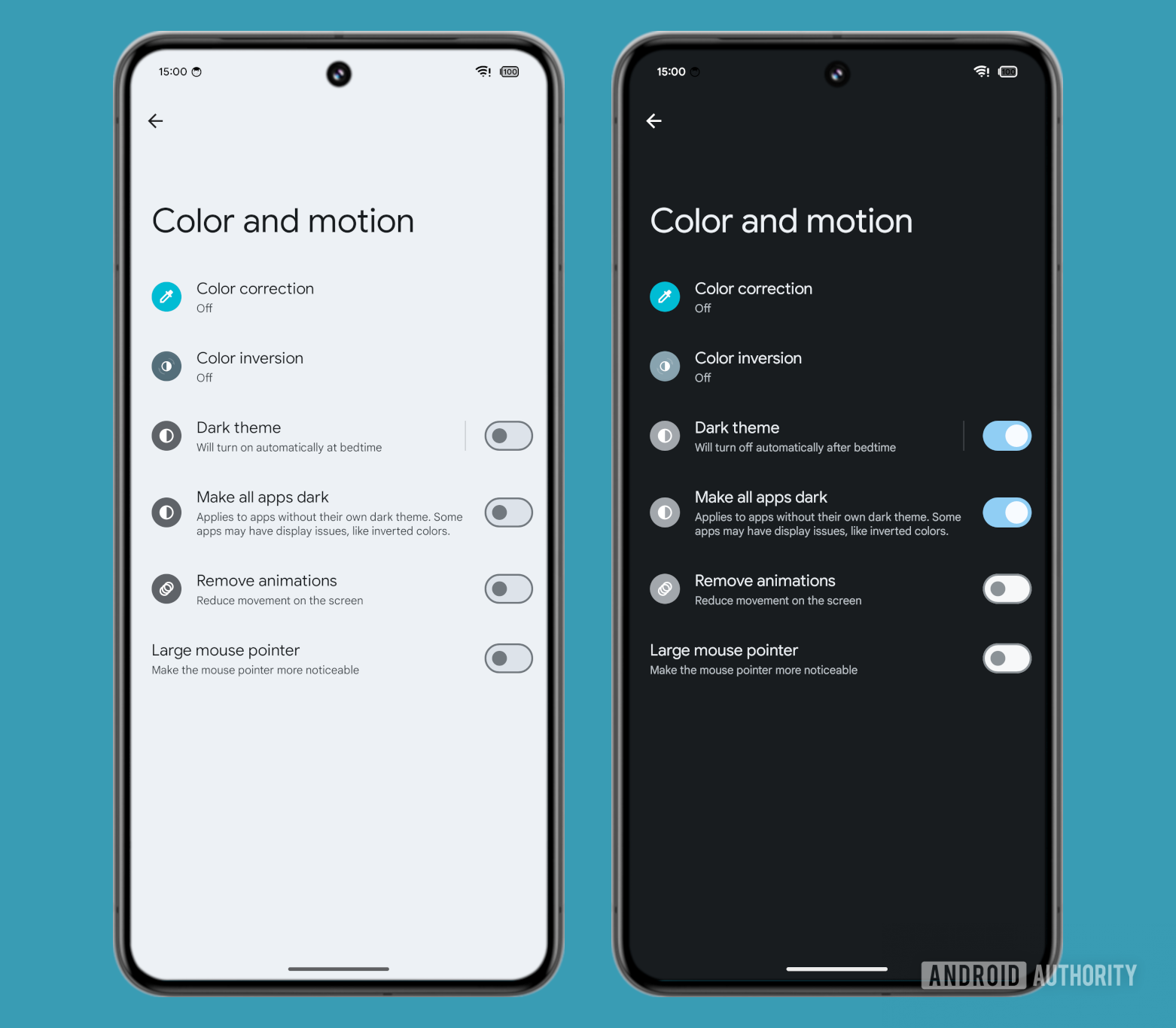
The older option was a developer-oriented feature, and apps could opt out of it just like many did. The newer option is an accessibility-oriented feature and is thus intended for consumers.
Here’s a gallery that compares the UI of several apps without a built-in dark theme in their original state, with dark mode plus “override force-dark” enabled, and with dark mode plus “make all apps dark” enabled.
As you can see, “make all apps dark” isn’t perfect, as it still reduces the contrast of certain buttons, but it does handle certain apps like Fitbit and Orangetheory much better than “override force-dark.”
Color correction slider
Android offers a dedicated page for color correction settings, present at Settings > Accessibility > Color and motion. Here, color-blind users can toggle one of Android’s several color correction modes, which each compensate for various degrees of color blindness. You can choose between the various color correction profiles to alter how your phone’s display displays the color to you.
With Android 15, your phone could also show a color correction intensity slider, letting you switch between low, medium, and high intensity of correction.

This will help tune the color balance changes for the active color correction mode.
Delete your biometrics if they aren’t working well
Android phones can be found across a variety of budgets, and one of the issues that prominently crop up because of this variety of hardware is that the Android OEM may have opted for a sub-optimal biometric sensor (fingerprint scanner or facial recognition system). Software updates also sometimes mess up success rates, and one of the most common recommendations to users to fix the poor performance of their biometric authentication system is to re-enroll their fingerprints or rescan their face.
Android 15 could proactively help users who are facing poorly performing biometrics by automatically detecting when your face or fingerprint models aren’t working well, deleting them, and then prompting you to set them up again. Android 15 will show a notification saying that your face or fingerprint model “wasn’t working well and was deleted. Set it up again to unlock your phone” with your face or fingerprint. Since Android only lets you enroll a single face, the notification that’s shown for re-enrolling your face will be slightly different than the one shown for re-enrolling your fingerprint, but there’s no functional difference.
Change the definition of fast charging from 7.5W to 20W
The way Android determines whether a charger is “slow,” “normal,” or “fast” is quite simple. Android, through the health HAL, receives information from the battery and charging circuitry, such as the current and voltage.
If the power (which is determined by multiplying current times voltage) that’s being delivered to the phone is below 5W, then the charger is considered “slow,” and the message “charging slowly” is shown on the lock screen. If the power is above 7.5W, then it’s considered “fast,” and the “charging rapidly” message is shown instead. If the power is between 5 and 7.5W, then the charger is seen as “normal,” and the lock screen simply says the phone is “charging.”
OEMs can configure these values for their phones, but Google hasn’t yet changed them for Pixels. The company could do that with Android 15, as there is a new fast-charging configuration that upgrades the charging rapidly status from 7.5W to 20W.
Changes to the Setup Wizard
As we spotted in an APK teardown, the Google Setup Wizard could soon present activation screens for Quick Share. Pixel users will also be able to set up Satellite messaging, car crash detection, and Moment.
Use Wear OS device to change the media output device
Starting with Android 15, companion apps for Wear OS devices can be granted a new platform permission called MEDIA_ROUTING_CONTROL. This permission allows “watches (via companion apps) to control the routing of applications running on the phone.”
In simpler terms, this permission allows the watch companion app on your phone to change which device to output audio to, even if that audio is coming from another app. Your Wear OS smartwatch may also need an update to add a screen that interfaces with the watch companion app on your phone, so some things are still in the air.
New Camera2 Extensions API: Eyes Free videography
All Android camera apps are built on top of Android’s Camera2 API, while the Camera2 Extensions API provides a way for camera apps to access extensions that OEMs have implemented on their devices.
As of Android 14, the Camera2 Extensions API supports the following five types of extensions:
- Auto: “adjusts the extension mode according to the current scene background”
- Bokeh: “sharpens the foreground subject and blurs the background”
- Face retouch: “touches up skin texture, under-eye tone, and more”
- HDR: “widens exposure range, resulting in more vivid photos”
- Night: “brightens photos in low-light situations”
The availability of these extensions varies by device and brand. All five extensions can only be used during image captures and previews, but not during video recordings.
Android 15 could introduce a new Eyes Free videography extension that can be used during video capture. According to its description in AOSP, this sixth Camera2 extension “aims to lock and stabilize a given region or object of interest.” This extension could let third-party apps that use the Camera2 API (like Snapchat) utilize this video stabilization algorithm.
The availability of the extension on your device will depend on the OEM, though. Even if OEMs don’t implement Android 15’s new Eyes Free videography extension, the operating system might deploy a software implementation that third-party camera apps can utilize.
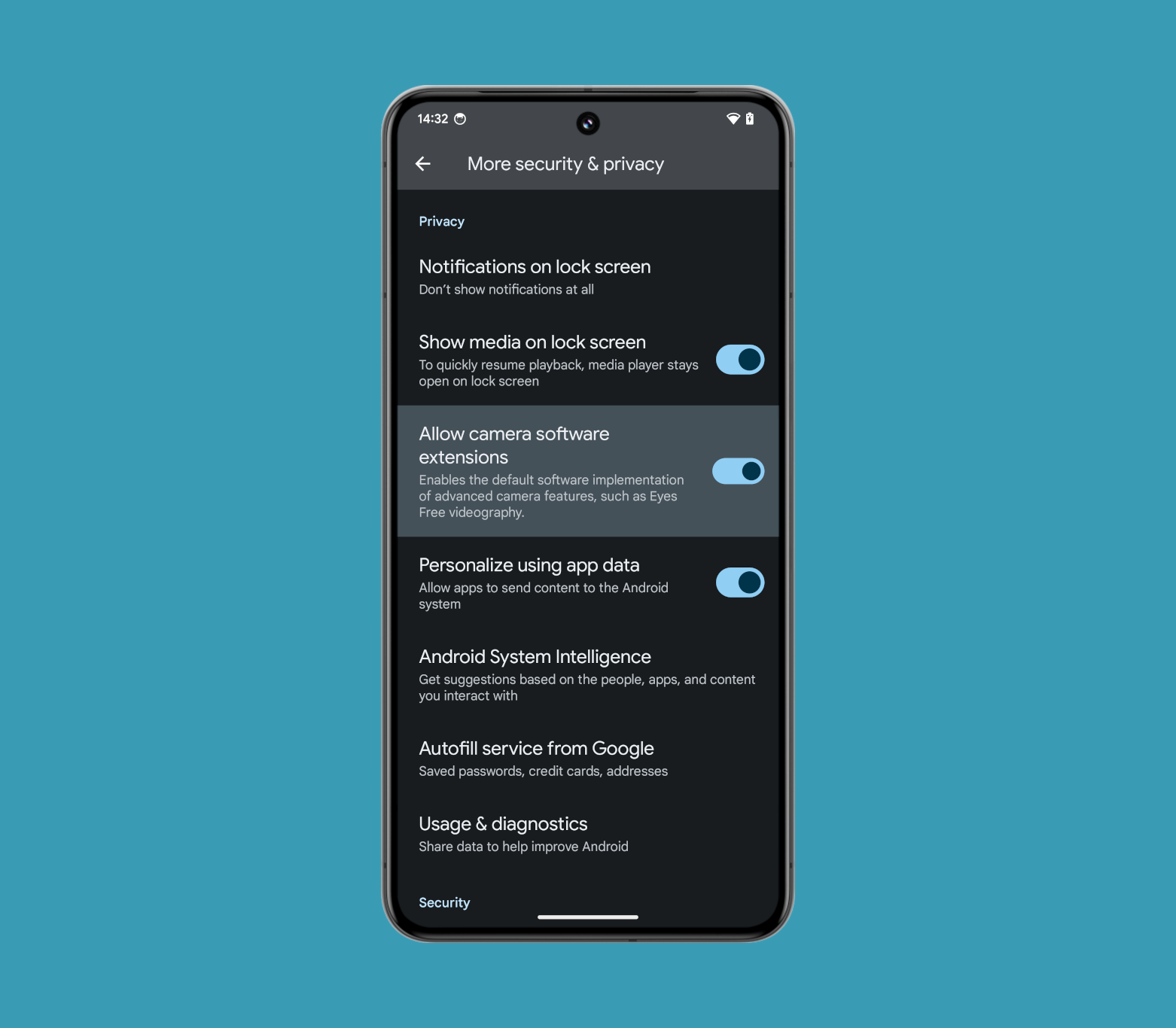
Under Settings > Security & privacy > More security & privacy, there is a new “allow camera software extensions” toggle that “enables the default software implementation of advanced camera features, such as Eyes Free videography.” While the Android default implementation of Eyes Free videography might not be as good as the OEM’s for a given device, it’ll still ensure this feature is made available to third-party camera apps that look for it.
Cloud search support for Android’s Photo Picker
During the second day of Google I/O 2024, Google confirmed that Android’s Photo Picker will support both local and cloud search. This is coming “later this year,” apparently, but we don’t know exactly when.
When search support rolls out, it’ll hopefully be available on all OS versions where the Photo Picker is available. The Photo Picker is available natively on all devices running Android 11 and newer through a Project Mainline module, but it’s also available on devices running Android 4.4 and newer thanks to Google Play Services.
Enhanced Confirmation Mode
Enhanced Confirmation Mode in Android 15 builds upon Android 13’s Restricted Settings feature. Enhanced Confirmation Mode checks an allowlist that’s preloaded in the factory image, exempting packages and installers mentioned therein as “trusted packages.” Trusted packages can, in turn, install apps that are eligible to be exempt from any restrictions on being granted Android’s Accessibility or Notification Listener services (which Android 13 marked as Restricted Settings).
This feature essentially closes a loophole that Android 13’s Restricted Settings brought about.
New screen magnification gesture
Android has a screen magnification feature that zooms in on the screen to make elements easier to see. It’s found under Settings > Accessibility > Magnification (at least on Pixel devices) and can be set up to magnify either the entire screen or a specific area of interest. You can activate it through three methods found under the “magnification shortcut” submenu: an on-screen accessibility button, a gesture that involves pressing and holding down both volume keys, and a gesture that involves quickly tapping the screen three times.
The first method is the most convenient but takes up part of the screen and always magnifies the center. The second method doesn’t take up space on-screen but has the longest activation time. The third method is really convenient and also lets you zoom in on the exact part of the screen you want to magnify, but it also slows down your device since Android has to add a delay to every screen tap.
Android 15 will introduce a fourth method to enable screen magnification. Users will be able to quickly tap the screen two times with two fingers to zoom in.
This toggle is shown above the collapsed-by-default “advanced” dropdown, which currently contains the “triple-tap screen” shortcut.
Google likely hid the triple-tap screen shortcut under a dropdown because it slows down other tap inputs, as mentioned before. Its description even warns that “this shortcut may slow down your device.” Interestingly, this text is missing from the description for the two-finger double-tap screen shortcut, suggesting it won’t slow down your device. However, in our brief testing, we noticed that there’s still a slight delay in screen taps when it’s enabled.
Thread network stack to connect to smart devices over Matter
If you own a smart home, chances are that you already know about Matter and Thread. Smart devices that can control other smart home devices need a Thread radio to communicate over Matter, but these Thread radios aren’t built into many devices yet, as opposed to Bluetooth and Wi-Fi.
Devices like the iPhone 15 Pro and Pro Max became the first smartphones to ship with an included Thread radio. Android devices will soon be joining the bandwagon with Android 15’s Thread network stack for Thread radio-included devices.
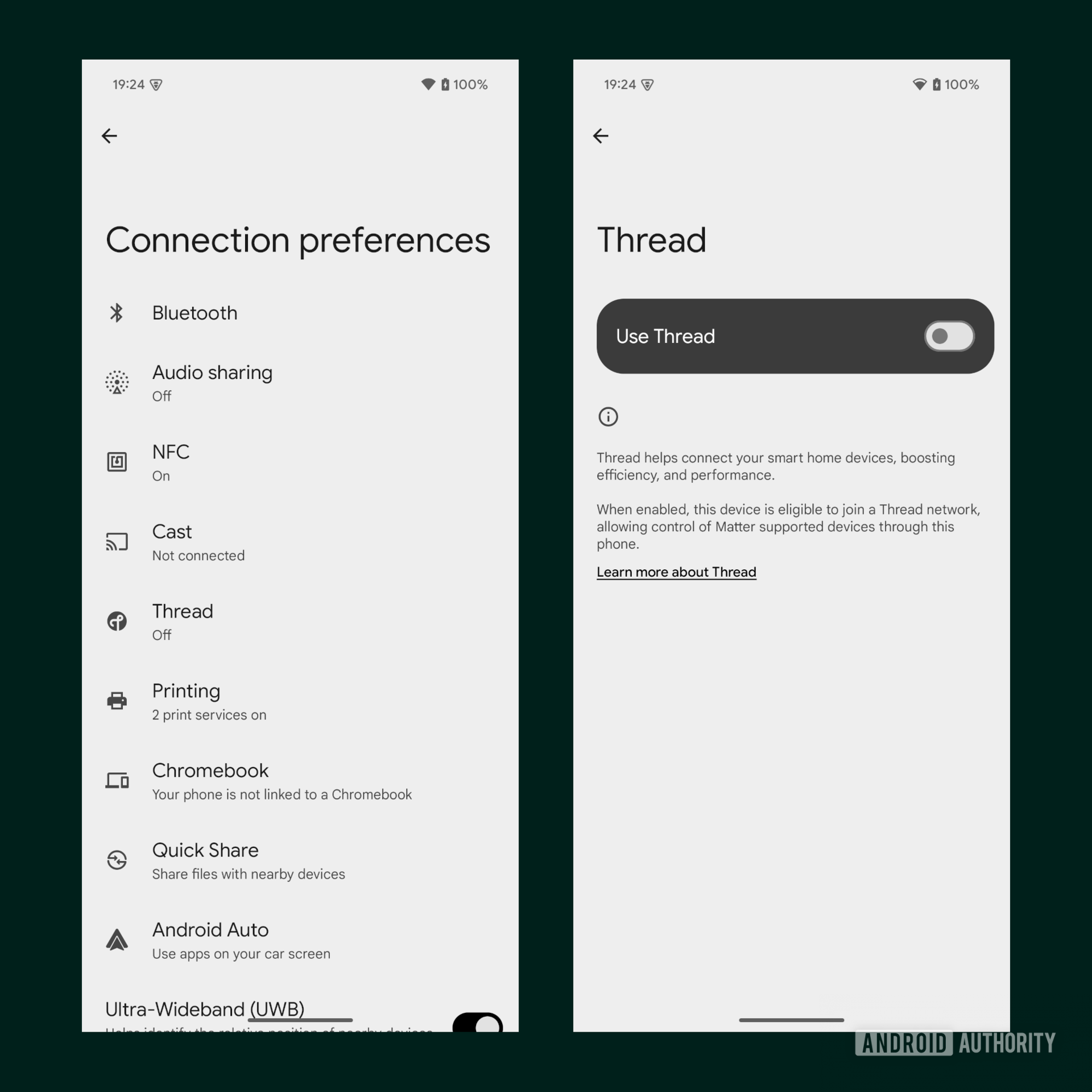
Phones running Android 15 that have a Thread radio, ship Android’s Thread network stack, and declare the feature flag indicating the device supports Thread will have a “Use Thread” toggle under Settings > Connected devices > Connection preferences > Thread.
Enabling Thread network support on a phone running Android 15 will allow that device to directly communicate with other Thread network devices, without the need for a separate Thread border router (like a Google TV device) to facilitate the communication. This could speed up certain smart home actions or even enable them to be run locally.
Opening up Bedtime Mode-related APIs to third-party apps
Google’s Digital Wellbeing app has a dedicated bedtime mode that silences your phones and changes various screen options to encourage you to stop using your phone based on a time-based trigger. Google is giving third-party apps access to the bedtime mode APIs with Android 15, giving them the ability to change distracting screen options and opening up an avenue for developers to let users create an even more custom bedtime mode routine.
With the release of Android 15 Developer Preview 2, Google introduced a new publicly available API called ZenDeviceEffects API that lets apps dim the wallpaper, minimize the display’s color saturation (i.e., go grayscale), suppress the ambient display, and toggle night mode (i.e., dark theme) when the app-created Do Not Disturb mode schedule goes into effect.
The benefit of Google making this API public is that users won’t be limited to using the company’s Digital Wellbeing app to manage these screen options at night. Users could, for example, create an even more custom bedtime mode routine through a third-party app, one that potentially triggers based on scanning an NFC tag instead of time, for example.
There’s a low chance that Google will scrap the API from Android 15 since it has been officially announced. However, since the APIs are not finalized, the company could tweak them before the stable release, as various features like changing dark mode aren’t working in the build.
Upcoming Health Connect changes
During the “What’s new in Android Health” session at Google I/O, Google revealed that Health Connect will soon add support for history reads. Apps can currently only read the past 30 days of data that other apps have contributed to Health Connect. Limiting apps to the past 30 days of data made it difficult to migrate your entire health data history from one app to another, so it’s good to see Google remove this limitation.
Another improvement to Health Connect is the ability for apps to do background reads. This enables apps to read data from Health Connect while they’re in the background. Currently, apps need to either run a foreground service (which requires showing a persistent notification) or wait for the user to open them before they can sync with Health Connect.
Google says that both the background reads and history reads capabilities are locked behind new permissions. The Health Connect app has added two new runtime permissions, one for background reads, and one for history reads, that the user needs to explicitly grant to apps. After granting approval, users can revoke access at any time through Health Connect’s settings.
These Health Connect updates are coming later this year. Google didn’t say exactly when, but we’ve already spotted evidence of these new permissions in the Health Connect app shipped in the Android 15 beta. It’s possible this update will roll out with the Android 15 release before being backported to Android 14 through a Google Play System Update and to earlier releases through an update to the Health Connect app on Google Play.
New Project Mainline module: WebViewBootstrap
Project Mainline is referred to as the biggest change to Android since Project Treble. The purpose of Project Mainline is for Google to wrest control of framework components and system applications that are critical to security and maintaining development consistency away from OEMs, thereby reducing the overall fragmentation in the OS. Project Mainline was introduced with Android 10, and we’ve seen Google add new modules with every Android release.
With Android 15, we could get a new Project Mainline module called WebViewBootstrap. According to a report, this module will handle the core framework APIs that Android uses to integrate WebView into apps. Google already handles the distribution of the core browser component of WebView through the Play Store but pushes the core framework APIs to AOSP for OEMs to pick up from. Switching from AOSP to a Project Mainline module will give Google the ability to update the core framework APIs without OEM intervention.
This new module could launch with Android 15 but could possibly be optional for OEMs to include in their builds. It could be made mandatory to include with Android 16 instead.
New Location Privacy HAL
Android 15 could include a new radio HAL API that allows for location privacy settings. This API will give the user some more control over how their carrier can request a network-initiated location request for non-emergency use cases.
Proactive alerts when using an insecure connection
Android 15 could warn you when a cellular network collects your device’s IMSI or IMEI, as well as when the network attempts to change the ciphering algorithm to create an insecure connection. Your device does need to support newer hardware APIs for this feature to function. The cellular transparency feature will present a notification that informs the user that their device’s IMSI or IMEI has been accessed, and users will be able to access it at Settings > Security & Privacy > More security & privacy. The page will also likely include a toggle to “require encryption,” which will disable null-ciphered connections at the modem level on supported devices.
That’s everything we know (and think we know) about Android 15 so far! Be sure to bookmark this page, as it will be updated often with new leaks and announcements.
Samsung Galaxy S25 series rumors and leaks: Everything we know so far
Update: August 19, 2024 (1:40 AM ET): We’ve updated our Galaxy S25 series rumor hub with a leak about the Galaxy S25 Ultra’s purported screen size.
Samsung’s Galaxy S24 series launched in the middle of January 2024, arriving a little earlier in the year than the last couple of generations. Along with it, the company introduced Galaxy AI, a titanium frame, new camera tricks, and a number of other features. But now that the Galaxy S24 launch has come and gone, it is time to start thinking about the next iteration in the series. How will the Galaxy S25 series set itself apart from its predecessor? What new features will Samsung come up with for the next generation? Will 2025 finally be the year we see a major shift in the Galaxy S design philosophy? Here, we’ll break down everything we know so far about the Galaxy S25.
Will there be a Samsung Galaxy S25?
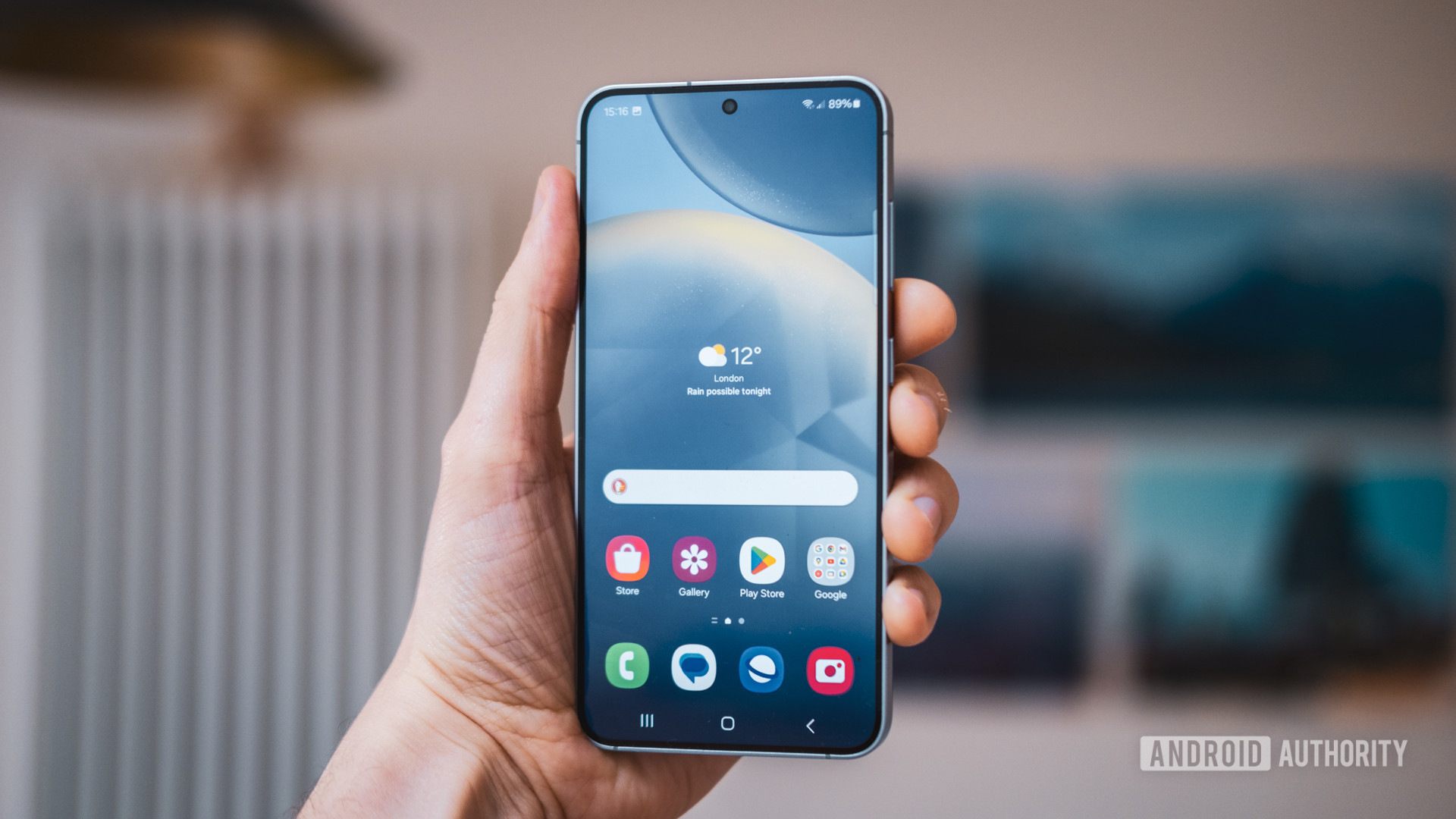
Samsung releases a new Galaxy S series phone on an annual cadence, and there’s no reason to believe it will stop at the Galaxy S24. But if that’s not enough to convince you, there have already been plenty of leaks and rumors about the incoming family of handsets that we’ll get into later on. Obviously, nothing is official until Samsung announces it. The company could always suddenly decide to shut down development, but that is extremely unlikely given how profitable its smartphones are. We would say it’s less of a question of whether Samsung will release a Galaxy S25 and more of a question of when it will launch in 2025.
What is the most likely Samsung Galaxy S25 release date?
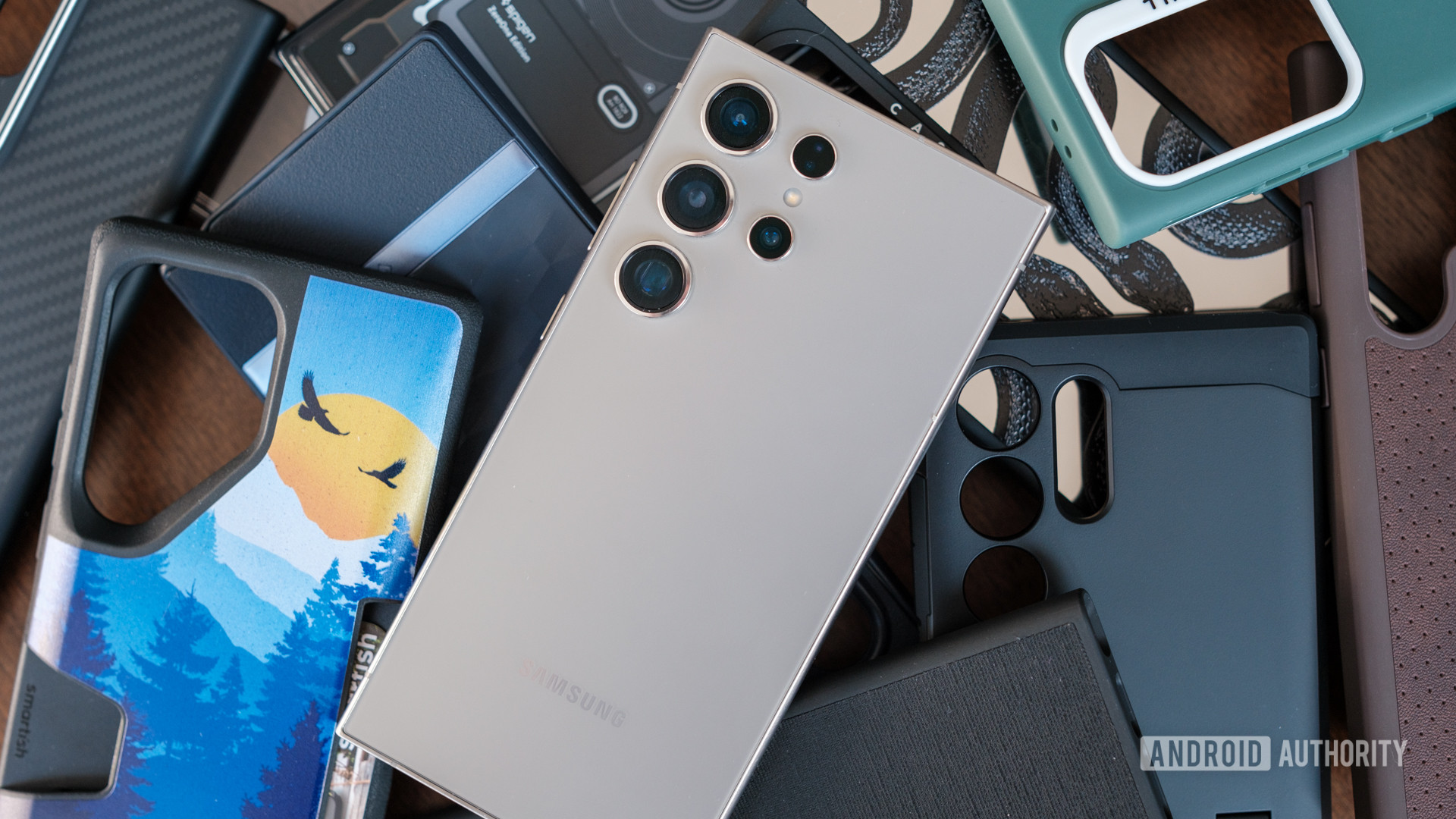
- Galaxy S22 — February 9, 2022
- Galaxy S23 — February 17, 2023
- Galaxy S24 — January 31, 2024
The Galaxy S24 lineup launched in January, so we’re still a fair distance away from the expected release of the Galaxy S25 series. As such, it will be a while before Samsung provides an official launch date for the device. As far as leaks and rumors are concerned, there’s not really anything on that front, either. Given the lack of information, we’ll need to speculate on what the date could be.
The South Korea-based firm usually launches its Galaxy S phones near the beginning of the year. For the last three years, the release date has fallen in the months of January and February. We assume Samsung will keep the same cadence for the Galaxy S25. Unfortunately, we’ll need to wait to find out the exact date.
What rumored specs and features could the Samsung Galaxy S25 have?

Even before the Galaxy S24 launched in January 2024, we were hearing rumors about the Galaxy S25. Now that it has been a while since the release of 2024’s Galaxy phones, the rumor mill for next year’s phones has picked up a lot of steam. These rumors and leaks span the gamut from the SoC to the design and more. Let’s take a moment to break down all of the available information.
Name
It stands to reason that the Galaxy S25 series will consist of the Galaxy S25, the Galaxy S25 Plus, and the Galaxy S25 Ultra. After all, Samsung has used this naming convention since the Galaxy S20 series.
Tipster Yogesh Brar made a rather interesting claim on August 16, though. The leaker claimed that Samsung could be thinking about a name change for the Plus and Ultra models. More specifically, Brar asserted that the Galaxy S25 Ultra could become the Galaxy S25 Note, while the S25 Plus could become the S25 Pro.
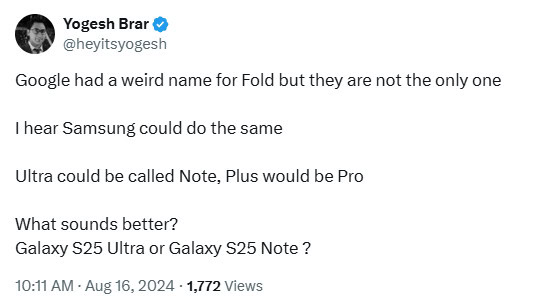
We’ve previously seen Apple offer the iPhone 15 Pro, which has more features than the iPhone 15 Plus. So we’re guessing an S25 Pro could be a more feature-packed offering than an S25 Plus. But this is just a rumor for now so you shouldn’t hold your breath for this change.
Design
The design of the Galaxy S series has hardly changed in the last few generations, but we might finally be in store for something a little different with the next iteration. Leaker Revegnus said that Ilhwan Lee, a former Mercedes-Benz designer, has been tasked with making the Galaxy brand feel “fresh” and that design changes are expected.
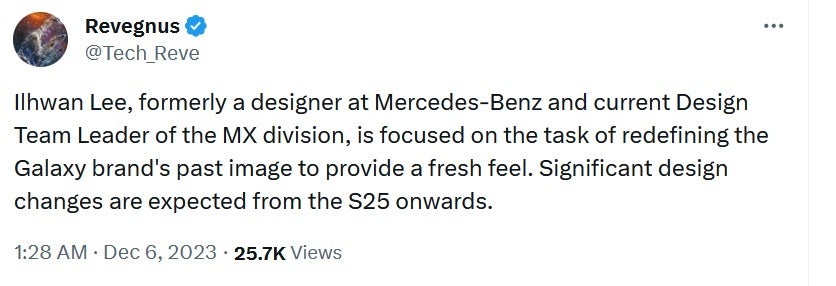
With the release of Samsung’s 2024 flagship devices, the company introduced titanium to the Galaxy S line, specifically for the Ultra model. There is reason to believe Samsung will continue to use the same metal in the Galaxy S25 Ultra. The question, however, is whether the firm sticks with the same type of titanium that appeared in the Galaxy S24 Ultra. It is also unknown if this build material will come to the regular and Plus models in 2025, though that seems unlikely.
In a now-deleted social post from PandaFlash (via Android Headlines), the tipster claimed, “I have doubts about the rumors of the Highest-Grade titanium in the Galaxy S25 Ultra.” In case you didn’t know, titanium comes in different grades. For example, Apple gave the iPhone 15 Pro series Grade 5 titanium, which is an alloy made of titanium, aluminum, and vanadium. The Galaxy S24 Ultra, on the other hand, uses Grade 2 titanium, which is all titanium. The difference is that Grade 2 titanium is softer, cheaper, and easier to work with than the Grade 5 version. If PandaFlash is correct, then it looks like the tech giant may stay on the same path.
Another rumor, this one originating from a now-deleted social post from PandaFlash (via Android Headlines), suggests Samsung is testing four prototypes for the Galaxy S25 Ultra. Although the tipster didn’t have renders of these prototypes, they did create mock-ups of what they thought the Ultra might look like based on their information:

According to the rumor, the main changes seem to revolve around the frame and bezels. We could see thinner bezels but the same frame as before, a thinner and flatter frame with slimmer bezels, thinner sides but a thicker top and bottom, or a thinner frame with rounded edges. Outside of that, it appears the front of the device will look mostly the same as the Galaxy S24 Ultra.
Leaker Ice Universe claimed in late June that the Galaxy S25 Ultra could gain a more rounded design, saying it would be “as round as the Galaxy Note 7.” The tipster also asserted that the Ultra phone will measure 8.4mm thick, making it thinner than all previous Galaxy S Ultra phones. Later on, the tipster claimed that the frame would be more rounded towards the back panel and straight on the display side. It’s said this design will make the frame thinner than the one on the Galaxy S24 Ultra and reduce the bezels on the sides.
Ice Universe would go on to post an apparent mock-up showing the front of the Galaxy S25 Ultra in August, and it indeed shows a phone with a more rounded design. The leaker also posted a mock-up comparing the S25 Ultra design to the boxier S24 Ultra design. Check out the images below.
Meanwhile, leaker Bennett Buhner claims that Samsung might increase the display size of the Galaxy S25 Ultra to something closer to 6.9 inches. This could mean that the device will be slightly bigger, but it could also just mean the screen has smaller bezels, giving it a slightly different aspect ratio.
Ice Universe posted the Galaxy S25 Ultra’s apparent screen size on Weibo on August 17, claiming it will have a 6.86-inch screen which “can be considered as 6.9 inches.”

The Ultra isn’t the only model rumored to see some design changes. Korean blogger yeux1122 has claimed on Naver that the base Galaxy S25’s screen size could grow by 0.16 inches, putting it at 6.36 inches. If this is true, it would be the second time in the last three generations that Samsung has increased the diagonal screen size of the base model.
Specs
One of the first pieces of information to leak about the S25 was the camera specs. Early rumors were very conflicted, with some claiming massive overhauls (such as going with a simple, triple-lens setup) and a big upgrade for the primary 200MP lens. However, as the year has gone on, most of those early rumors have been shot down. The most recent info points to a few upgrades for the Galaxy S25 Ultra, but not a complete overhaul.
Ice Universe posted a load of apparent Galaxy S25 Ultra camera specs on Weibo on May 27. They claimed that the Ultra phone would stick with a 200MP main camera and 50MP 5x periscope telephoto zoom but would switch to a 50MP 3x camera and a 50MP ultrawide lens. The 50MP 3x camera would be a big upgrade over the current 10MP 3x lens, which has been used since 2021’s S21 Ultra.
Later, leaker Sperandio4Tech posted info on sensor upgrades for those two upgraded lenses. Allegedly, the Galaxy S25 Ultra’s ultrawide lens could get “a new version of the 1/2.76-inch JN1 sensor.” Meanwhile, the 3x telephoto lens could get “a new 1/3-inch Isocell sensor.” These upgrades would be combined with the previously mentioned resolution upgrades to 50MP for both lenses.
The Galaxy S25 Ultra could offer upgraded 3x and ultrawide cameras, according to one significant leak.
On June 27, we finally got a closer look at what is likely to be the sensor for the Galaxy S25 and S25 Plus, as the company announced several new sensors, but it was the ISCOELL GNJ that caught our eye. The GNJ has a sensor that’s roughly on par with the main camera sensor in the S24 and S24 Plus at 1/1.57-inches, versus the 1/1.56-inch sensor found on the two S24 handsets. The new sensor also sports one-micron pixels, much like the sensor used on the S24 and S24 Plus.
Moving on to the display, not much is currently known about display specs outside of the rumor that the series could go bigger. However, Samsung has been working on next-generation OLED displays that would allow fingerprint scanning anywhere on the screen, as well as open up the ability to scan multiple fingerprints simultaneously. At the time, the CEO of Isorg, Dieter May, predicted that Samsung would be ready to deliver these displays by 2025.
Samsung itself made some promises regarding Galaxy S25 series upgrades during its Q2 2024 earnings call on August 1. Executive Daniel Araujo promised that the S25 series would get “top-of-the-line” camera and display upgrades, although he didn’t issue any specific details.
The Samsung representative also issued vague AI plans for the new phones:
So looking forward, we expect to be able to understand the context of conversations and provide a natural conversation and experience across our devices. To achieve this, we’ll strengthen partnerships and collaborations while developing our AI technologies further.
Some of the biggest Galaxy S25 rumors so far have related to the processors. Samsung brought back its tradition of offering the Galaxy S series with a Snapdragon processor in selected markets and an Exynos chip for the rest of the world with the S24. This was after the much-welcome shift in 2023 of abandoning Exynos and offering Snapdragon processors for all handsets around the world.
While a few previous rumors suggested Samsung might return to its all-Snapdragon-everywhere policy in 2025, a conflicting report says Samsung is hoping to improve its Exynos 2500 chip yields so it can once again offer multiple chip configurations depending on the market. Furthermore, at least one leak claims the company could also utilize a MediaTek Dimensity SoC for select models. This seems less likely and it’s important to mention the sourcing is a bit questionable with this one, so a grain of salt is necessary. Still, it seems likely Samsung isn’t happy paying Qualcomm’s high pricing for its chips and is actively looking for other options.
This means that every Galaxy S25 phone, regardless of location, would have a Snapdragon 8 Gen 4. This is reportedly due to Samsung’s manufacturing issues with the supposed Exynos 2500 chipset, which would appear in the Galaxy S25 series. As of now, this is the strongest rumor we have, so it’s looking likely we could see only Snapdragon-powered Galaxy S25 phones next year.
It's possible we could see a return to all-Snapdragon-powered Galaxy S25 phones in 2025.
If Samsung does go all-in on Snapdragon, it looks like the Galaxy S25 could get a nice speed boost. Tipster Digital Chat Station claims that “Tongzi” — supposedly the Snapdragon 8 Gen 4’s codename — chips will hit 4GHz. This would be a notable improvement from the Gen 3 processor, which is capable of reaching 3.3GHz.
On to battery specs, it’s possible Samsung could be planning to use stack technology for the battery in the S25 series, according to a report from The Elec. This tech is commonly used in electric vehicles, but it appears Samsung’s research and development department is considering bringing it over to smartphones. Stacking refers to the way cells in the battery are arranged, which can lead to a higher energy capacity inside a smaller volume. According to the report, the arrangement could provide a 10% improvement in energy density.
Meanwhile, a report from GalaxyClub says the standard Galaxy S25 could have the same 4,000mAh capacity as the Galaxy S24. This isn’t bad news, but it might be disappointing for anyone hoping to eke out a bit more juice from the Galaxy S25. As for the Galaxy S25 Ultra, tipster Digital Chat Station says to expect a 5,000mAh battery with 45W fast charging.
In a reply to a social post from Samsung, tipster Ice Universe claims that the base Galaxy S25 will once again have 8GB of RAM. Presumably, the leaker is suggesting that only 8GB of RAM will be available, regardless of the configuration. If true, this would mean the S25 will have the same amount of memory as Samsung gave the S24 and S23.
While it is possible we won’t see a change in the amount of memory, the storage story could be different. Samsung Semiconductor released a roadmap for the next generation of UFS. That roadmap states the company will release UFS 4.0 4-lane CS in 2025 before jumping to UFS 5.0 in 2027.
![]()
Based on the roadmap, UFS 4.0 4-lane CS will double the read/write rates of the current UFS 4.0 standard. The additional speed will provide a number of benefits, like faster load times and more efficient on-device AI applications.
What might the Samsung Galaxy S25 price be?
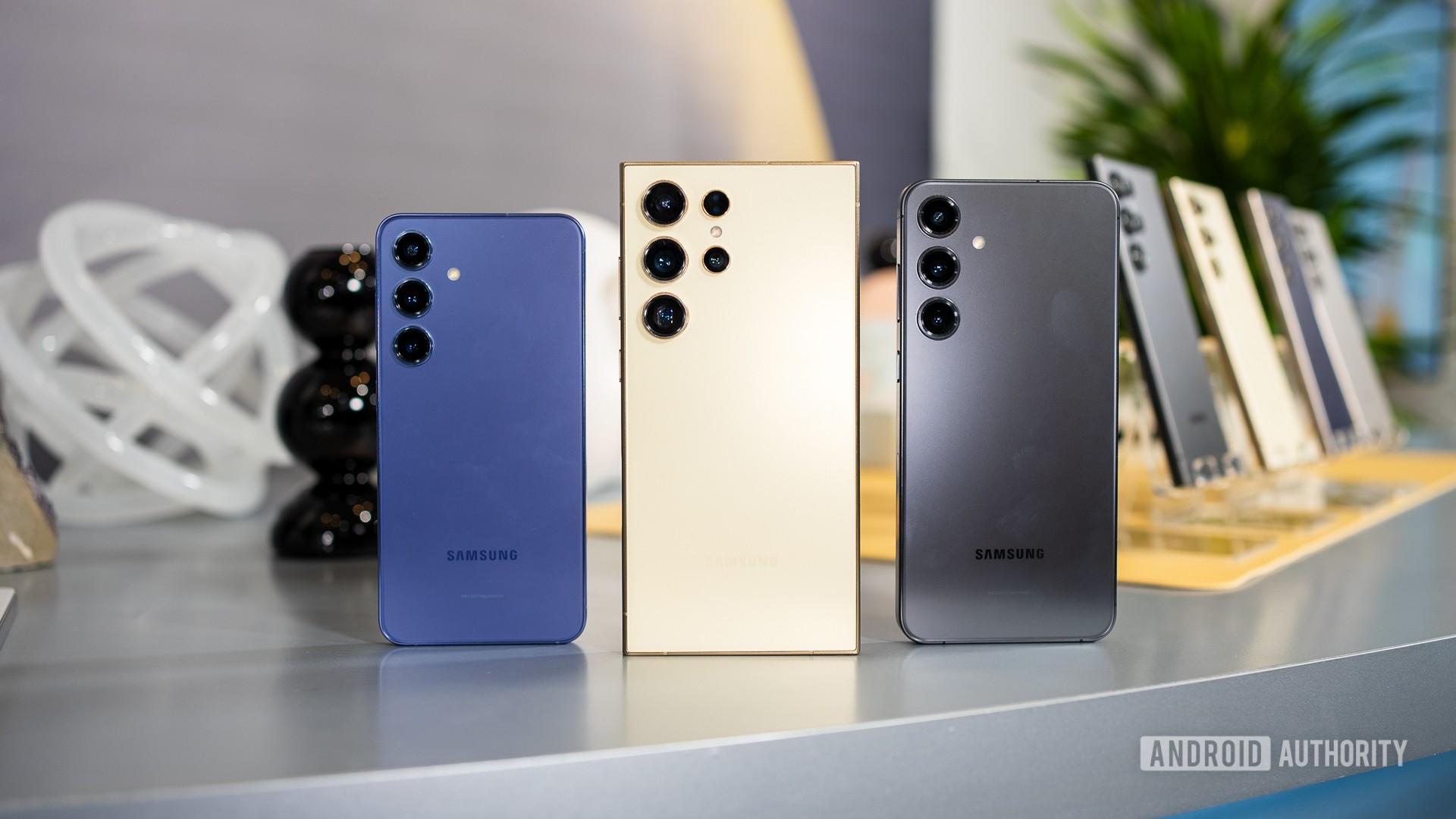
- Galaxy S22 — $799 (base), $999 (Plus), $1,199 (Ultra)
- Galaxy S23 — $799 (base), $999 (Plus), $1,199 (Ultra)
- Galaxy S24 — $799 (base), $999 (Plus), $1,299 (Ultra)
When it comes to pricing, Samsung has stayed fairly consistent over recent years. For the last three years, in fact, the base and Plus models have remained at $799 and $999, respectively. The only price change that happened during this time span was with the Ultra model, which went up by $100 in 2024. The good news is there’s not enough information to suggest there will be a price increase for any model. On the other hand, the bad news is that there’s also not enough information to suggest that Samsung won’t implement a price bump. If we had to guess, however, we believe the cost will be the same as it was in 2024.
Should you wait for the Samsung Galaxy S25?
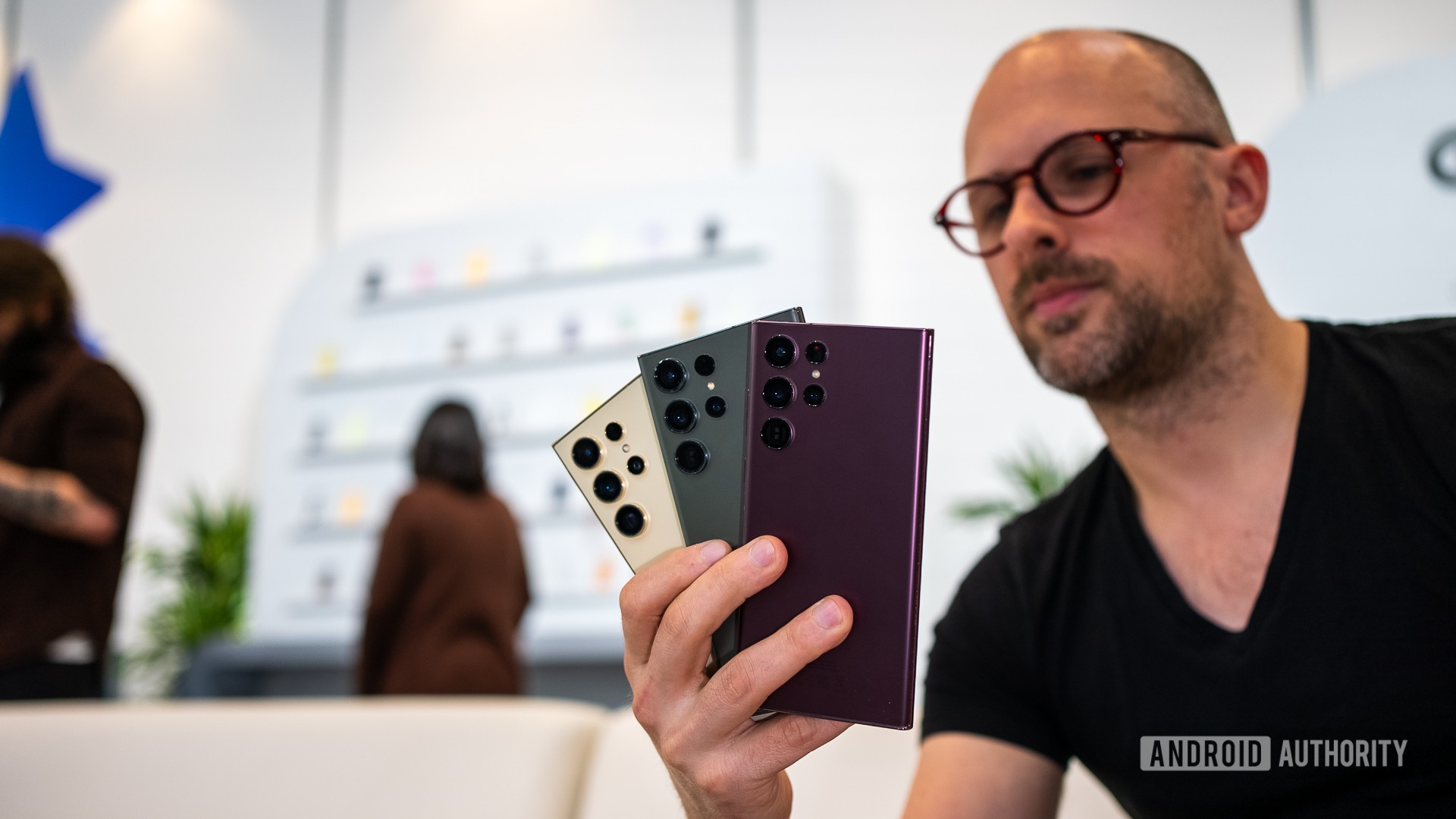
Unless you’re dead set on getting the latest and greatest from Samsung, there’s not really any reason to wait. The exception to that is if you’re not in immediate need of a new phone. In that case, it might be worth waiting to see how the Galaxy S25 series pans out.
If you need something now, Samsung’s Galaxy S24 (), Galaxy S24 Plus (), and Galaxy S24 Ultra () can likely serve all your needs. Likewise, you have your choice of perfectly capable non-Samsung handsets that range anywhere from premium to budget-tier and everything in between. For example, the Google Pixel 9 Pro () is a solid device that has great cameras and neat AI features powered by Gemini. There’s also the Nothing Phone 2 () if you want a flagship smartphone that won’t hurt your wallet.
